Google’s Crackdown On Employee Trips Is Another Blow To Business Travel Recovery
- Share to Facebook
- Share to Twitter
- Share to Linkedin
Business travel has not recovered as quickly as leisure travel.
G oogle has told its senior managers to limit employee travel only to "business critical" trips, according to a leaked internal email seen by The Information . No more team off-sites or social functions, and no more in-person meetings when a virtual option is available. Moving forward, Google's executives were told, there will be a "high bar" for what is now deemed critical.
Last month, Microsoft asked employees to cut back on business travel and company events in an effort to keep costs under control, The Wall Street Journal reported .
Taken on their own, these are simply tales of corporations trimming expenses during inflationary times. But viewed through a macro lens, Google’s new policy is emblematic of a travel trend that could pose a longer-term challenge to airlines.
All airline passengers are not created equal. Traditionally, business travelers not only flew more frequently but they paid higher fares, making an outsized contribution to airlines’ bottom lines.
But business travel hasn’t rebounded from the pandemic as robustly as leisure travel has, remaining as much as 35% below 2019 levels, according to some industry estimates.
On an earnings call in late July, Southwest Airlines’ chief commercial officer, Andrew Watterson, said that while business travel began picking up this spring, it skewed toward smaller businesses, government and education.
“Our largest corporates are the ones that are lagging — particularly banking, consulting and technology — who previously were among our top-tier travelers now are on the lower side,” he said, adding that Southwest’s biggest corporate accounts all have employees traveling, but not as many, and not as often.
Last month, a sobering report from the Global Business Travel Association (GBTA) bumped back its projections for a full recovery of business travel spending to 2026 — not 2024 as previously estimated — citing a raft of reasons including inflation, energy prices, supply chain challenges, labor shortages and regional developments.
The report found that total spending on global business travel reached $697 billion in 2021, just 5.5% above the pandemic-low of 2020. The GBTA predicts spending in 2022 to reach $933 billion, 34% above last year’s levels but only 65% of pre-pandemic levels.
“The factors impacting many industries around the world are also anticipated to impact global business travel recovery into 2025. The forecasted result is we’ll get close, but we won’t reach and exceed 2019’s pre-pandemic levels until 2026,” said Suzanne Neufang, CEO of the GBTA.

- Editorial Standards
- Reprints & Permissions
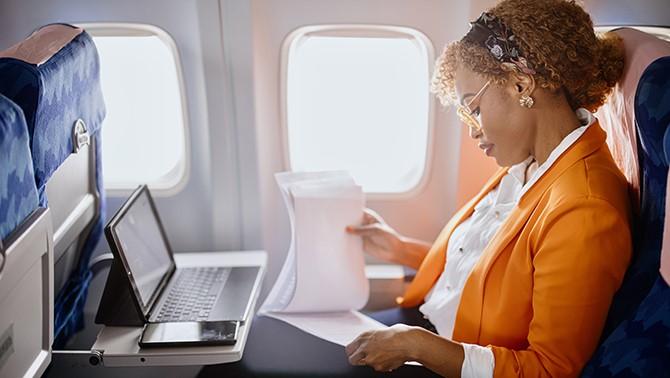

The complete guide to corporate travel policies
The business travel policy guide you’ve been waiting for .
Creating a business travel policy for employees can feel really daunting. You don’t want to just throw something together and hope for the best, but it feels impossible to anticipate every possible scenario. The truth is your policy serves as more than a rule book; it's a guide to better decision-making about your corporate travel program and can save you a world of headaches down the road.
Introduction
What is a travel policy .
- Why do you need a travel policy?
- How to create a travel policy
What to include in a travel policy
- Travel policy best practices
- How to promote travel policy compliance
- When to review and update your travel policy
- Final thoughts
When it comes to company travel, a travel policy brings it all to one place. It acts as an influencer for travelers to make the most cost-effective choices, an important visibility tool for your managers and HR department, and it protects your people if it’s done right.
If you’re new to business travel or haven’t looked at your travel policy in a while, we’ll start with the basics and then move into the nitty gritty of corporate travel policies. We’ll touch on a few best practices for writing a travel policy, what to include, and offer plenty of resources along the way.
Ready to get cracking? Let’s go!
A travel policy is a guide for business travelers to follow that outlines:
- How, where, and when to book
- Approved technology for travel management
- Preferred suppliers for air travel, land travel, and accommodations
- Approvals process for out-of-policy bookings
- Trip extensions and personal travel
- Expenses and what is covered or not covered
- Reimbursement processes
- Business travel insurance information
- Emergency procedures and contacts
Your company’s travel policy should reflect your company culture and values, be supportive of your travelers and their needs, and protect your company from unforeseen circumstances. It acts as a central document that guides your team to the processes of embarking on company business travel, from start to finish!
While you might hear a few grumbles and groans around the words “policy” or “process,” don’t worry! A travel policy does not need to be rigid and inflexible.
Do your travelers prefer to book on their own? Don’t take away their autonomy. They can still self-book, you’ll just provide them with a better tool and way to do it more efficiently.
Do your people feel prepared for any event that can cause a travel hiccup? With a travel policy, you can give them clarity and help them feel more prepared when traveling for business purposes.
Why do you need a travel policy?
Your travel policy is an extension of your travel program and company culture. It’s the glue that holds your travel program together – from approvals, expenses, booking processes, and emergency contacts.
Having a travel policy helps you:
- Control travel costs
- Determine how reimbursement works
- Compile a list of trusted and approved travel vendors
- Manage an employee’s travel experience and safety
- Cut rogue bookings – and simplify approvals
- Budget, report on travel expenses and activity and reconcile bookings
It’s a roadmap or guidebook that your travelers can reference when they’re booking their own travel if they run into a tricky situation abroad, and it helps provide clarity around processes.
As a company though, your travel policy helps centralize your travel program, makes data and tracking more accurate and easier to navigate, and it saves time and money (including on expense management). Plus, if you take the time to craft your policy in an intentional and inclusive way, you’ll have a policy your travelers are happier to follow.
How to create a travel policy for employees
- Determine business travel guidelines
- Create a travel policy that puts your people first
- Set reasonable budget limits
- Simplify the process of expense claims
- Adopt a user-friendly all-in-one travel platform
Once you’ve read through our tips, be sure to download our free travel policy template so you can get started on creating a travel policy of your own!
1) Determine corporate travel guidelines
When you take the time to create a policy that meets the needs of your business, you are making sure that your travelers are safe, costs are controlled, and you’ve made every business trip count.
Start by looking at what types of travel are allowed and the reason for each trip.
If you have team members traveling all over the globe, you might want to set some extra safety measures. You should also decide if there will be restrictions on the type of ground transportation used or where employees can stay.
Create a process for booking flights, hotels, and other ground transportation needs. How far in advance should they be booking? Do different rules apply based on the traveler’s position? Who is the point of contact for bookings and other travel questions?
Making sure to include your company’s travel insurance info is also important. Make sure to note if your policy covers medical expenses and/or any losses due to cancellations or delays in transportation services due to factors outside an employee’s control.
Do you have a policy for reporting and documenting expenses? This includes having a system in place for claims (like meal expenses) and a reimbursement process, so your team can easily get their money!
2) Create a travel policy that puts your people first
You’ve heard the term “duty of care” before, so it’s important to create a corporate travel policy that puts traveler safety and accessibility needs first. You’ll need to define and assign the roles and responsibilities of everyone involved, including a travel manager, if you have one.
Set up an emergency plan and provide access to traveler safety information. Determine who is the emergency contact (your TMC?) and how to get in touch. Do they have 24/7 emergency support available by phone or chat? What about email support?
Invite your HR department, the travelers themselves, and your DE&I manager into a discussion to find out what needs your team has as individuals, what hiccups they face when traveling, and what holes exist in your travel program that make it difficult to navigate.
Working with a TMC is a great way to ensure travelers are kept safe before and during their trip.
3) Set reasonable budget limits for business travel
You have a budget you need to adhere to, but is it realistic? Setting reasonable budget limits is key to an effective policy.
Your budget should account for all travel-related expenses, including airfare, accommodation, meals, and ground transportation. And once you’ve set your budget, you can determine reasonable costs for hotels and accommodation, ground transport, flights, and more. Build these caps into your travel booking software to help travelers stay within the set parameters, which will later help with accountability.
It's important to set clear rules on what the company can pay back and what types of expenses are out-of-pocket.
If you’ve set a maximum daily rate for meals on work trips, it's crucial that travelers understand the limit before racking up additional charges. Requiring receipts can also help keep track of employee spending and make sure they're not going over budget.
By working with a travel management company like Corporate Traveler, you can review your previous year’s expenses and find where you can optimize or make changes based on market changes.
4) Simplify the process of expense claims
If you're unfamiliar with how to write a travel expense policy, creating a simple process for claiming expenses is key to getting your team on the same page. Do you have access to a payment system that pays for the majority of expenses at the time of booking? This could be a good way to save time and stress down the road.
The more you can pay for before your travelers get to their destination, the easier everything is to reconcile after they get home.
If you have a person in charge of reviewing expense reports and watching pre-trip approvals, make sure to set criteria for claim approvals and look at automating processes to make approvals simple!
5) Adopt a user-friendly all-in-one travel platform
Finding the right corporate travel platform is essential. The right booking platform can provide travelers with an easy-to-use experience, giving them access to the best fares and availability.
For example, at Corporate Traveler, we use Melon . It’s a booking tool, reporting suite, travel policy pusher, traveler profile manager, and so much more. Melon features a “recommended spend” function, which helps keep travelers booking in policy. Hello, visual guilt!
Melon’s simple user interface, combined with dedicated travel consultants and expert 24/7 support, makes it simple to book, manage, and keep track of your business travel. You’ll be able to access Melon-exclusive deals and perks (alongside many negotiated contracts and online deals) and take care of all your travel needs from one place.
From the get-go, you’ll be able to work closely with our team to ensure that all of your needs are met. We'll help you customize your travel program to meet specific business needs, build your travel policy into the platform, and offer training to staff to help them along the way.
Putting it all together
Wow! You’ve reached the end and should have a better idea of how to write a corporate travel policy. High five! Now it’s time to put it all together and get it on paper.
Maybe you already have something in place that needs some work or an entire overhaul. Check out our easy-to-use template and start checking those boxes!
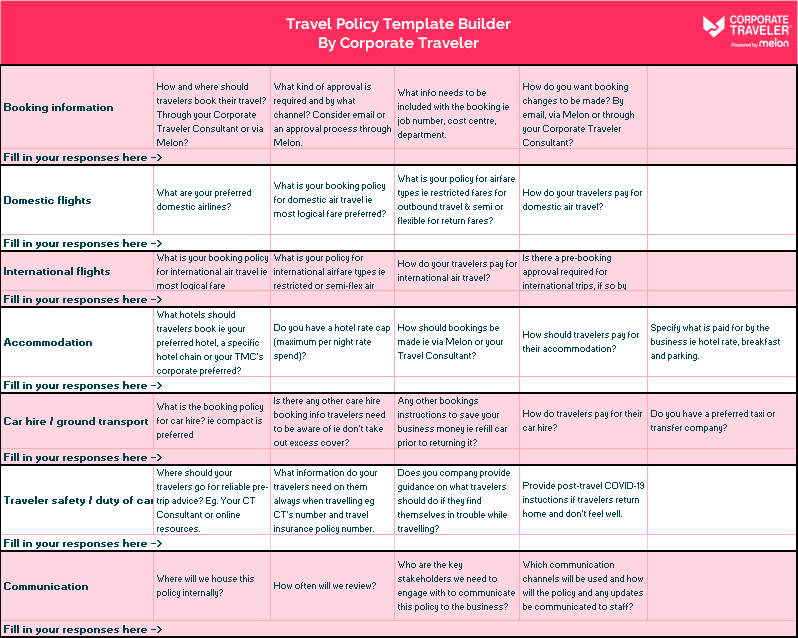
Grab our corporate travel policy template builder
Not sure where to start? No worries! We’ve got you. Here’s how to streamline your process with a travel policy template!
While there’s no one-size-fits-all travel policy for every company, following the set guidelines helps you nail a perfect-for-you policy that can see you through an ever-changing travel climate.
Travel policy template
When you’re crafting your business travel policy, there are so many considerations to be made. Things might come up that you never even thought of, but not to worry. We have loads of resources to help you see this through.
Starting out, it might be looking a little drab and wordy, but depending on your travel program size, a visual travel policy might be just what you need. You can search for examples online or take a look at an example of a visual travel policy we’ve created.
When building your policy, it’s important to include:
1. International or foreign travel policies
When you’ve got travelers all over the globe, you need to build out a policy for international or foreign travel. This is a protects them (and you) on anything from travel safety, to expenses, and everywhere in between.
Whether your travelers are individuals or entire teams, your international travel policy needs to cover:
- How and where to book – is that with a travel manager, online booking tool, a travel management company (TMC) ?
- Travel insurance coverages and contact info – international numbers and policy information
- Emergency contacts – how to reach them and the process of in-destination emergencies
- Travel expenses – limits and how to file for reimbursement
- Travel documentation – who to contact with questions
- Advance booking timelines – when should they be booking for international travel?
- Travel extensions – are these allowed and what are travelers expected to cover if they choose to extend their trip for leisure?
By outlining all of this information in your policy, you’ll streamline the process for your finance teams, travel managers, and your travelers. And really, who doesn’t want to make travel a smoother experience?
2. Corporate travel policy for business class travel
Does your corporate travel program have different rules, limits, or allowances for different levels of seniority? Are some junior members expected to travel in economy class, while some executives are allowed to book in business class?
If some certain exceptions and situations might allow for an employee to book business class, regardless of their position, you should include that in your policy as well.
Making this as clear as possible will avoid an approvals nightmare down the road.
3. Corporate meal allowance policy
It’s great if you’ve already centralized most of your business travel expenses like flights, accommodation, transportation, and car rentals, but your people gotta eat! It’s super important to include a meal allowance policy that clearly outlines which meals (and how much) you’ll cover.
Some of your team might be traveling with corporate credit cards, while others might need to be reimbursed. The guidelines and procedures for submitting expenses or asking for reimbursement need to be crystal clear!
Make sure to outline if you have a corporate travel policy for alcohol, too! You don’t want murky policies when it comes to footing the bill for drinks.
Some things to consider for your meal allowance and alcohol travel policy:
- Which meals are covered and for how much?
- Who is footing the bill for an alcoholic beverage with dinner?
- If entertaining clients, what is the budget, and how flexible is it?
- What is the process of submitting company card expenses?
- What is the process for requesting reimbursement?
Your team will always have questions about the policy on food and drinks, so make sure they can find the info easily and have a point of contact for whoever can offer more clarity.
4. Executive travel policy
We briefly touched on executive travel when we talked about traveling in business class, but there is certainly more to the top dogs traveling.
Executive travel can be a touchy subject if there are more lenient policies in place than there is for less senior team members. Your executives also may need to know the guidelines in place for their own travel, so they don’t accidently go overboard, which could be an accounting nightmare!
You’ll need to make sure you deliver a guide for approvals, procedures, booking deadlines, meals, accommodation, basically everything.
Lay it all out. Make your policy as digestible as possible, and for a busy exec, consider bullet points and titles in bold so they can easily skim to the areas they need to know.
5. Natural disaster or COVID-19 business travel policy
We can all agree that COVID-19 caused business travel to come to a screeching halt. Across most industries, the pandemic impacted client relationships, the ability to gain new clients and caused budgets to get slashed pretty dramatically.
While this was only one event, many businesses have begun to consider the “what-ifs” of their travel programs should another outbreak of COVID or something else happen. Crossing our fingers and toes doesn’t cut it, unfortunately.
There is also the chance of their travel being impacted by a natural disaster. We’ve seen it before – earthquakes, tsunamis, volcano eruptions, hurricanes. Do you have a plan or policy to aid your team and guide them through the unthinkable?
In 2022, we surveyed 120 employees across various industries and businesses. More than half, 51% of respondents said their companies didn’t provide resources or tips for safety on their trips. Duty of care isn’t something to put on the back burner, it’s your legal obligation to make sure your team is informed.
So, what’s the solution, you ask?
Working with a TMC gives you the backup you need if anything ever happens and you have people traveling abroad. At Corporate Traveler, our travel management software, Melon, is a central place to house your policy for quick and easy access. Plus, our travel experts can help you paint the big picture of what to do, who to call, and how to get your team home safely as quickly as possible.
Is there anything missing from your travel policy?
Let’s break it down. If you think of your policy like a sandwich, it should include:
The bread and butter
- Where and why: Are there any restrictions on who travels domestically or internationally? Or guidelines around reasons for travel?
- When: Are there any restrictions on when business travel is a no-no, like during an auditing period or financial downturn?
- How? How should travel arrangements be booked? Through your corporate travel booking software or with a preferred Travel Management Company (TMC)? How far in advance should domestic and international trips be booked?
- Preferred suppliers: Do you have preferred partners for air travel, accommodation, ground transport or travel insurance?
- Approvals: Who’s responsible for giving the green light on trips?
- Show me the money: What’s the process for managing/submitting expenses, paying for travel and reimbursements?
- Uh-oh: How will you prevent or deal with non-compliance to the travel policy?
- Noise level: Getting loads of ‘noise’ and questions about things in your policy? This means it’s not clear and it’s time to review why and where the stumbling block is for travelers (or your finance team!)
The filling
- Classy, baby: Who gets to fly business class, book 5-star properties or order UberLUX? And how does your business handle upgrades or airport lounge access for long-haul flights?
- All work, some play: What are the conditions if someone wants to extend their business trip to take personal leave? Are you happy for them to enjoy a bleisure trip, and if so, who foots the bill and for what?
- Loyalty: Are there any travel rewards or business loyalty programs that can be used during booking?
- Spending money: Do your business travelers have a daily allowance for meals, snacks, and drinks? How much is it, what does it include – and what’s not covered? Can they order room service, drink from the mini-bar, or use the in-house laundry service?
The not-so-secret sauce
- Safety first: your policy should support air, accommodation and ground transport suppliers that have been safety and security vetted. Guidelines or information on travel insurance for work trips is also helpful.
- Now what: What’s the plan of action in the case of Acts of God or Force Majeure events? Does your team know who to call for help?
- What’s next: Who is responsible for updating and reviewing your travel policy, and how often?
Corporate travel policy best practices
- Write for skim readers
- Guide travelers to the right resources
- Automate your policies
- Stipulate a timeframe for expense claims
- Be prepared for the unexpected
1. Write for skim readers
One of the first steps towards writing a people-first travel policy is understanding how your travelers will read it. And the truth is…
They probably won’t.
Research has shown that adults get distracted every 47 seconds . So if a business traveler is looking at your policy, they’re most likely just searching for a specific answer – and they want it fast. So what can you do?
First, make sure the document is easy to navigate. That means including things like:
- A table of contents
- Visual elements to help guide the eye toward crucial information, like flow charts and tables
- Clear headings and important details in bold
- Bulleted lists (see what we did here?)
And even though it’s a technical document, don’t make it sound like one. An effective travel policy should be clear, concise, and easily comprehended. So skip the long, complex sentence structures and technical jargon, and write in plain, simple English. It helps to pretend like you’re writing it so an eighth-grader can understand it.
2. Guide travelers to the right resources
Remember when we said travelers will only read your policy to find a solution for a specific need? Whether it’s a link, a phone number, or a step-by-step tutorial – a well-managed travel policy should provide them with the right resources.
Instead of treating a travel policy as a list of rules, treat it like a resource sheet. Here are some key pieces of information travelers might need to pull up easily:
Your approved online booking tool (and steps on how to use it)
- QR codes to download your mobile travel app
- Preferred airlines, including class, budgets, and other limits
- Permissible hotels, including guidelines on star-class and incidental expenses
- Guidelines on ground transportation (trains, ride-sharing services, rental cars, and personal car usage)
- How to get travel support
- Travel insurance carrier
- Clarification on the reimbursement process (more on this later)
You can also include other factors specific to your company, but this should at least be the necessary groundwork to help employees make the right choices on their own.
3. Automate your policies
Let’s face it: even with the best communication efforts, there’s always a chance that an employee may violate policy, even unintentionally. So, what can you do?
Build policy into booking.
By building your travel policy into your travel management software, it becomes unavoidably embedded in the booking process, so even the most easily confused employees end up following by default.
Automation tools can sound the alarm on out-of-policy bookings and even provide an audit trail. This can be especially helpful for employees who may struggle to remember procedures and policies, especially after big changes to your travel program.
4. Stipulate a timeframe for expense claims
No one wants to get stuck waiting on the money they’re owed – or worse – find out they’re not getting reimbursed for an expenditure they thought would be covered.
Having a clear and well-defined expense claim process is critical in any travel policy. Employees need to know how to claim their travel expenses, how soon they need to submit an expense report, and when to expect reimbursement.
The policy should also be clear about what expenses are and are not reimbursable, including any limits or exceptions. For example, if an employee needs to book a different seat class to accommodate a disability , the policy should include the process for requesting and approving this expense.
Plus, a submission deadline reduces cash flow issues and provides more accurate and complete expense data for that period (your finance team will thank you later).
5. Be prepared for the unexpected
As a company, you have a duty-of-care responsibility. When it comes to business trips, you need to be prepared for the unexpected. No matter how much effort you put into planning, there will always be a few hiccups along the way.
For instance, lost luggage, canceled or delayed flights, and sudden weather or political emergencies in unfamiliar destinations could all leave your employee stranded.
“Companies need to be prepared to plan for the particular, not just the universal. Every aspect of the travel program needs to be able to fit each of your travelers like a glove, from adaptable plans and experts on call, to technology that makes the journey seamless.” - Emese Graham, DE&I Manager @ FCTG
Don’t let unexpected situations blindside you. Have processes in place to ensure travel safety and security. Make sure they know what to do, where to go, and who to get a hold of if something goes wrong. Taking a proactive and prepared approach to your policy can minimize the impact of emergencies and take care of your team’s well-being while they’re on the road.
BONUS TIP: Update your policy regularly
Here’s a free business travel policy best practice just for you! It isn’t just a “one and done” deal – it’s a living document.
What’s that mean? As your company grows and travel conditions change, so should your travel policy. Revisit your expense policy at least once a year to keep it relevant and effective – and lead you towards new cost-saving solutions.
Data is going to be your best friend here. Here are a few key factors you should look into when updating your travel policy:
- Analyze travel spend patterns – are you throwing a lot of company money at certain suppliers? You might want to see if you can negotiate a new deal or find better rates elsewhere.
- Identify areas of overspending or inefficiency – are employees accruing high parking or travel costs? See if you can get season tickets or other accommodations.
- Evaluate the overall performance of your policy – are you still compliant with any new regulations that have come into play since the policy was established? How can traveler experience be improved?
You may even want to consider enlisting the help of professionals, such as a travel management company with experience in expense management, to give advice on how to optimize your travel policy to better meet the needs of your employees and your business as a whole.
Building a travel policy that's good for business and travelers and meets their needs is no small feat. But whether you're looking to retain your team, attract new talent, or make life a little easier for your travelers, investing in a well-designed travel policy is definitely worth the effort and great for company culture.
By following these travel policy best practices and ensuring your policy meets all travelers' needs, you’ll be on your way to smoother, safer, and more enjoyable travel experiences for all.
How to promote travel policy compliance
Whether compliance is a big or small issue in your company, it takes a little bit of investigating to figure out why it’s an issue at all.
Maybe your policy meets the needs of only a few of your team members. Maybe it’s too difficult to navigate your policy. Or maybe, your policy is written in legalese and makes your travelers vision blur before they go rogue and book how they want.
It could be that your travelers prefer a bit of freedom in booking and would rather do it on their own. Or, maybe they have specific needs that aren’t being met by the options provided.
Whatever their reasons, it’s your job to figure out why they aren’t following and what you can do to build better compliance.
Here are a few tips to improve travel policy compliance:
- Make your policy easy to navigate, understand, and find
- Use an online booking tool (OBT) for travelers who prefer to self-book
- Allow a bit of flexibility so travelers feel they have some autonomy
- Include a category for last-minute bookings so it doesn’t mess up your data
- Understand your traveler needs and build an inclusive policy

Read the full guide:
You've researched, gathered the necessary resources, and communicated your travel and expense (T&E) policy to your employees. But now, you're not so sure they're actually following it.
Read the full guide: How to Improve Corporate Travel Policy Compliance
When to review and update your travel policy
If the last time you reviewed or upgraded your travel policy was more than a year ago, it’s outdated and needs a refresher. If your company is small and has low turnover, you could probably get away with making small tweaks and optimizations.
But if you have a larger company with multiple departments and higher turnover, you probably need to do an overhaul and review it more regularly. We’re not saying you have to change it every time someone is hired or leaves the company, but making sure it’s relevant to the people who are there and are traveling matters!
Corporate Traveler conducted a survey in 2022, which showed that 48% of respondents didn’t know if their company had resources for specific traveler profiles, while 41% said their company didn’t provide resources for specific traveler profiles. This really goes to show that there’s room for improvement in how policies are built to support their people and their businesses.
A people-first travel program and policy have become necessary as the world grows and begins to understand neurodiversity, disabilities, and cultural differences. When we learn about our team members’ diverse needs, we can better understand how to support them when they venture abroad for our businesses.
GUIDE: Download the How to design a people-first travel program guide
We recommend policy reviews every 3-6 months, but at the minimum, once per year.
Final thoughts
Business travel is so unpredictable, as we’ve seen in recent years. There will always be circumstances you can’t avoid as a company, but making sure that you have the necessary checks and balances in place can help to make things just a little easier. If you have groups traveling, VIPS, or people heading to high-risk destinations, it’s important that your policy is relevant.
Don’t forget that travel policies shouldn’t be written and forgotten about – these are living documents that must be regularly updated to make sure they best protect your people.
Remember these best practices when writing your travel policy:
- Keep it simple and make it pop with visuals, bullet points, and bold headings.
- Answer any and every question possible – think of all the eventualities
- Always put your people first
- Implement a quick and simple approval process
- Automate as much as you can
- Use technology that’s supports your policy
- Be flexible with due reason
- Be clear about what’s not allowed
- Update your travel policy at least once a year
- Keep it somewhere easy to find
And finally, it doesn’t hurt to have a couple of different formats. Consider a visual version and an extended version so the message is delivered best depending on the person reading. For some, it might be easier to digest one over the other.
Looking for a policy review? We’d be happy to work with you.
Let’s chat .

- American Airlines
- British Airways
- United Airlines
- Google Flights
- Virgin Atlantic
- Swiss Airlines
Call us for the best deals
● Online 24/7

The Flights You Want for Much Less
Save 30-70% on Business and First Class flights. Any destination. Any airline.

Great experience! Easy booking process! I flew 3-4 times a year to Europe and I'm able to save quite a bit of money booking through these guys.
Timothy | CA , United States
Flight three
Flight four.
Children 2-11
Or call us for a faster quote: 1(888)302-0053
How does this work?
- 1 Request a FREE quote by completing the form above.
- 2 A friendly travel concierge will quicky find the best deals for you.
- 3 Book your flight and save up to 50% OFF retail prices.
Who should we send these deals to?
Why can't see my quote online?
All major airlines make us keep discounted fares offline. This means we are not allowed to display our fares online. Get a FREE quote, the savings are worth it!

How To Use Google Flights To Book Business Class Flights

There are so many options when it comes to booking a flight. Do you fly roundtrip or multi-city? Nonstop or layover? Delta or United? In economy or first class ? The questions are seemingly endless, making it a headache to find an ideal flight.
The good folks at Google felt the same way, so they worked their magic and produced Google Flights — one of the internet’s most powerful flight search engines.
Thanks to an easy-to-use platform, copious filter options, and lightning-quick results, Google Flights almost instantly became a hit with travelers.
But it’s not perfect. And there are some gaps in capability that you’ll need to work around, and we’ve got the guide on how to use Google Flights to find business class flights !
The Pros and Cons of Google Flights
Google used all of its search capabilities to put together Google Flights. As a result, the flight search engine is an excellent method of finding the lowest prices on the best flights. However, its functionality has some limitations, making it capable yet far from perfect. Here’s what you need to know before using Google Flights.
The Pros of Using Google Flights
Google uses a powerful ITA matrix to power its flight search engine, and that power leads to some beneficial features. These features make Google Flights a no-brainer over online travel agencies (OTAs) like Skyscanner. These pros include:
- Incredibly easy to use – Use the simple search bar or navigate using the map to find flights from departure airports near you.
- Excellent at finding the lowest prices by date – The price graph and date grid show what airfare looks like if your next trip has flexible dates.
- It’s free and fast – OTAs can’t keep up with Google Flights in finding flight prices. Plus, Google Flights lets you ditch the subscriptions to price alert emails from Orbitz or Expedia.
- Mobile device availability – Although there is no mobile app for Google Flights, the search engine still works through mobile phone browsers just as well as on a computer.
- Many filters to refine your search – Flight options are under your control, meaning you can search for the cheapest dates, preferred number of stops, and even carry-on luggage allowances.
The ability to select specific flights and not lose out on credit card reward miles give Google Flights a leg up on the competition. Although there are many excellent features, there are some that we wish Google Flights would incorporate.
The Cons of Using Google Flights
Planning a vacation can be challenging, especially considering lodging, transportation, and activities. Google Flights is powerful, but it has some drawbacks to consider, like:
- You can’t book flights directly through Google – After finding the perfect getaway, you need to hop over to the airline’s website to complete booking. That can make booking challenging if your flight has separate airlines for each leg.
- You can only search for flights – Google Flights is all about flight deals and doesn’t have the option to search for hotels or rental cars. You need to book those separately using other web pages.
- There’s no option to bundle – Because you can’t search for hotels and rental cars along with flights, there are no opportunities to bundle or package deals for better rates on all three.
- No coupons or discount codes – Unless you’re using reward miles, don’t expect a space for promo codes or coupons.
- Some airlines are absent – Discount carriers, like Southwest, don’t publish flight prices on Google Flights, meaning you’re missing some airline options.
To find the best prices on business and first-class flights, even last minute , the only help you need is Business Class Experts. Land up to 70% off flights to your favorite destinations in the Caribbean, Europe, and Asia.
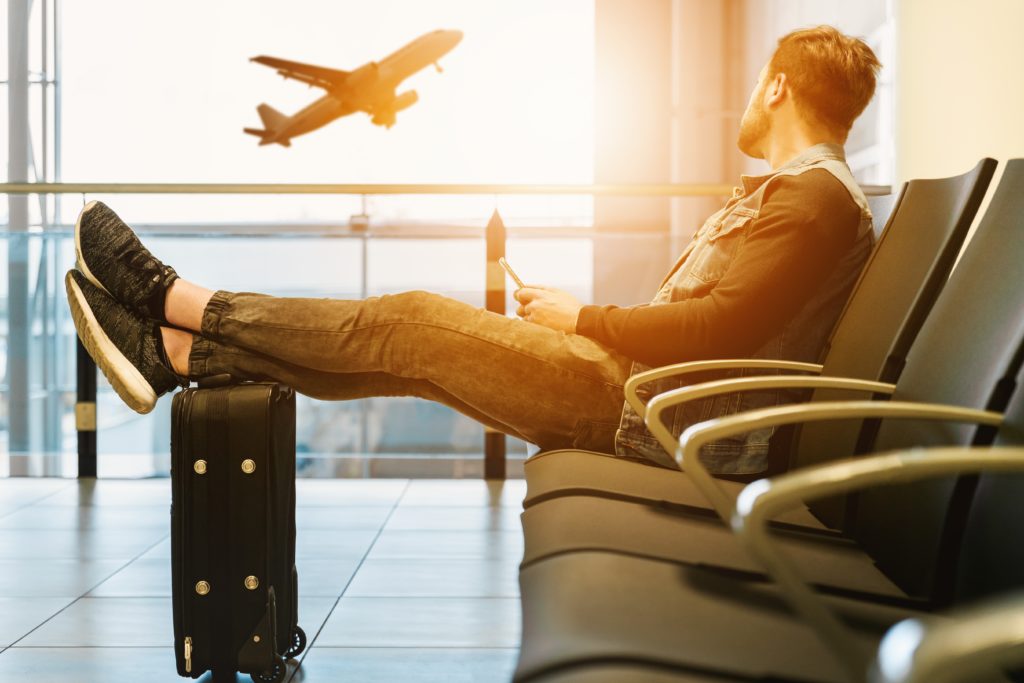
How to Use Google Flights
There’s no doubt that Google Flights is the fastest way to research flight deals. But you might have some questions about using Google Flights to find the best deals in business class. It’s all about research and maximizing the functionality to get the results you’re looking for. Here’s how:
1. Navigate to Google Flights
To get started with your flight search, head over to Google.com/flights. From here, you have the option to search using the standard options, or you can explore prices by location using the “explore destinations” button. You’ll see what airfare could look like from the nearest airport. This feature is perfect for narrowing down destinations by showing you the cheapest flights on trips within a flexible time period.
2. Select the Number of Passengers
The default search will include only one passenger, so you’ll want to adjust the number of travelers to get a complete picture of the cost. You’ll have the option to select the number of passengers based on age, such as adult, child, and infant, in lap or seat. Google Flights will update the information in real-time, so you don’t have to navigate to a new window!
3. Choose Your Preferred Airfare Type
Your next option will be to choose your airfare type. Here you can select economy, premium economy, business, or first class . You can also filter flights with layovers, desired airlines, or airline alliances to find the most comfortable flights!
4. Input Your Chosen Airports
Let’s say you’re flying from New York but don’t care if you fly from La Guardia or JFK. You can type “New York City,” and Google Flights will find the cheapest flight regardless of the departure airport. The same works for arrival airports as well. Or, if it does matter, you can select a specific airport to your desire.
5. Select Your Travel Dates
Everyone knows that prices change depending on the day of the week you travel. Google Flights makes it easy to see which days are the cheapest by providing a calendar view, date grid, and price graph showing how a specific flight’s price compares to other days.
6. Browse Prices
Using some of Google Flights’ other great features, you can further browse by price. For example, if you’re traveling through a multi-city route or you have a concern about your carbon footprint, you can find flights that match your requirements. Plus, you can toggle the “track prices” option to receive notifications about price drops. It is price tracking made easy!
7. Purchase Your Tickets
Unfortunately, to book flights using Google Flights, you have to book directly with the airline. That can be an inconvenience, but it means you can use airline rewards miles, select preferred seating locations , and even select meals pre-flight.
Eliminate the Search and Book with Business Class Experts
Google Flights is an excellent tool for researching flights to any location worldwide. The filter tools, number of airlines available, and ease of use make it one of the best ways to find cheap flights. However, there are some notable tools travelers wish were available, such as bundling options, hotel or rental car searches, and direct booking.
Despite its shortcomings, Google Flights remains the best way to research the best days to book. While you won’t find a better deal on economy class, you’ll need an expert to experience the best in air travel. Business Class Experts are the only way to find the best deals for premium airline cabins. Give us a call today, and see how affordable flying in comfort can actually be.
About the author

Anthony Cherkas
Started in 2009 as a dream of providing business class & first class travelers with better service, cheaper international ticket prices , and more value than any other discount business class company on the Internet.
About the post
Airlines , Google Flights
How To Use Momondo To Book Business Class Flights
How To Get 2 For 1 Business Class Flights
- Turkish Airlines
- Guide to Business Class Flights
- Business Class Flights to Europe
- Business Class Flight Deals
- Business Class Flight Consolidators
- First Class Flight Deals
- Last Minute Business Class Flight Deals
- 2-for-1 Business Class Flights
- Corporate Travel Deals
- Looking for Cheap Flights? Here’s What You Need To Know
- Business Class VS First Class
- How to upgrade to business class
- How to upgrade to first class
- Upgrade business class at airport
- Cost to upgrade to business class
- Business class flight deals
- first class flight deals
- EU Business class flights

(Owned and Operated by Cheap Biz Class Flights Inc CST# 2104091)
How to use Google Flights to find cheap flights and maximize your next travel booking

Google Flights is constantly evolving, and it's the one tool I always mention when people ask me how to find better flight prices.
This easy-to-use website can help you find the best possible price on airfare (and even hotels). It's one of the biggest weapons in our arsenal at TPG to help save money on travel. While TPG does offer deal alerts , if you are looking for a particular flight, destination, airline or routing, Google Flights is the way to find personalized deals.
Google Flights is where I almost always begin my search for new bookings. I come back to it again and again to book trips, see if prices have dropped and check if I can get a better deal.
Here's everything you need to know to use and master Google Flights.
What is Google Flights?
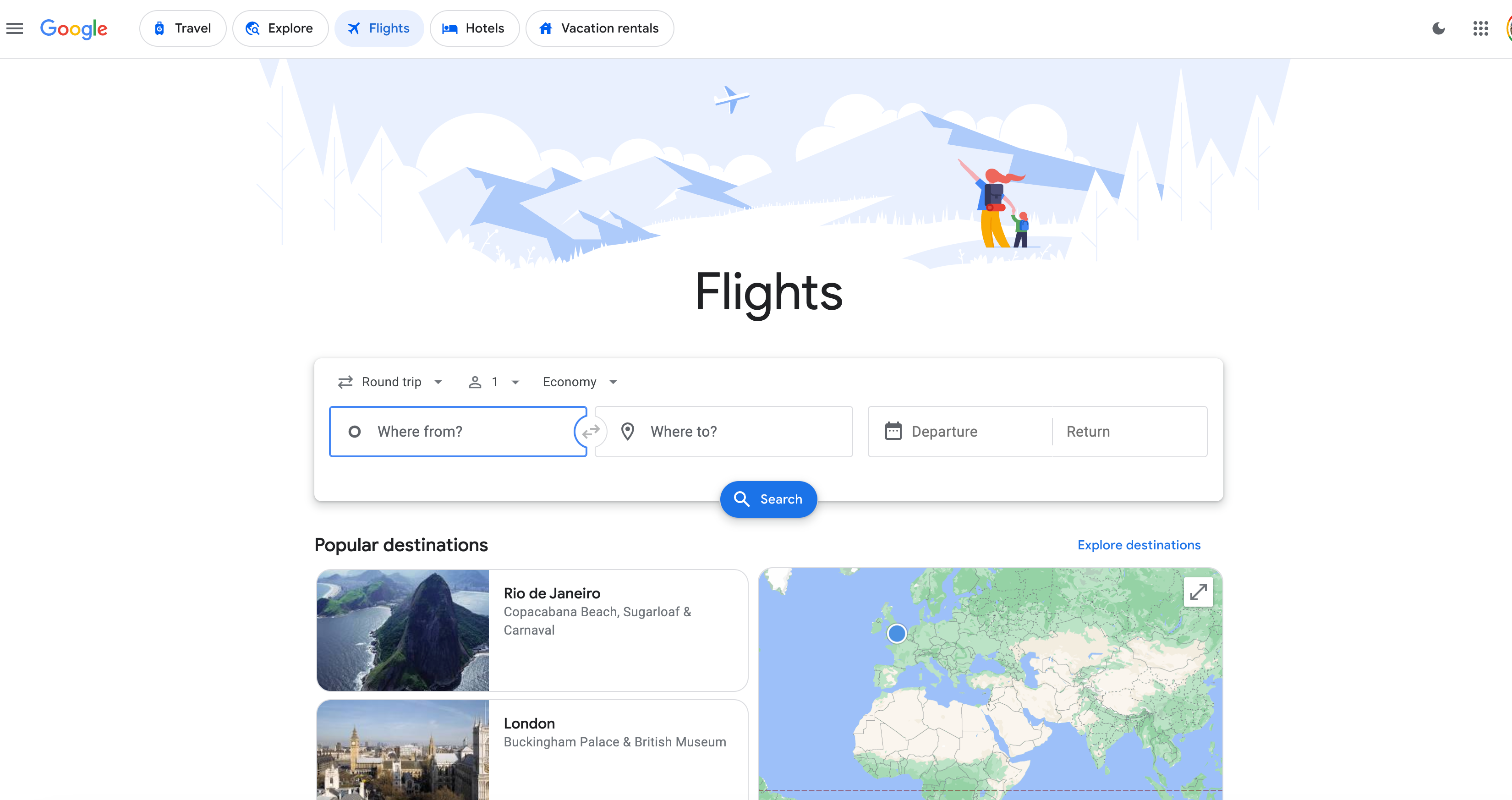
Google Flights is one of our favorite tools for finding deals on flights. It's an amazingly powerful flight search engine, and the best part is that it's easy to use. Google shows you nearly all available flights for a given search but doesn't force you to book with it.
Unlike Expedia, Orbitz, Tripadvisor or Kayak, it's not an online travel agency. Google is simply showing you what's available. Once you find the flights you like, you "click through" to actually book. You can choose to book directly with the airline or via a third-party OTA, but not Google itself.
One frustrating note is that Google Flights does not show Southwest Airlines flights, so keep that in mind as you search.
What's new at Google Flights?
Google has introduced new features that suggest when prices are historically lowest and when you should book for maximum savings. Google has always shown whether the price for a suggested flight itinerary is typical, low or high, but now it gives you even more data to consider.
The tool will "let travelers know when airfares are expected to be lowest for booking their chosen dates and destination," according to Craig Ewer, who works in communications at Google.
For example, when I searched last year, Google showed me that a flight from New York to San Francisco in October was $93 cheaper than usual, and the typical range is between $245 and $415. In other words, it was a good time to book.
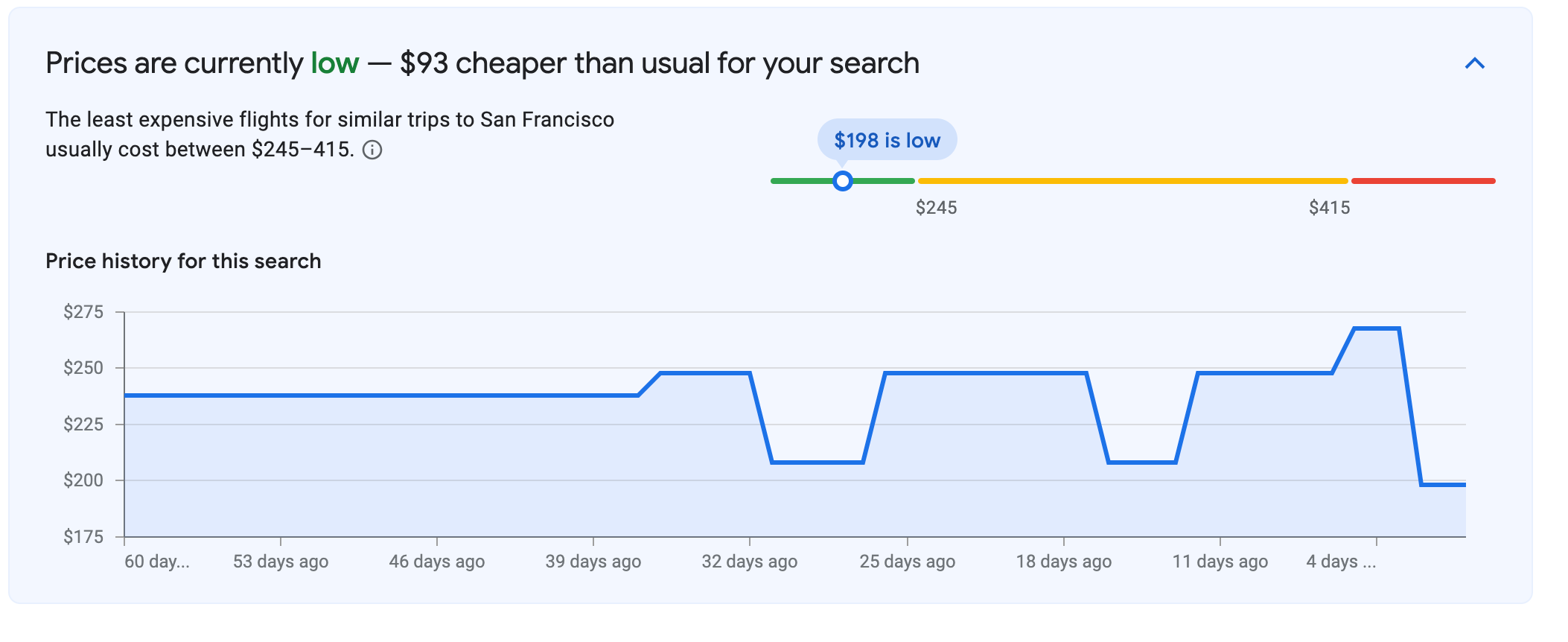
It gets even better: In some situations, Google will suggest alternate dates you should actually book the flight to save a few bucks. The example below shows that a December flight to Miami would have been much cheaper if I had waited to book it until Sept. 13.
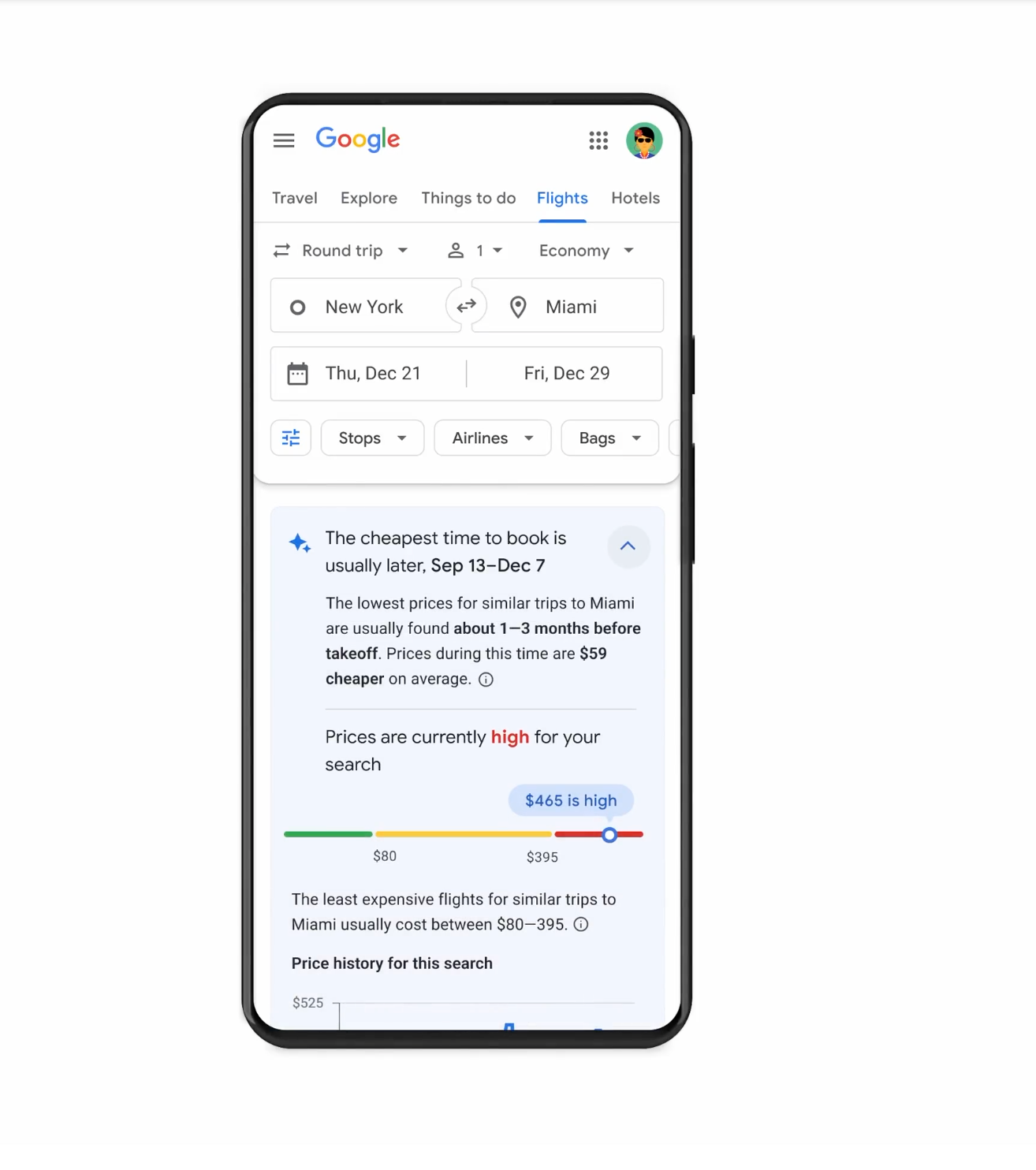
Here's a final example. I apparently waited too long to book my flight home for Christmas a few months ago.
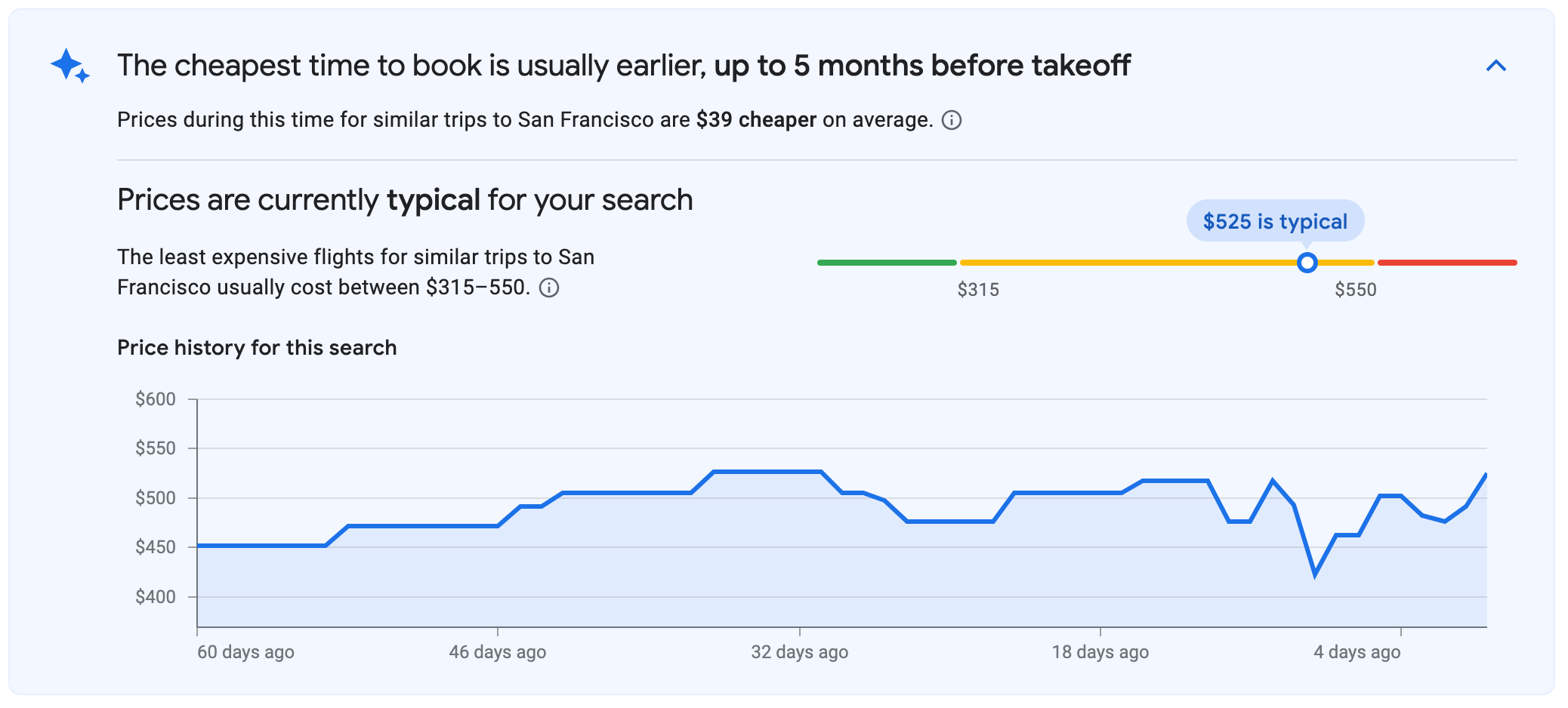
Basics of Google Flights
How to perform a basic flight search.
First, you'll want to navigate to Google Flights .
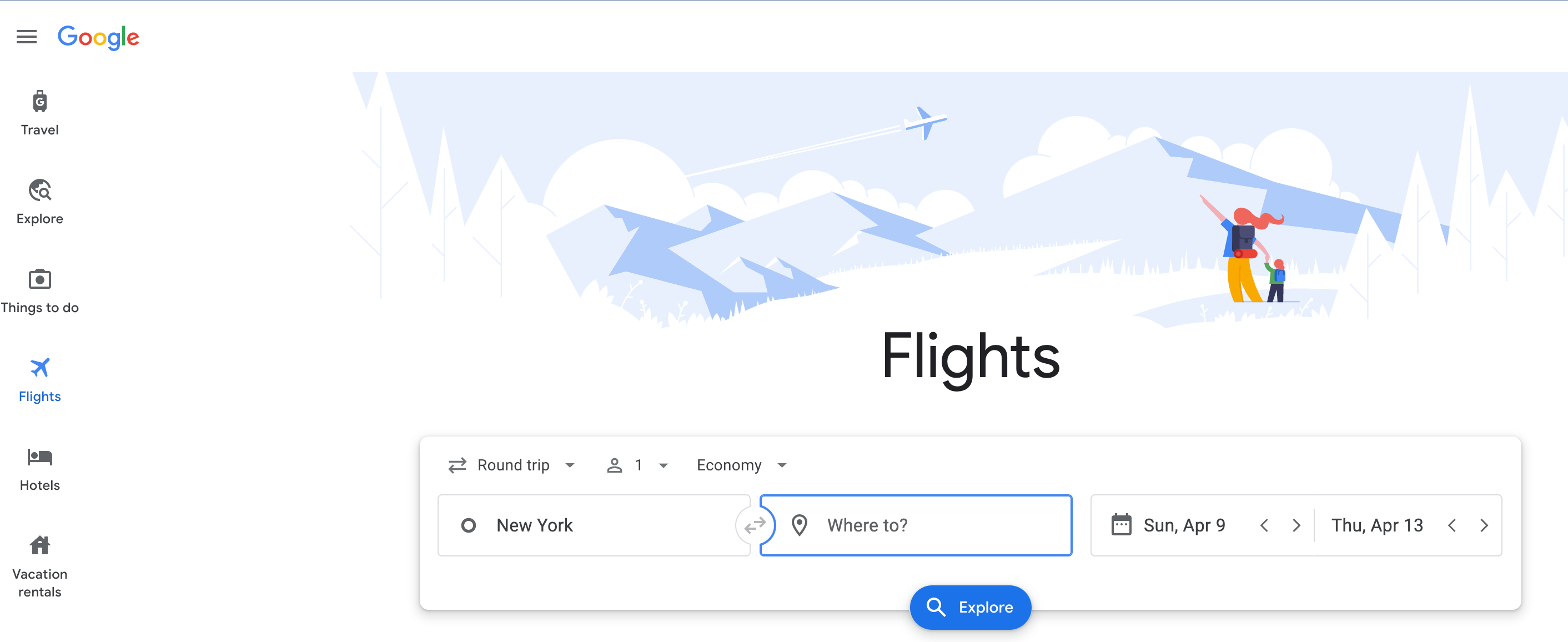
The toolbar has additional features for trips, including things to do, hotels, vacation rentals and a shortcut to a cool tool called "Explore." However, we'll focus on using the tool to book flights for now.
All of the fields and drop-down menus on this page are relatively easy to decipher:
- Departure (where you want to fly from)
- Destination (where you want to fly to)
- Date(s) of travel
- Round-trip flights, one-way flights or multicity trips
- The number of passengers (but here's why you should search for a single ticket , even if you're traveling in a group)
- Ticket class: economy, premium economy, business class or first class
If you know where you're going and when you want to be there, all you have to do is plug in that information and hit the blue search button.
For example, here are all the options I see when I search for flights from New York's John F. Kennedy International Airport (JFK) to San Francisco International Airport (SFO). You can search by destination or by airport code.
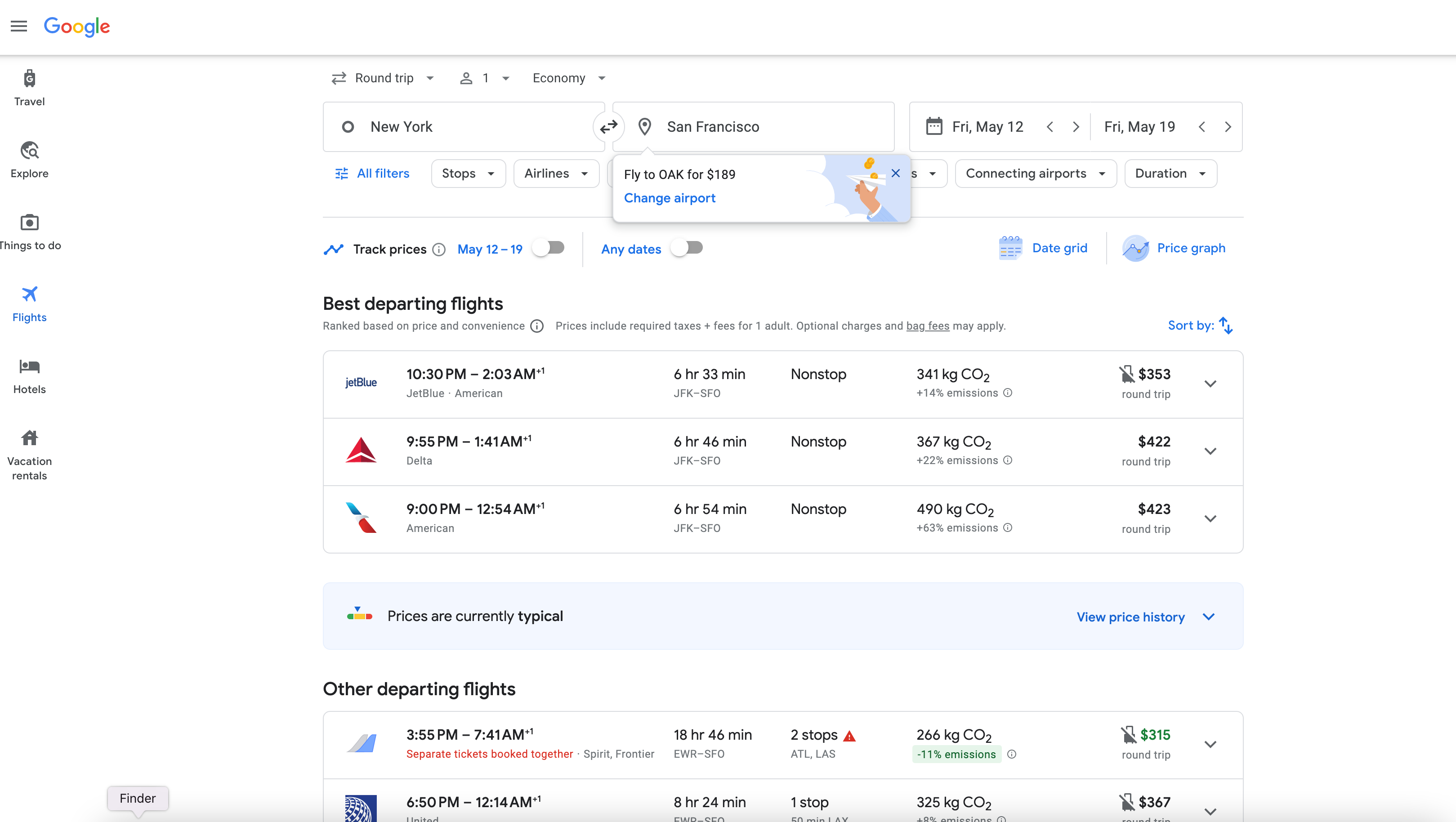
Note that Google automatically displays what it considers the best departing flights based on a combination of factors, such as price, the convenience of routing, the number of stops and the travel time. Of course, these may or may not be the best flights for you.
In this case, there are hundreds of options to choose from.
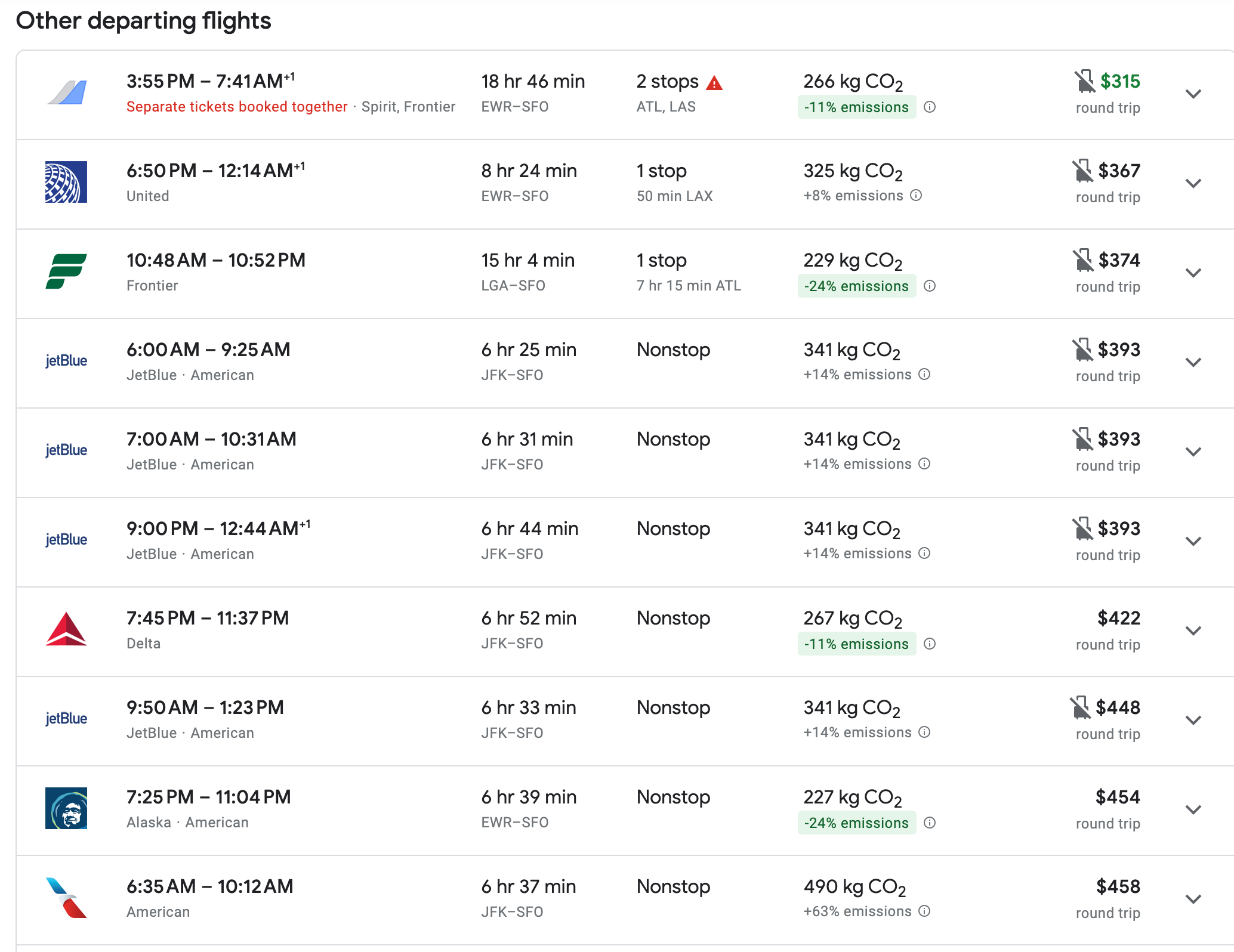
For this example, I chose to book an American Airlines flight on my outbound trip.
The cheapest option is sometimes to fly the return on a different carrier. However, Google Flights clearly indicates there will be two tickets purchased separately.
Often, Google will suggest remaining on the same carrier for both legs. In this instance, one of the flights was on JetBlue.
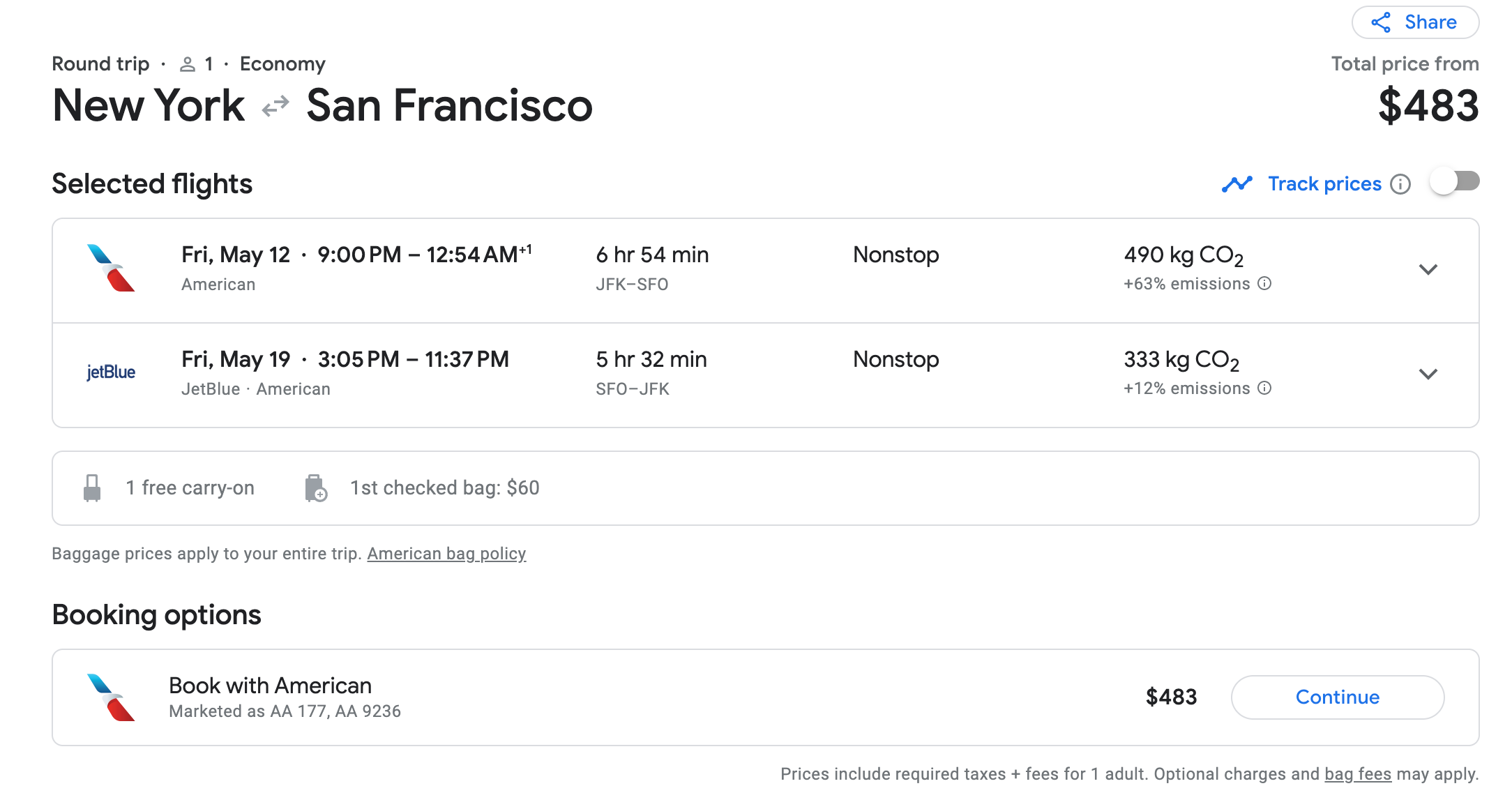
There are all kinds of ways to filter your searches. We'll get a bit more into that below.
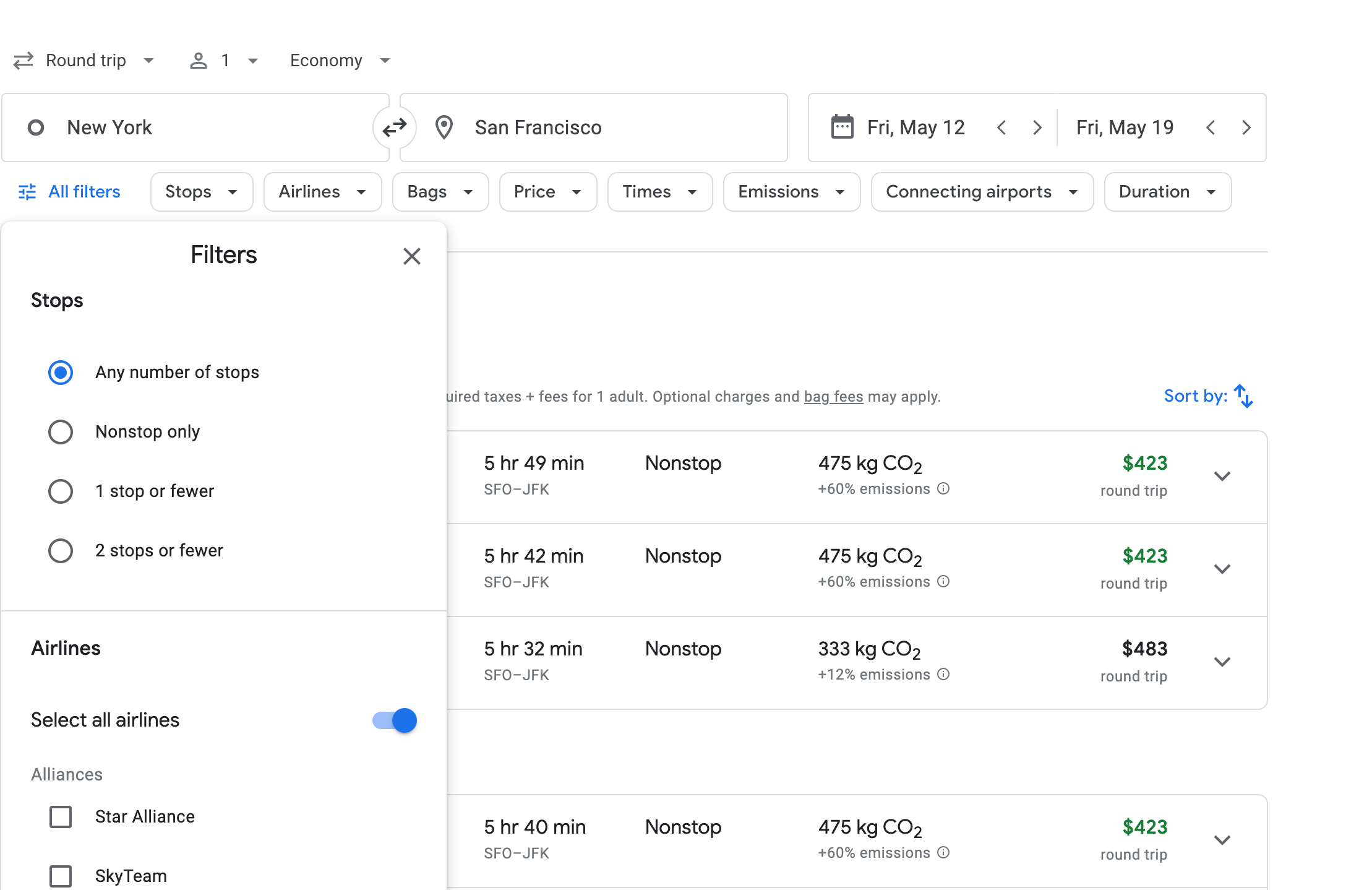
Once you've found the flight you want, you have the option to book directly with American Airlines. Google will give you several options for the type of ticket you want to purchase, including basic economy, refundable and other types of fares.
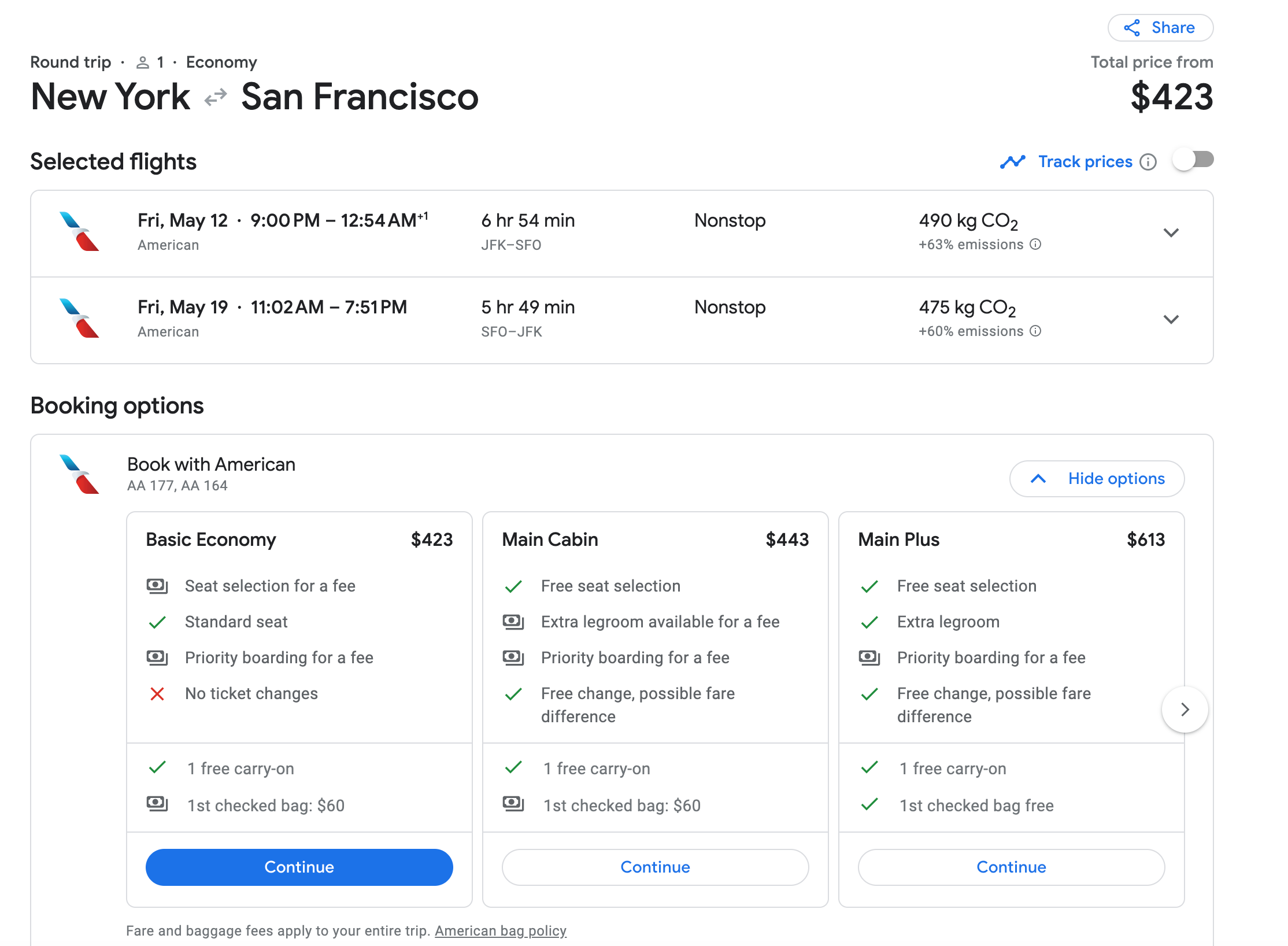
Clicking that link would take me to American's website , with these flights and prices already selected. There, I could enter my passenger details and loyalty number, select a seat and pay for the ticket.
All elite perks and other loyalty benefits are honored on flights booked directly on the airline website via Google Flights. However, if you are booking via a third-party site, that may not be the case. It pays to make sure you book directly with the airline if possible.
In this example, the cheapest option is for mixed tickets with multiple stops. Most people are not going to want to take that option. It involves booking through a third-party website with tickets on different airlines and multiple flights and layovers. No thanks.
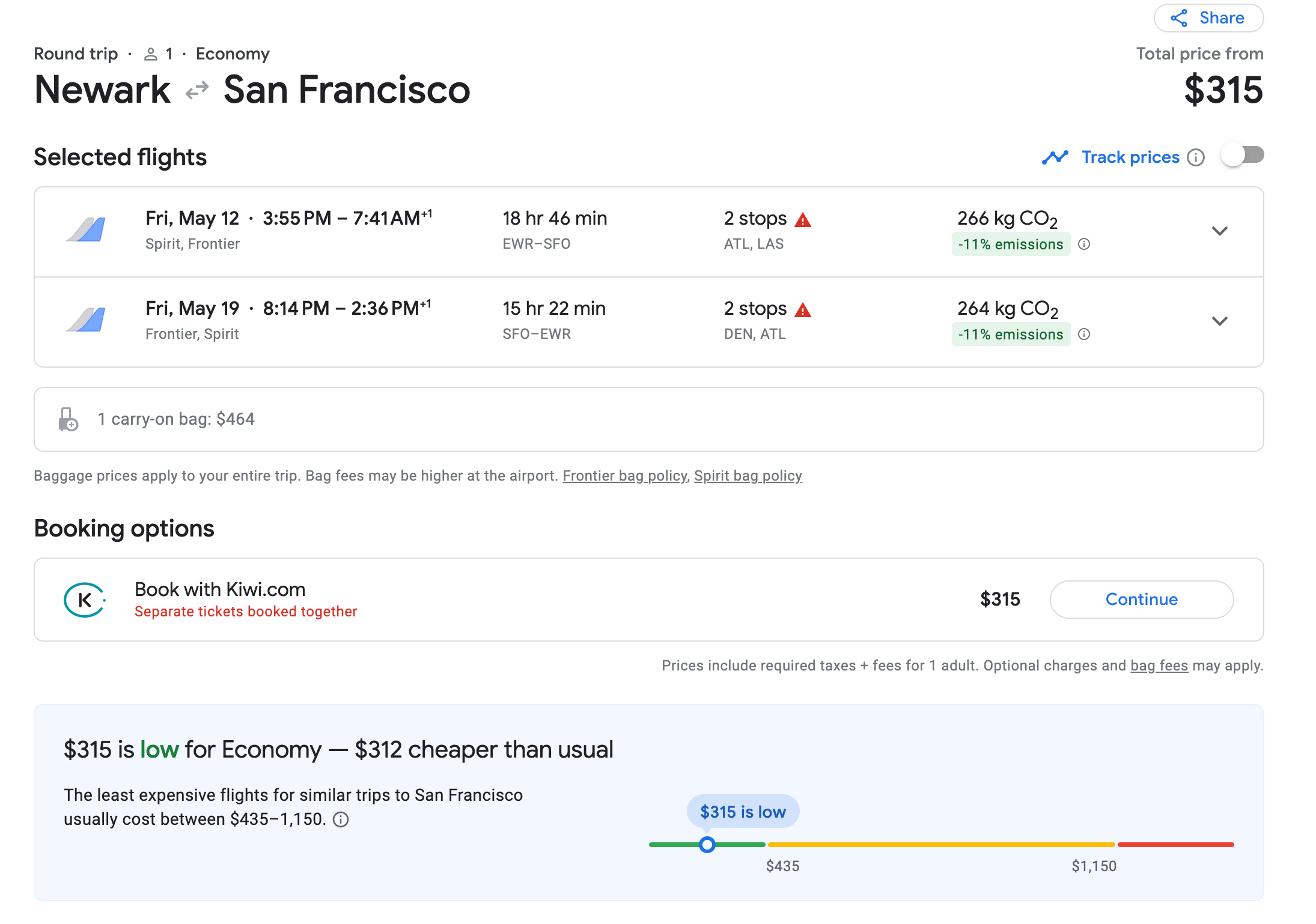
Related: 9 things to consider when choosing to book via a portal vs. booking directly
Below is an example of Google Flights' handy historical price guide, which shows whether the fare you found is low, high or near the average price for flights on this route.
I can see the flights were more than $600 a few months ago, and my $442 fare was considered low. Given how expensive airfare generally is these days , I was happy enough with that.
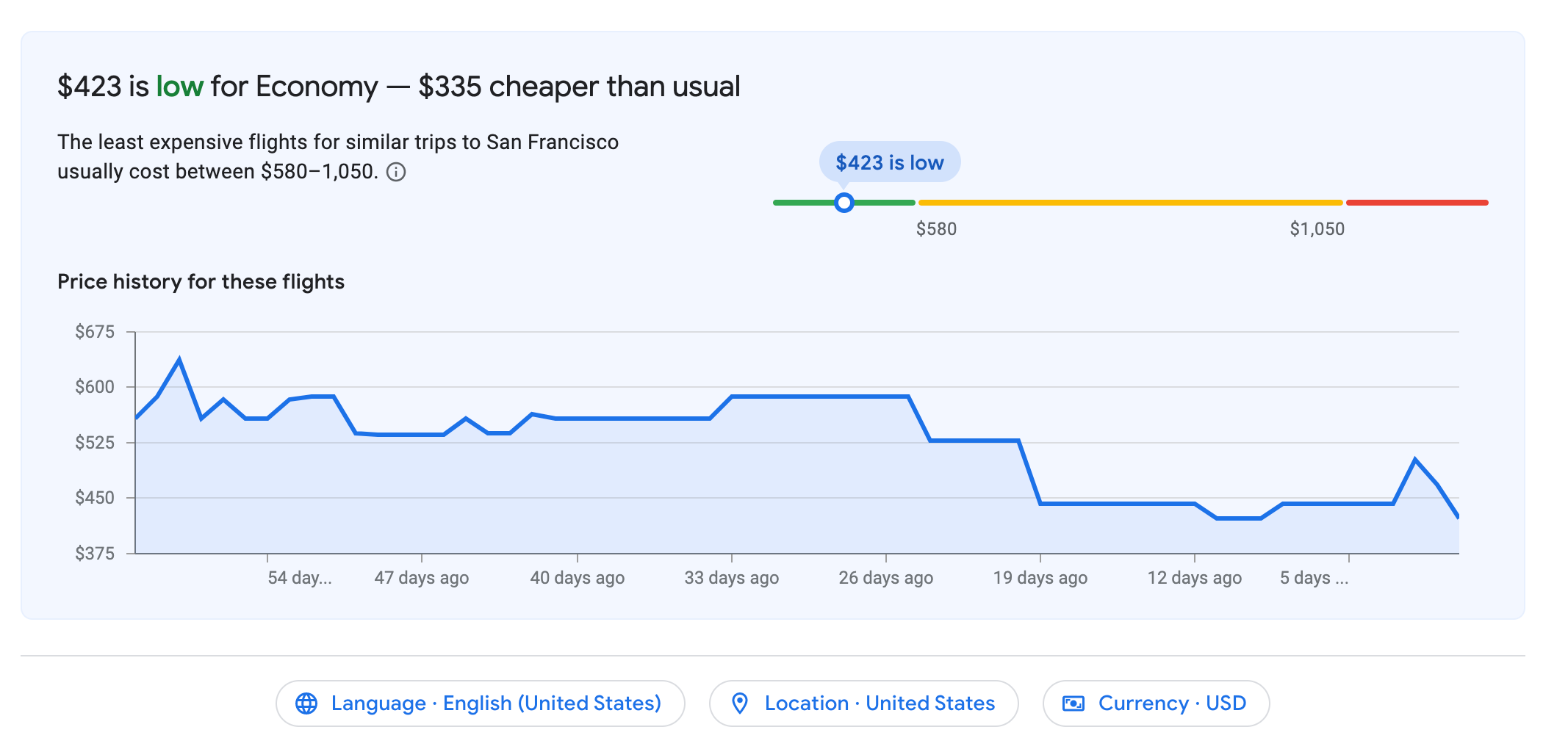
The bottom of this screenshot also shows the options available at the bottom of each Google Flights page, where you can select your preferred language from a drop-down menu. You can also customize your location and preferred currency for easy conversion.
Search by specific times of day
Say you want to take a weekend trip away. You need both flights to be outside business hours but not too late in the evening, as you don't want to land in the middle of the night.
Google Flights has a handy filter we use to make sure the flights are exactly when we want them. No matter how inexpensive that 6 a.m. flight may be, a 3:30 a.m. wake-up call rarely feels worth it.
So, you can set the search results to only show flights departing and arriving within your chosen specific time range.
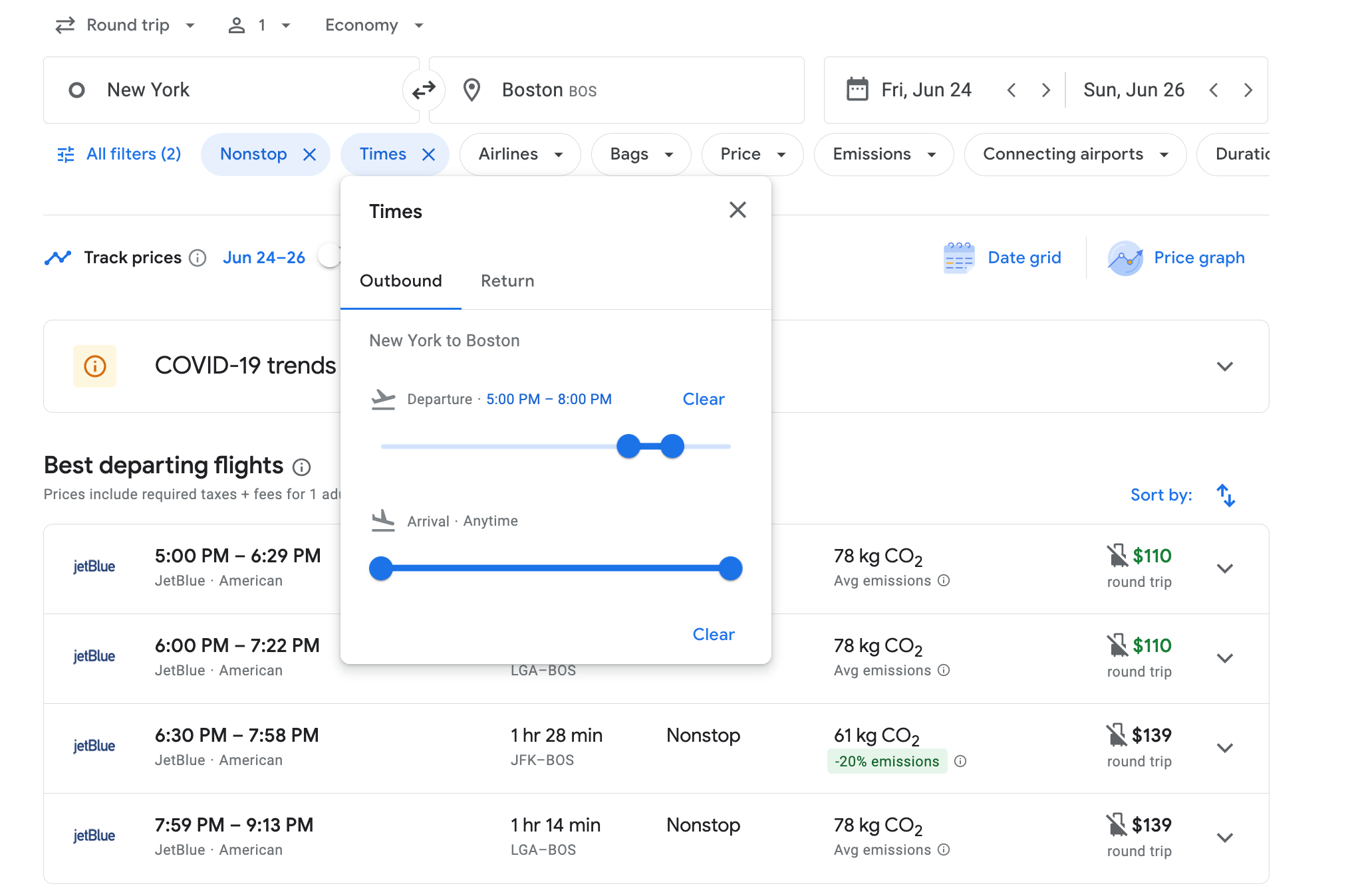
See how many bags you can bring on board
In the same series of buttons below your Google Flight search, click on the "Bags" button to specify how many pieces of luggage you want to bring on board with you.
This selection may greatly limit your search results — or drive up your price options — so be prepared to change it if necessary.

Nonstop, one-stop or any flight will do?
Similarly, you can filter flights by the number of stops along the way. You might be the glutton for punishment who longs for a 50-plus-hour flight with multiple layovers. You can do that if you so desire.
However, if you want to minimize the chance of delays or disruptions, have a family to rush back to or just want a shorter flight, nonstop is your friend. Headed overseas? The usual sweet spot between price and comfort will be a one-stop flight.

Search for flights from your preferred airline or alliance
If you don't fly often, the operating airline may not matter to you as much as the price does.
However, if you've begun accumulating miles and status with a specific carrier, it can be addictive to stick with that carrier and program. The exclusive benefits of elite status can be exhilarating, and there's nothing more exciting than booking your first award flight — especially if you know you got an amazing deal.
Related: What are airline alliances, and who's in them?
With filtered airline search results, Google can help you keep that momentum going. Use the button under the search results to filter out unwanted airlines or select specific airline alliances you want to patronize. Or, turn off the "Select all airlines" option and manually select the carriers you want to choose from.
Whether booking with cash or points, you may want to stick with one program to maximize mileage earning or status. For example, if I were trying to hit Diamond on Delta Air Lines, I would search only for Delta flights.
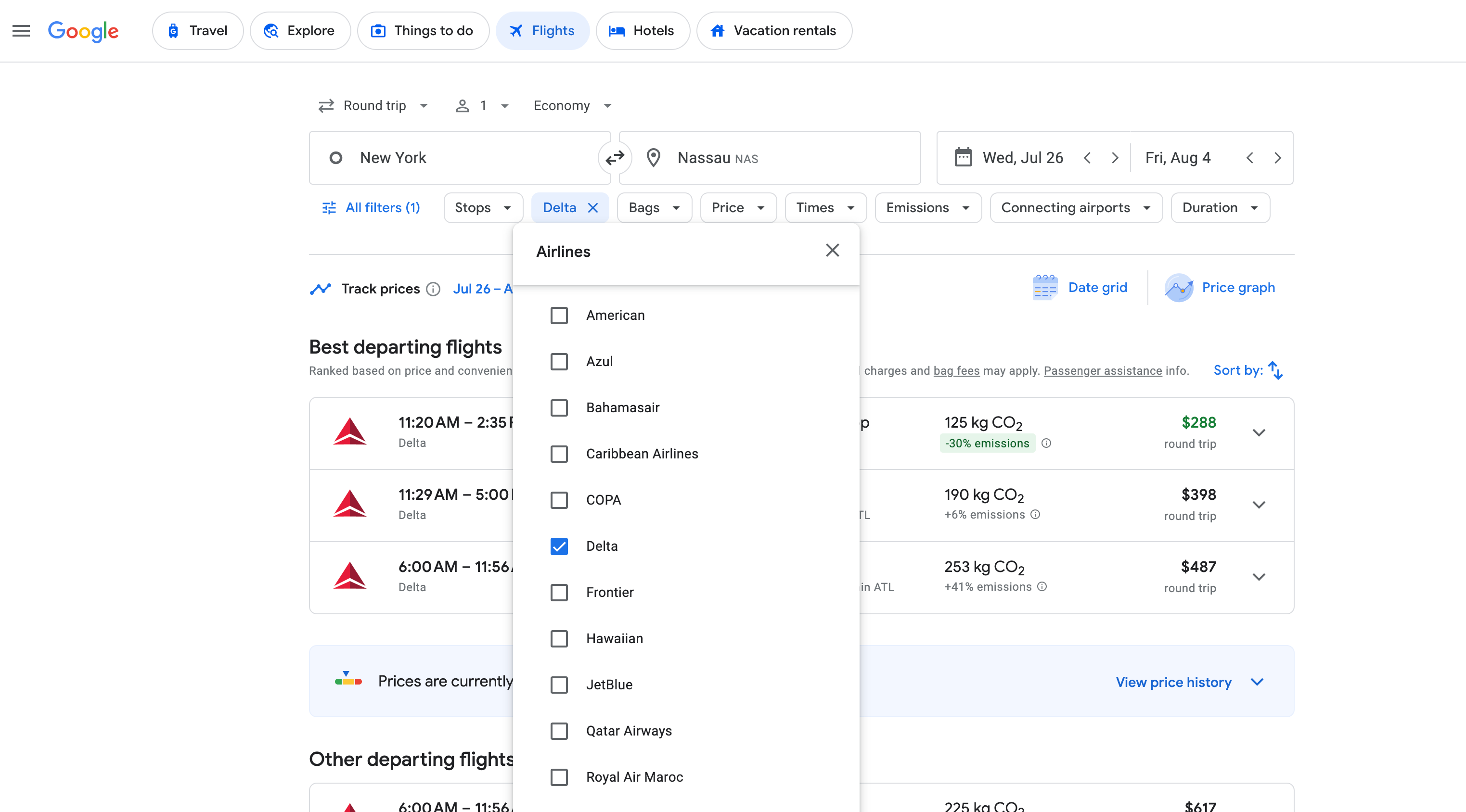
You can also pick airline alliances like Oneworld and SkyTeam to ensure you travel on your preferred airline or its partners. In my case, I would select SkyTeam.
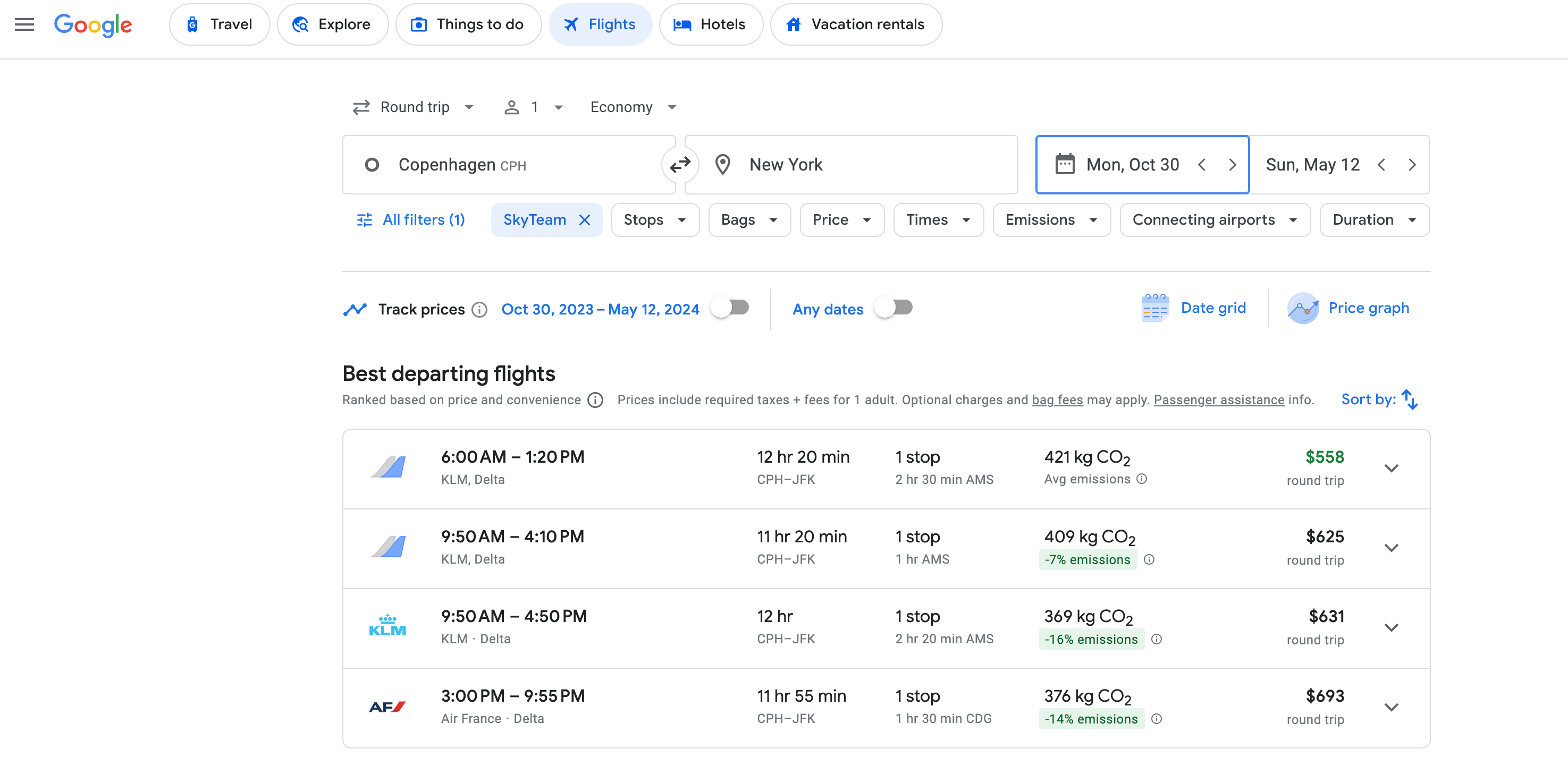
Connecting flights
You can also decide if you want to fly nonstop or choose how many stops you are willing to make. You can even choose the connecting airport.
Especially with international flights, some airports are better to connect in than others. Helsinki Airport (HEL) is lovely. Paris-Charles de Gaulle Airport (CDG) and Amsterdam Airport Schiphol (AMS) can be challenging , even if you are an experienced traveler.
Related: What are the best European airports to connect in?
If you have a range of options to travel from New York to Rome Fiumicino Leonardo da Vinci Airport (FCO) with a choice of connecting airports, you can filter the results to only show the airports you want to connect through.
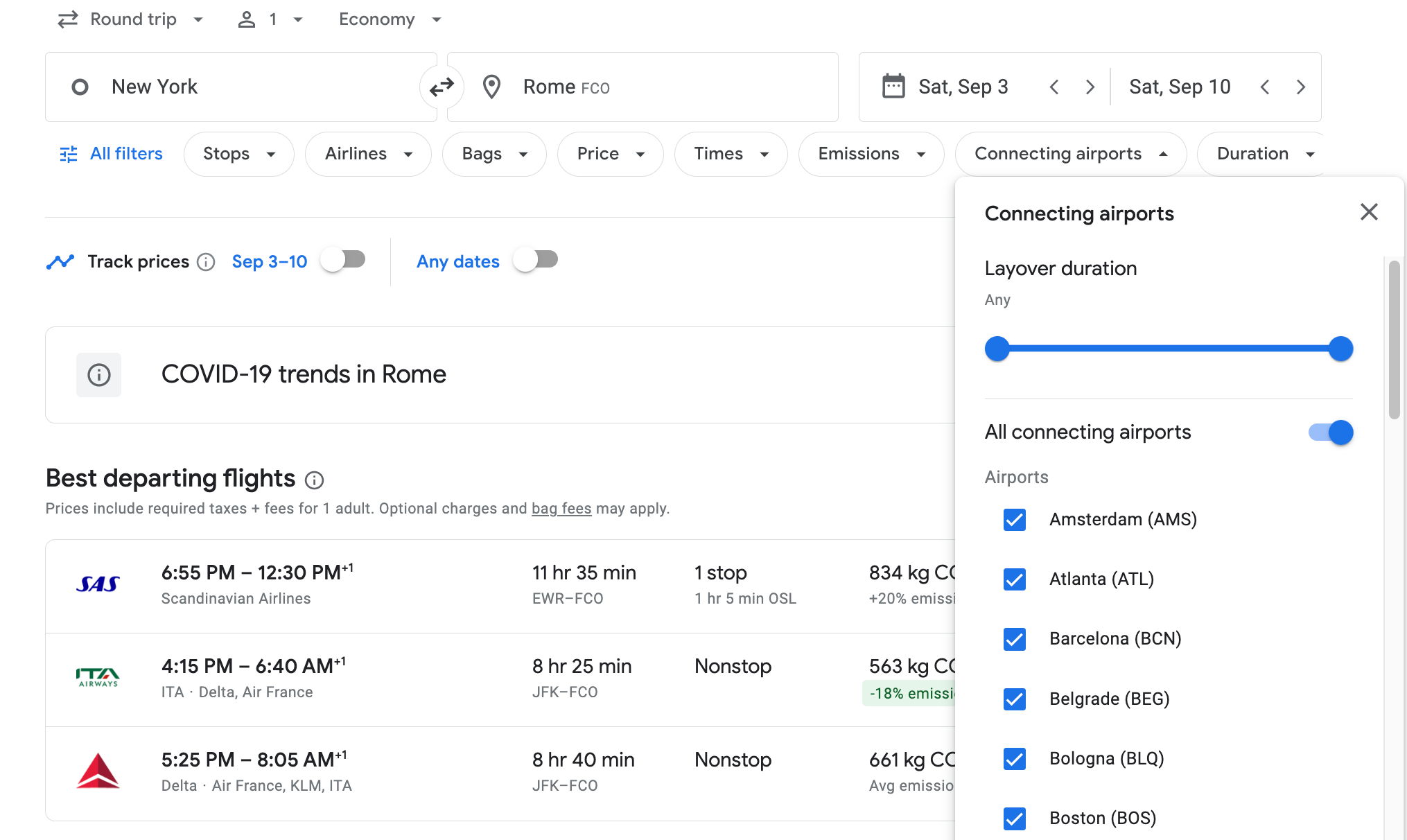
You can also choose how long you would like your layover to extend. You might want to keep it short to reach your destination as quickly as possible. Or, you may prefer a long layover to allow for some buffer time in the event of delays.
Related: How to plan a free stopover on your next trip abroad
Score the best legroom and other seat amenities
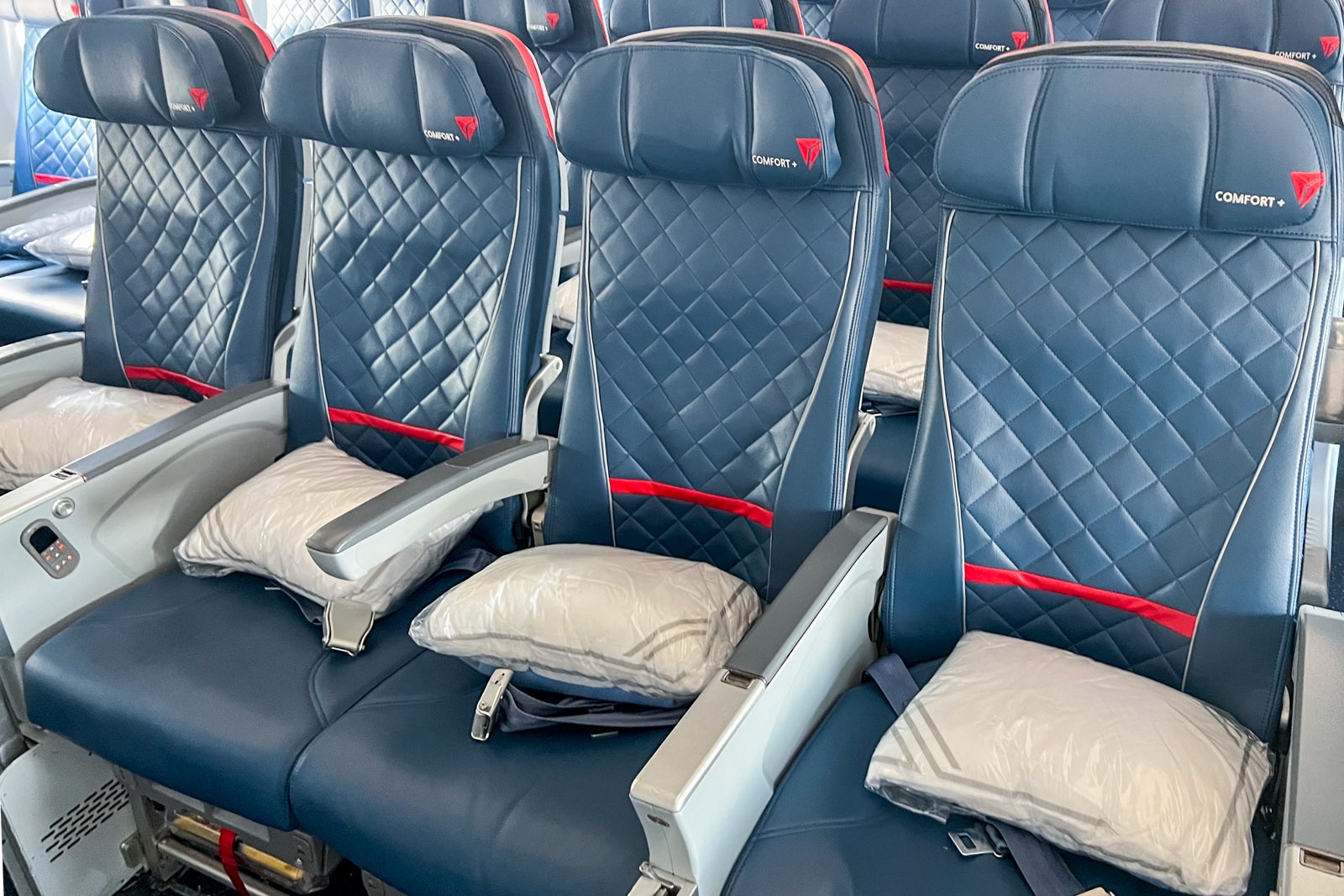
Don't you hate boarding a flight to find your knees touching the back of the seat in front of you? Fortunately, Google Flights has a feature that will show you the legroom you can expect on your next flight before you have purchased the seat.
Legroom can differ noticeably from carrier to carrier, aircraft type to aircraft type. From the search results below, you can see that Spirit Airlines' is below the industry average at 28 inches, while JetBlue's is above average at 32 inches.
If you value legroom, this means the JetBlue option will have 4 inches more legroom than Spirit.
In coach seating terms, that's a lot.
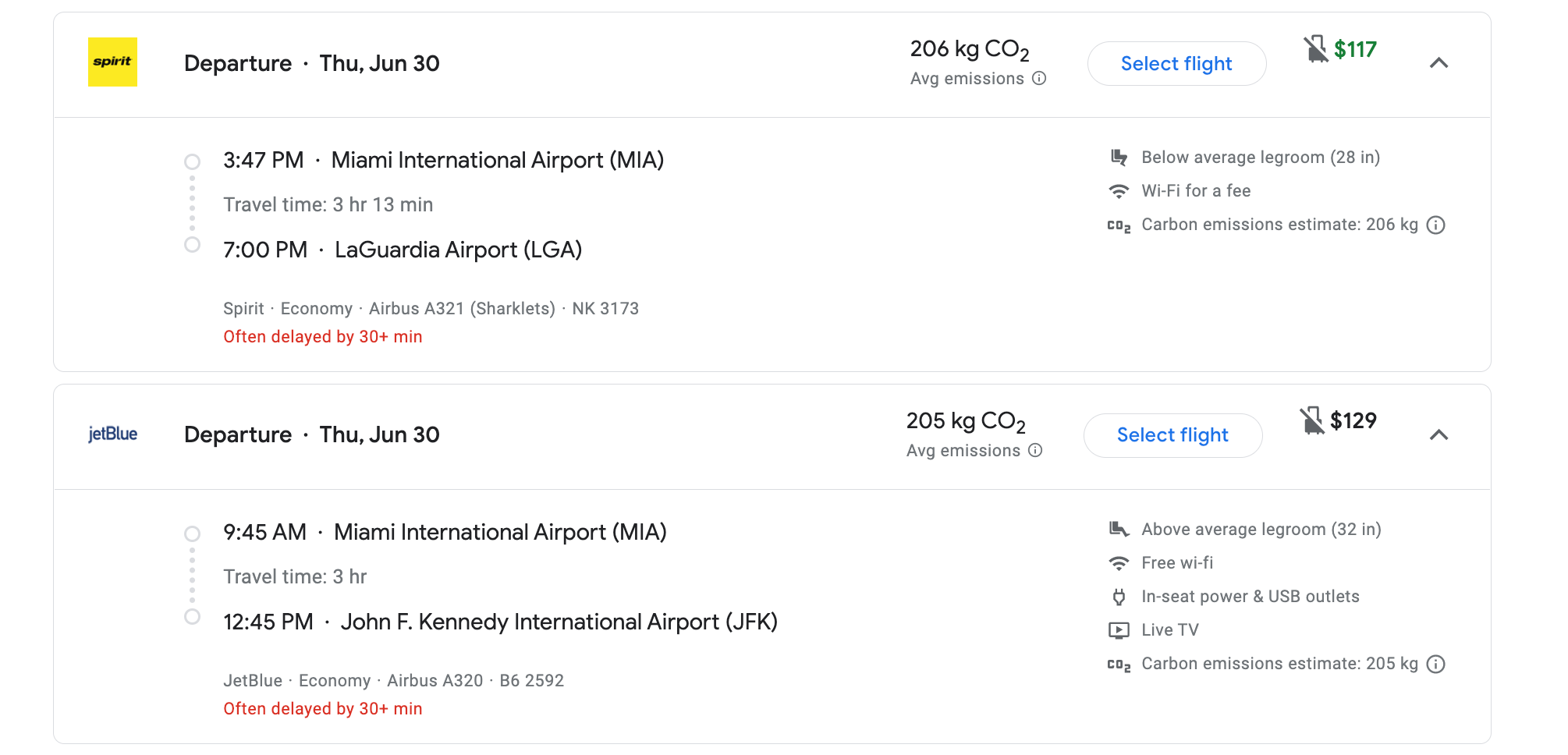
Along with legroom, Google Flights will also indicate if Wi-Fi is scheduled to be available on your flight (and if it is free or available at a cost), if the plane has in-seat charging options, and if the flight offers entertainment like live TV or options to stream to your personal device.
On a flight longer than five hours, your devices may run out of juice. So, again, you may want to choose the product that best suits your needs rather than selecting a flight based entirely on price or carrier.
Know your emissions
With sustainability becoming an increasingly important topic in travel , Google Flights will let you know the approximate carbon emissions for your flight based on the route, aircraft type and seating classes.
Below are the search results for a flight from Los Angeles International Airport (LAX) to Tokyo's Narita International Airport (NRT). United Airlines operates a fuel-efficient Boeing 787 on this route, which would produce a lower-than-average 734 kilograms of carbon dioxide.
However, the Singapore Airlines flight uses a less fuel-efficient (and larger) Boeing 777 aircraft that produces a higher-than-average 1,163 kilograms of carbon dioxide.
You can even filter your search results only to show lower-emissions flight options.
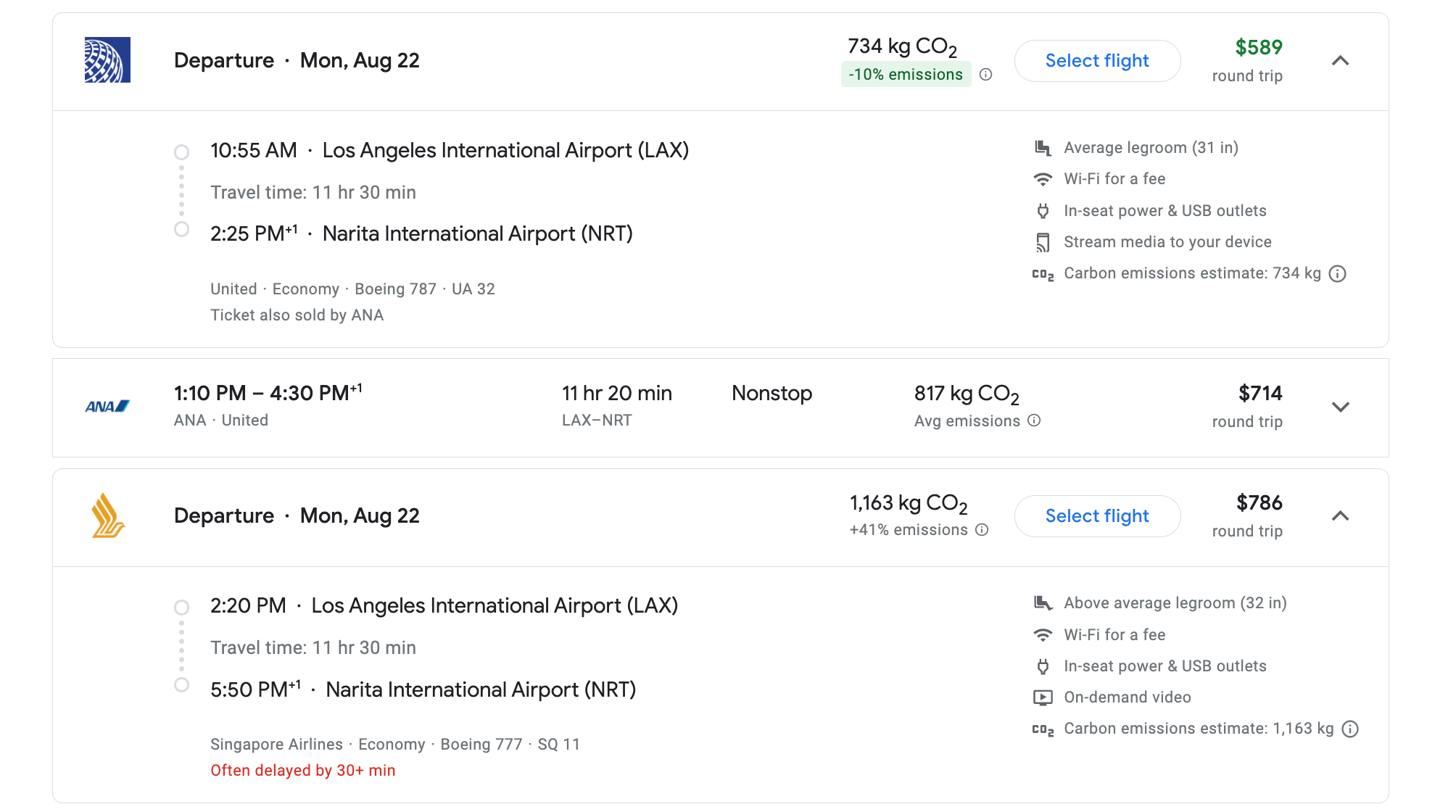
How to search by cheapest dates
Let's say I want to get from JFK to LAX in September, but I'm not tied to any specific dates. Google Flights can help me find the best possible prices for that trip.
On the search page, I can see the lowest price for that particular day if I click on the calendar icon. Prices listed in green represent the lowest price available across all current dates, while the days highlighted in blue show which dates I've selected.
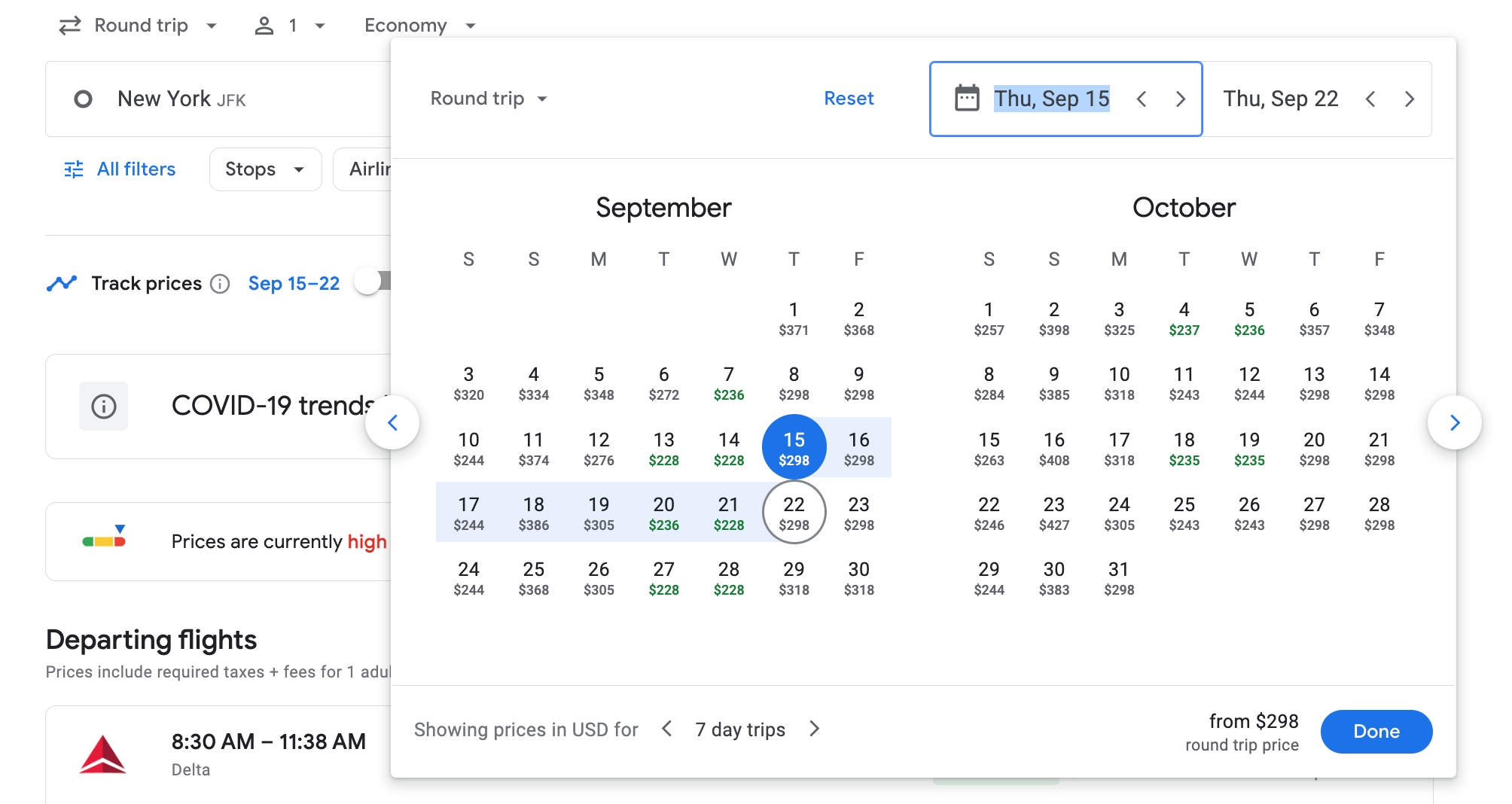
Another way to view the cheapest dates is to click the date grid option. This will again show the cheapest dates in green, and you can easily line up different outbound and inbound options to see if the cheapest dates work for you.
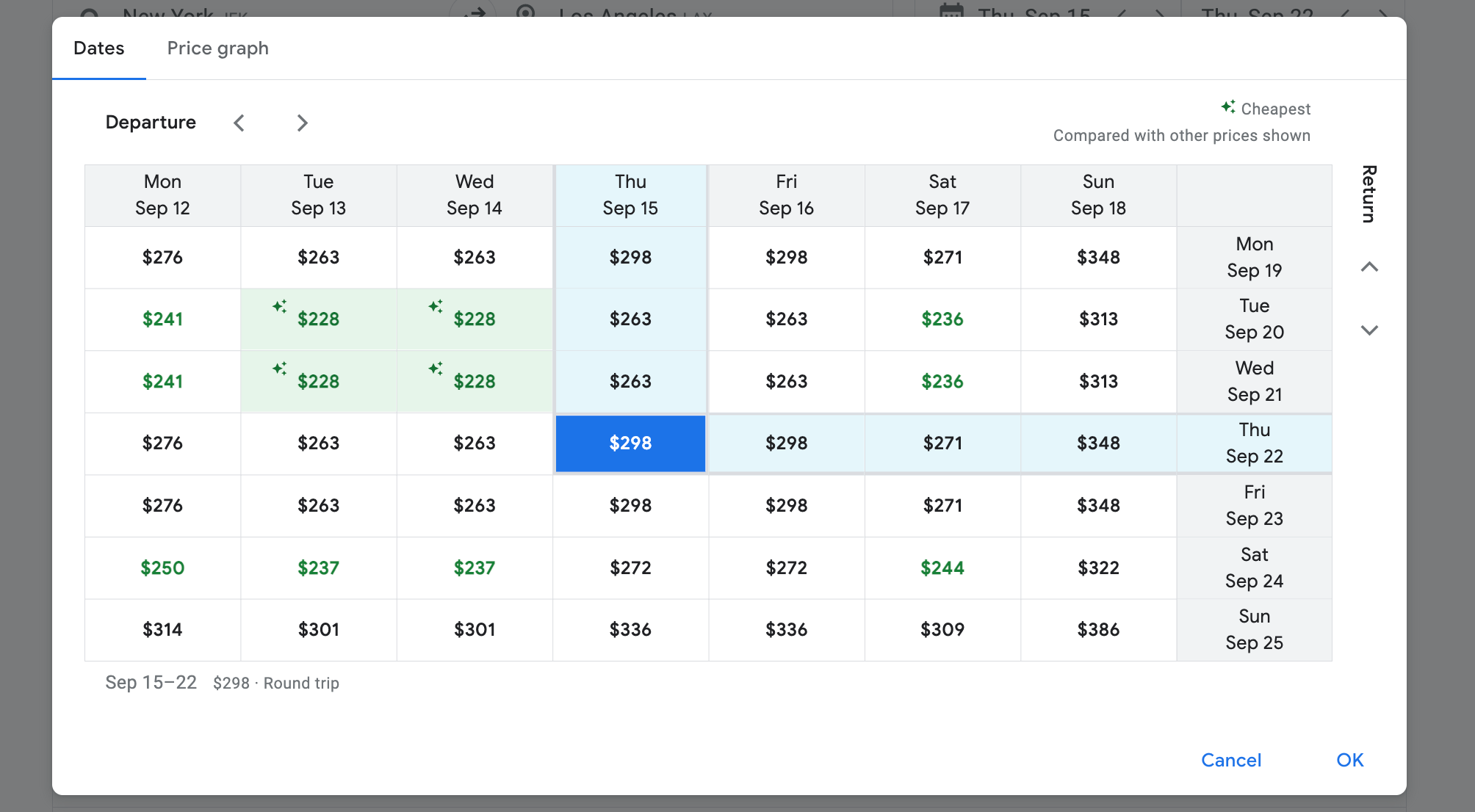
You'll often find that the cheapest flight isn't necessarily the best or most convenient route. Google will show you those lowest prices but prioritize better routes before it.
In this example, Google Flights prioritizes slightly higher fares as the "best flights" search results because they include a full-size carry-on bag.
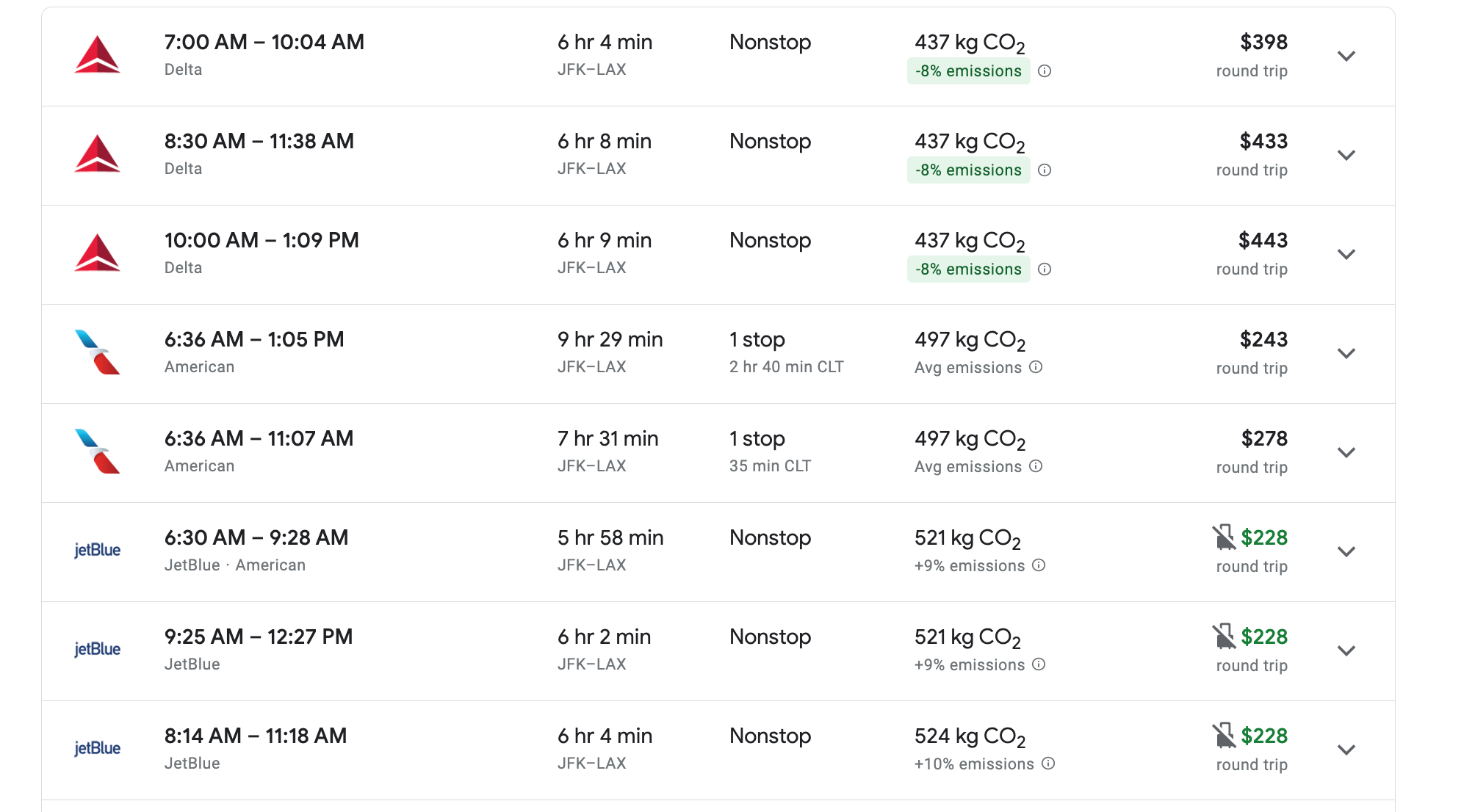

How to set a pricing alert for yourself
After all that diligent work, give yourself a pat on the back. You've likely found the best option for you.
Some people are ready to book immediately, but most of us might need a day or two to solidify our plans with our fellow travelers or with work. Never fear: Google will help you track your flight and even tell you when the price goes up or down.
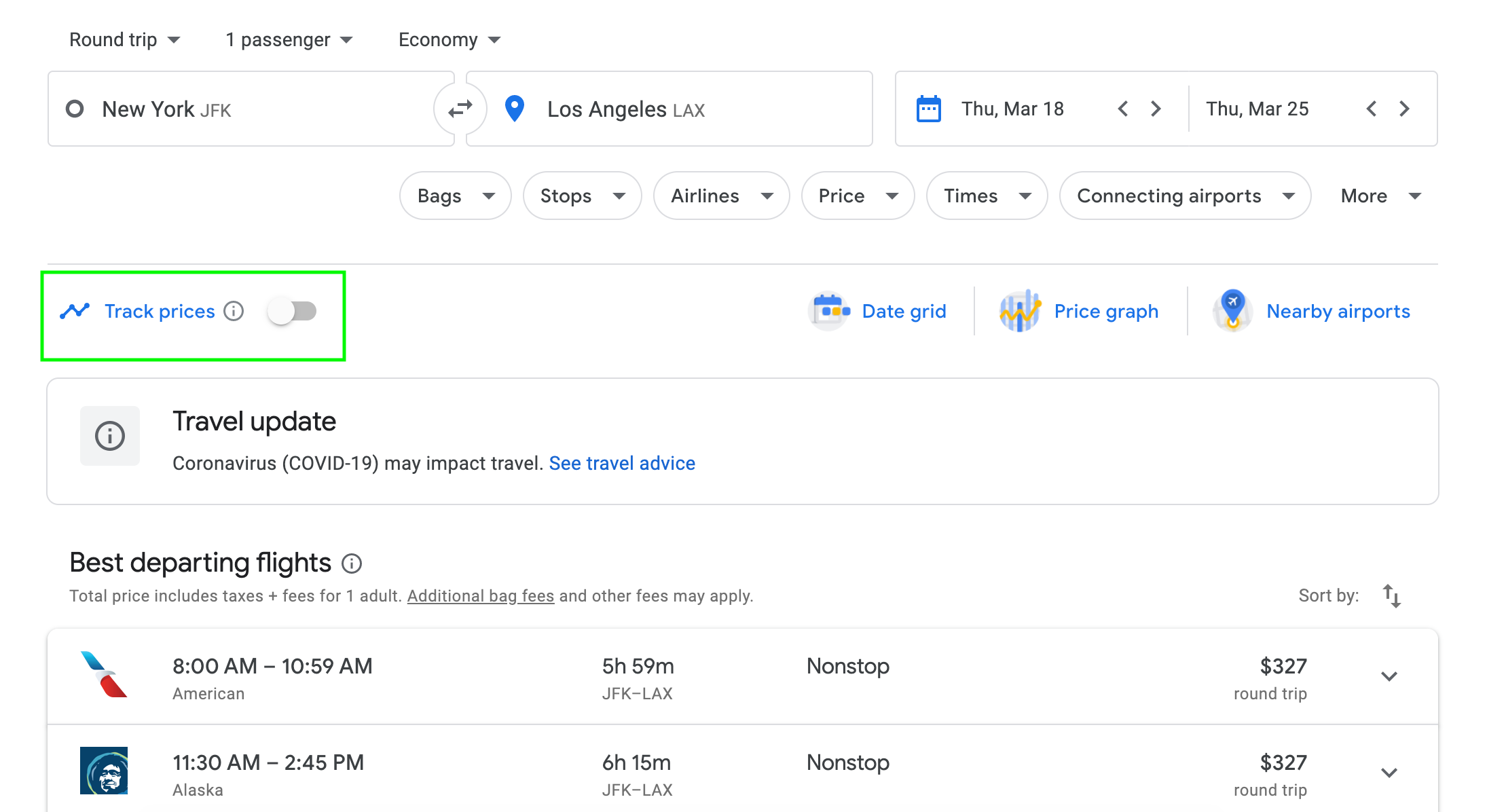
Immediately above your search results, a little toggle reads "Track prices" (boxed in green in the screenshot above).
Click on that — and log in to your Google account if necessary — and Google Flights will send updated pricing alerts directly into your inbox.
If you have booked a refundable or changeable fare, you may want to switch this on even after you've booked. You will be alerted if the price goes up or down, so you can feel comfortable knowing you are getting the best deal. You can see part of my list of flights I'm currently tracking in the screenshot below.
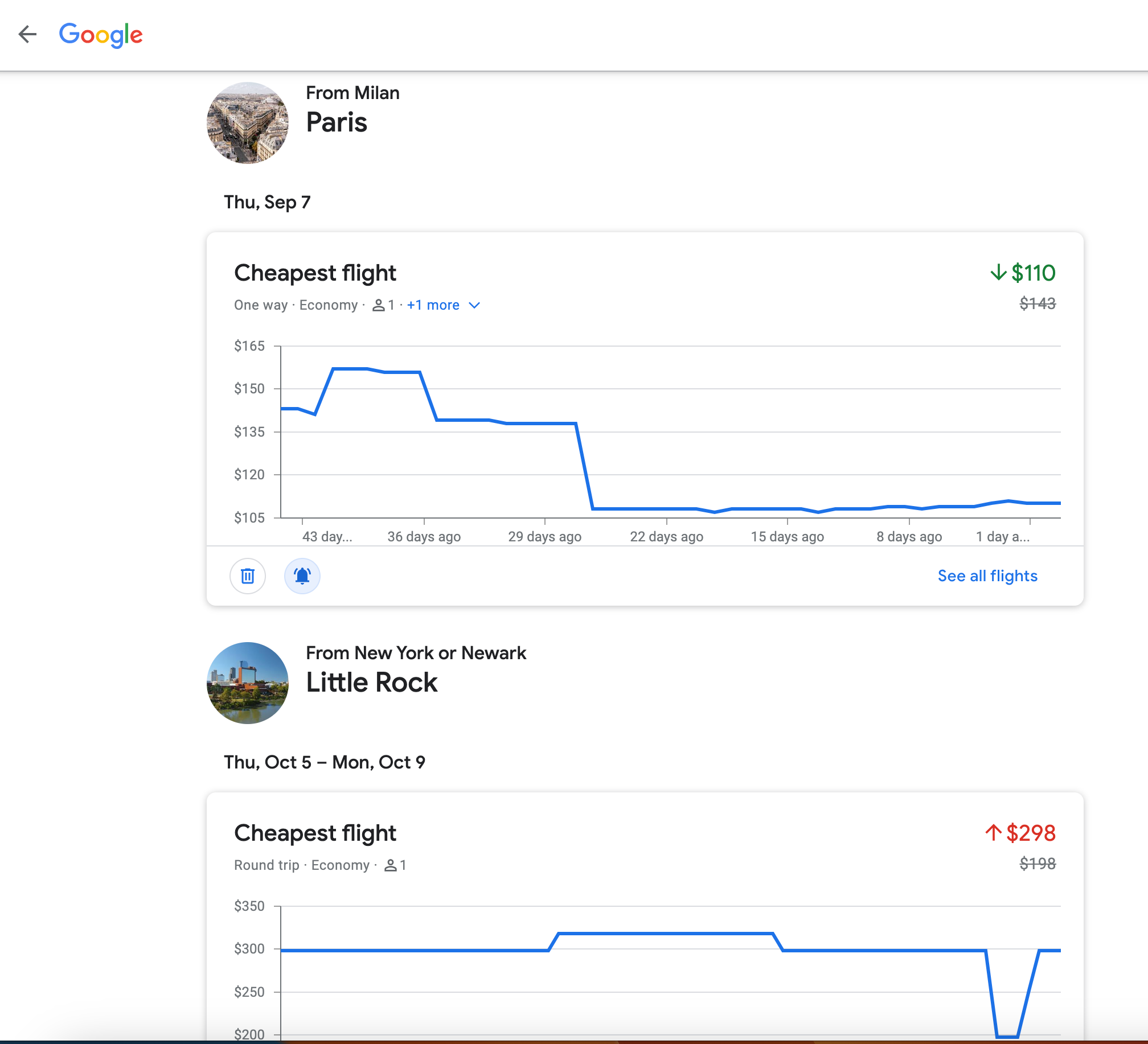
Related: How to avoid airline change and cancellation fees
How to search multiple airports at once
Sometimes, you're willing to land or depart a bit farther away in order to find a better flight deal. Google Flights can help reward that flexibility. In fact, you can enter as many as five departure or arrival airports on Google Flights.
Let's say you live in New York City, where you have three major airports from which to choose. You want to fly to Southern California, which is easily accessible from multiple airports as well.
There are two ways to run this search:
- Type in your city name and let Google offer suggestions: This works for many major metro areas. As soon as I type in New York, I see several of the major airports: Newark Liberty International Airport (EWR), LaGuardia Airport (LGA) and JFK. Sometimes, you'll even see New York Stewart International Airport (SWF) in Newburgh, about 60 miles north of Manhattan, as an option.
- Manually type in your airport codes or names : Some cities won't show you all the logical potential airports. For Southern California, you will have to manually type in the names or codes of each airport in the area for some searches. (Don't forget San Diego International Airport [SAN] as a potential option.)
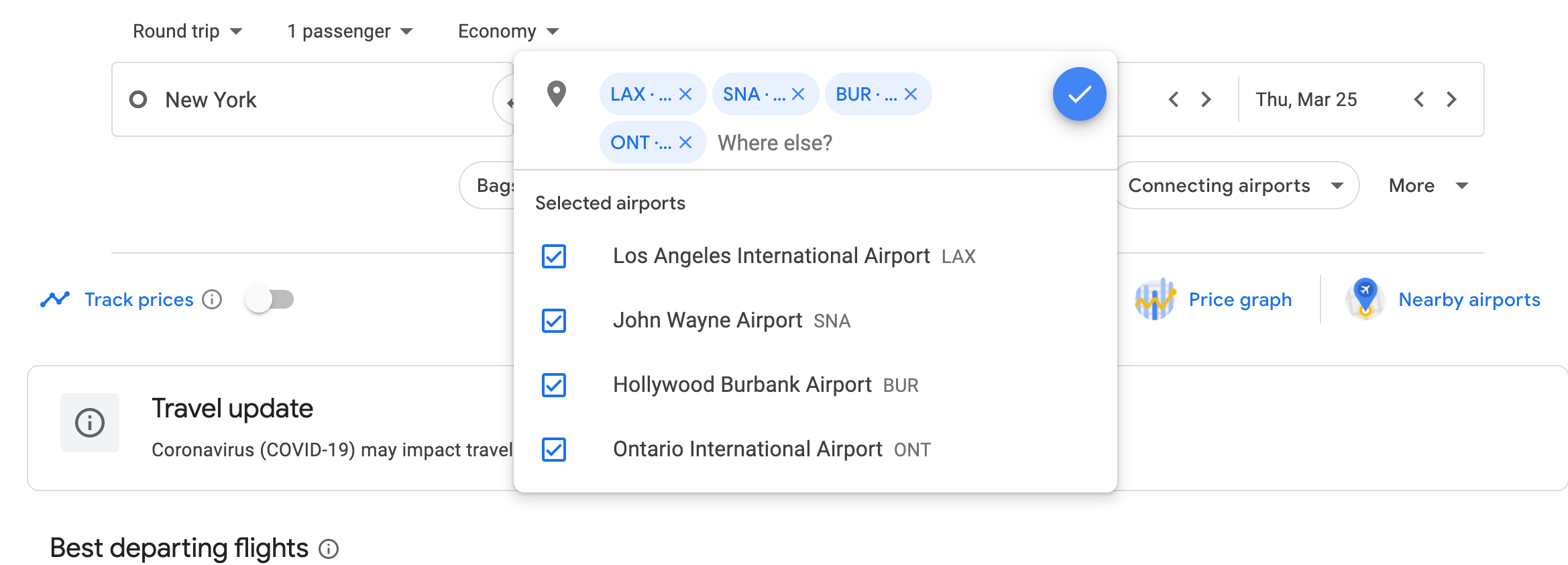
You can open a separate browser tab and look up local airports by name. Or, if you're a pro and know the codes, you can type them directly into the destination airport search field (i.e., LAX, SNA, BUR, ONT). Then, hit the blue check to run the search.
Voila: The cheapest option for March 18-25 is taking a nonstop, round-trip flight from EWR to LAX for $258 in United basic economy.
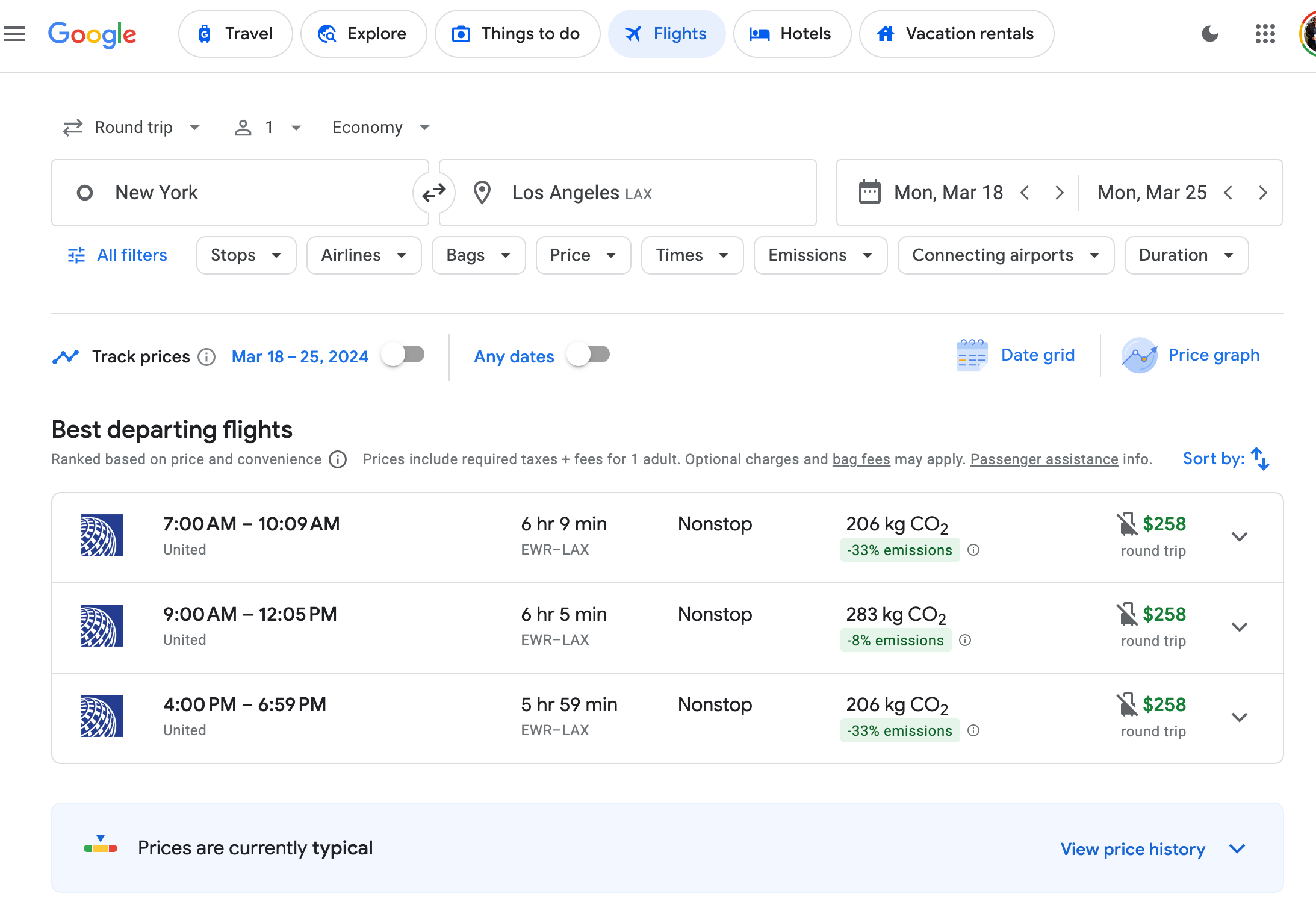
How to check for carry-on bag policies
I don't care what anyone says: Low-cost carriers can be fantastic for finding great deals.
However, if you're a heavy packer, you'll need to plan ahead. Many airlines cut costs by charging extra for bags. You're used to this with major airlines, but some ultra-low-cost airlines will even charge you for carry-ons larger than a backpack or a purse .
It can be difficult to track which airlines charge what, but Google Flights can also help with that.
Basic economy flights will show on the search results page, with the little "no luggage" icon next to the $247 price tag in green.
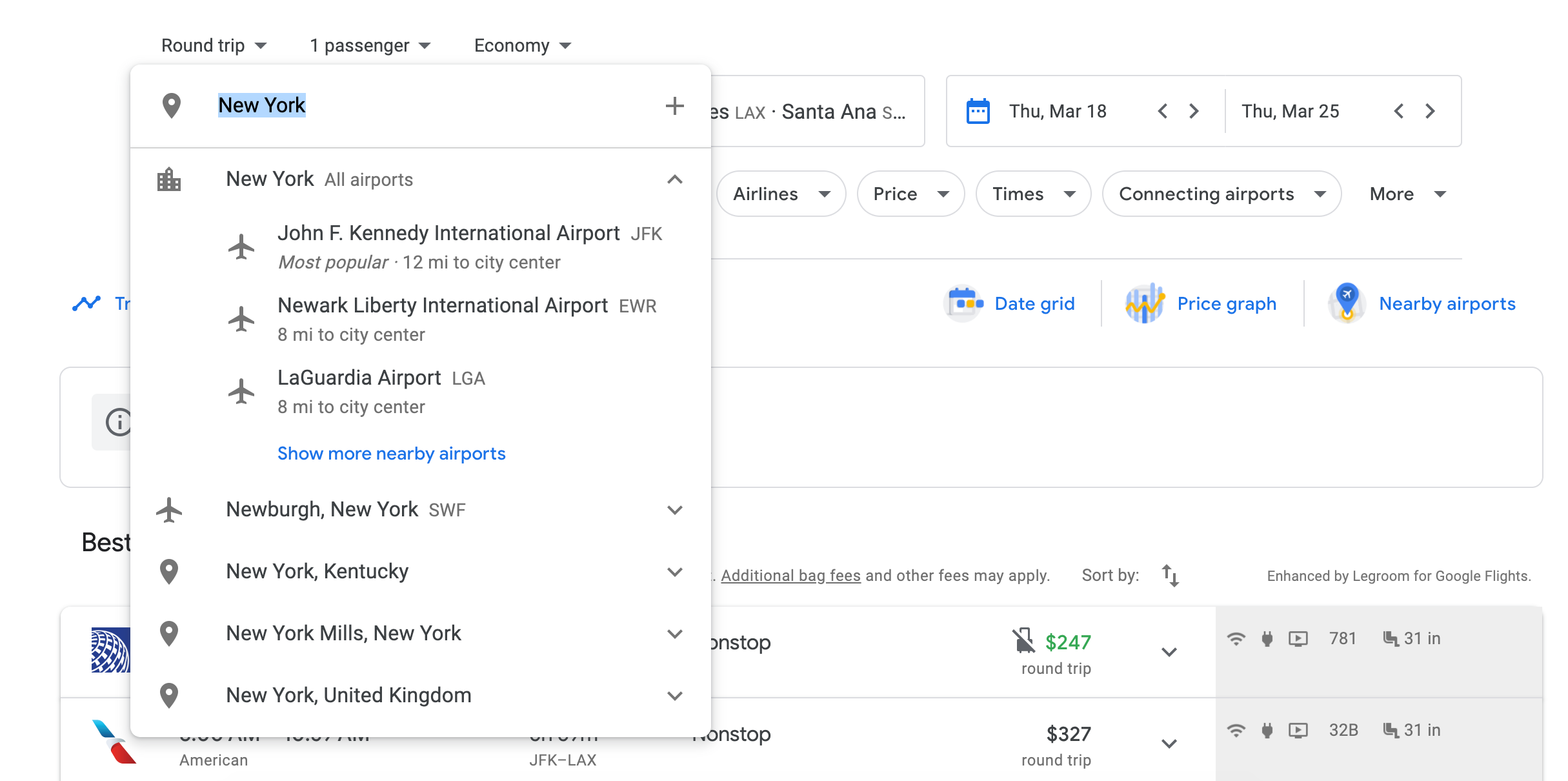
When I click through to the final booking page, Google will remind me again that I'm booking a basic economy flight; it'll show my current price and its limitations while also displaying economy and first-class booking options next to it.
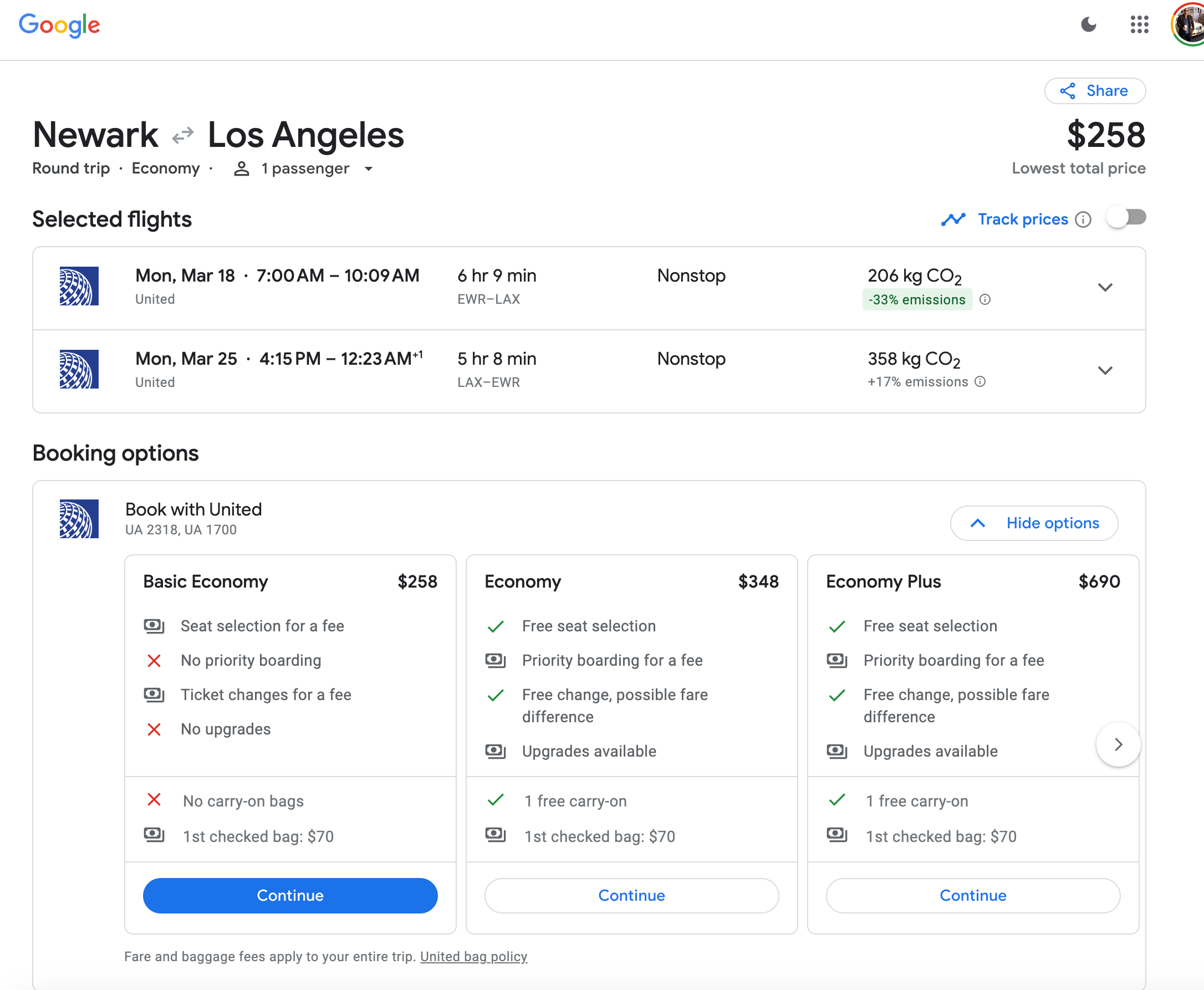
Remember: Google Flights doesn't work with Southwest Airlines
One important caveat: You might wonder why you don't see any Southwest flights on Google Flights.
Well, you might see them, like with this search result for Austin to Las Vegas:

However, Southwest doesn't allow other travel platforms to book flights with the airline — it wants to control its passengers' booking process completely. So, if you're a Southwest fan, check the airline's website or app for price comparison before you book with another carrier through Google Flights.
Organize your travel
There's a "Travel" button on the toolbar of Google Flights.
It will display the travel you have already booked. When you click on the trip, it neatly shows travel booked through your Google account, such as those reservation emails sent to a Gmail account.
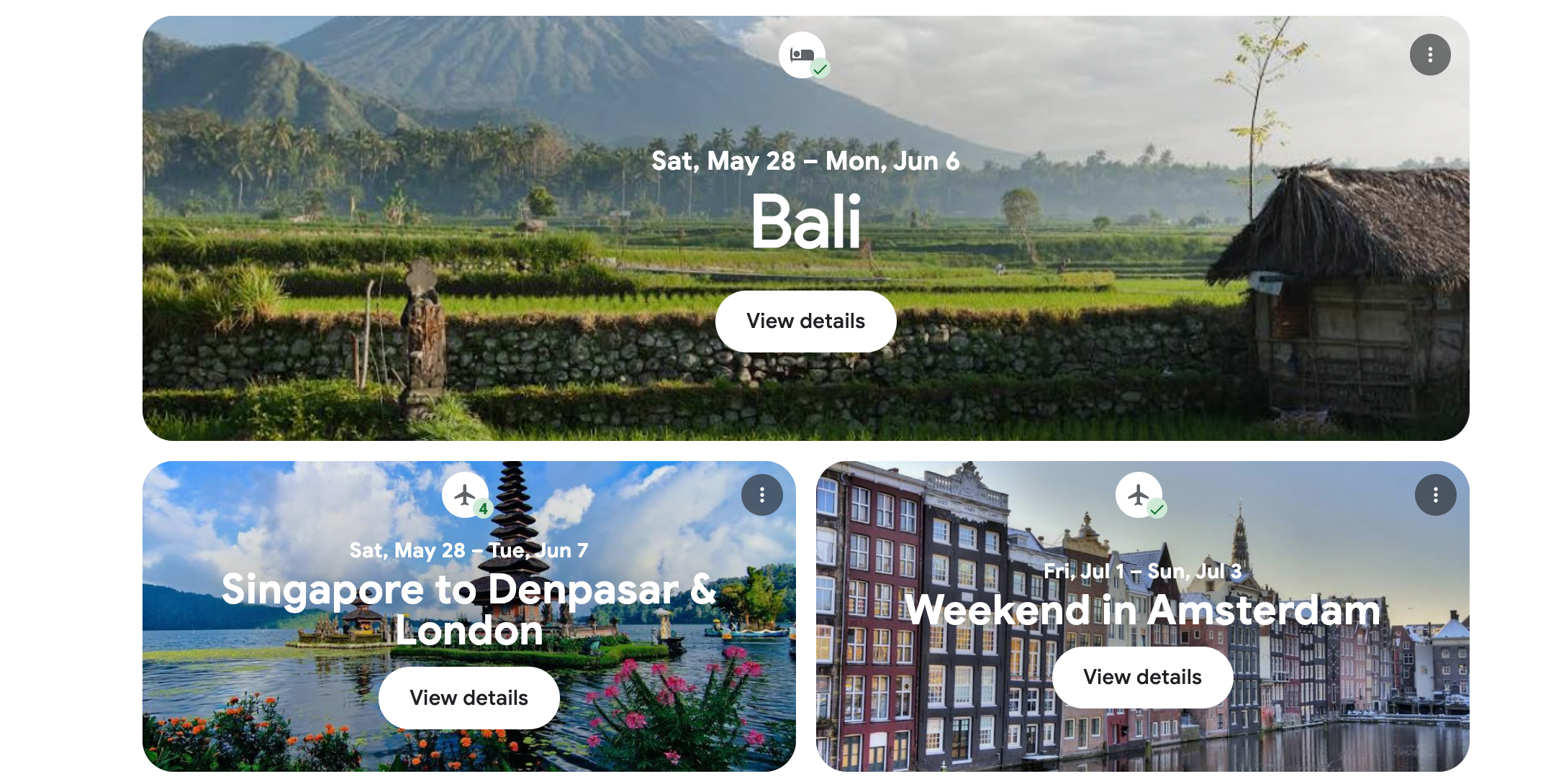
It will also show "potential trips." This is where you may have been searching Google Flights for a particular destination but have not yet bought the ticket. Additionally, it will provide suggestions based on what destinations you've Googled in general.
Perhaps you have searched for " When is the best time to visit Hawaii ?" Google Flights may show you suggestions to help you continue planning that trip.
Finally, the "Travel" button will suggest trips you might consider taking based on upcoming trips you have booked or trips you've taken in the past.
For example, if you've been to Melbourne, Australia, it may show options to visit Sydney.
Related: The best ways to use points and miles to fly from the US to Australia
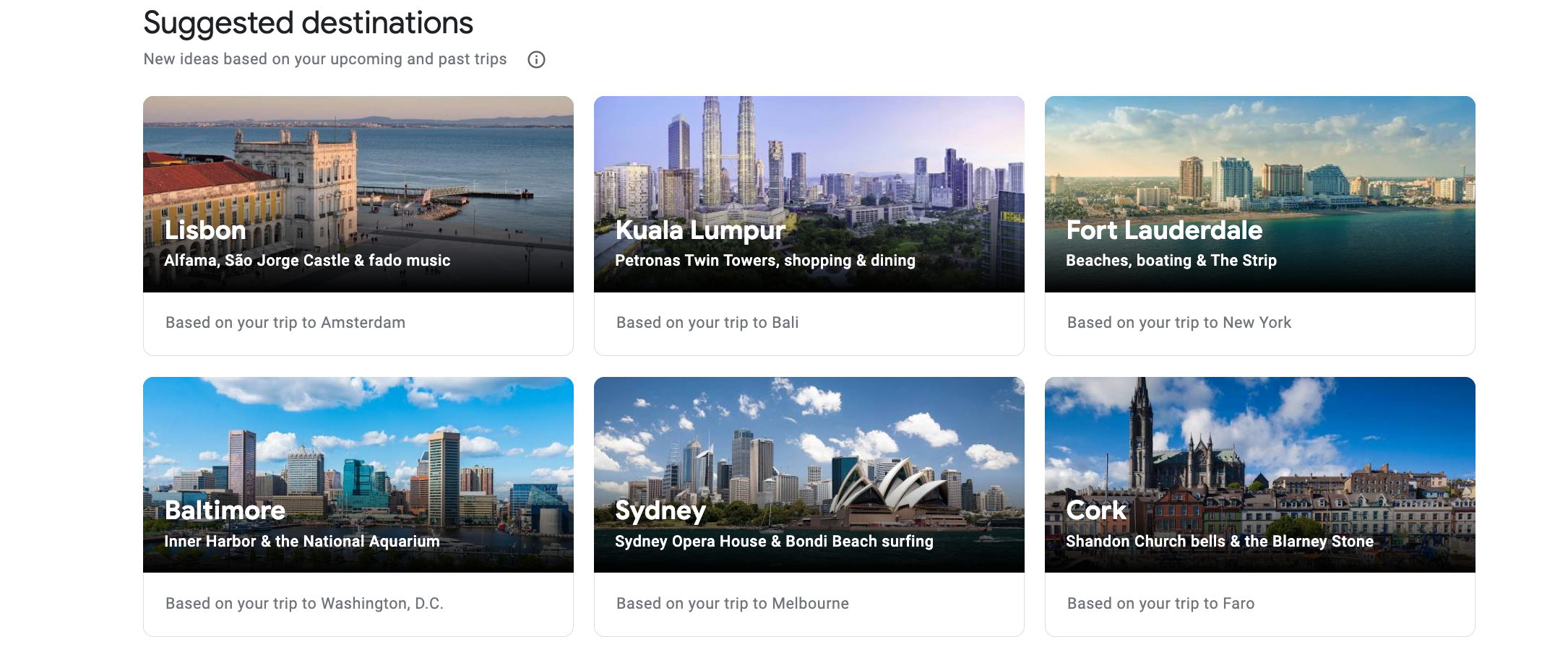
How to find the best getaway deal
This function is similar to the previous tip but focuses on another aspect of your search. Start by clicking the "Explore" button on the toolbar.
If you know you want to get away on specific dates — let's say the second week of October — but don't have a specific destination in mind, use Google's open-ended search functionality to find good flight deals within your window of availability.
In the example below, I picked a long weekend in October and set my hometown of New York as my departure airport. Instead of specifying a destination, I just left it open-ended. You can give Google a hint by typing "Europe" or "Caribbean" to narrow your search results to a specific region.
Related: 9 awesome features you didn't know about in Google Flights
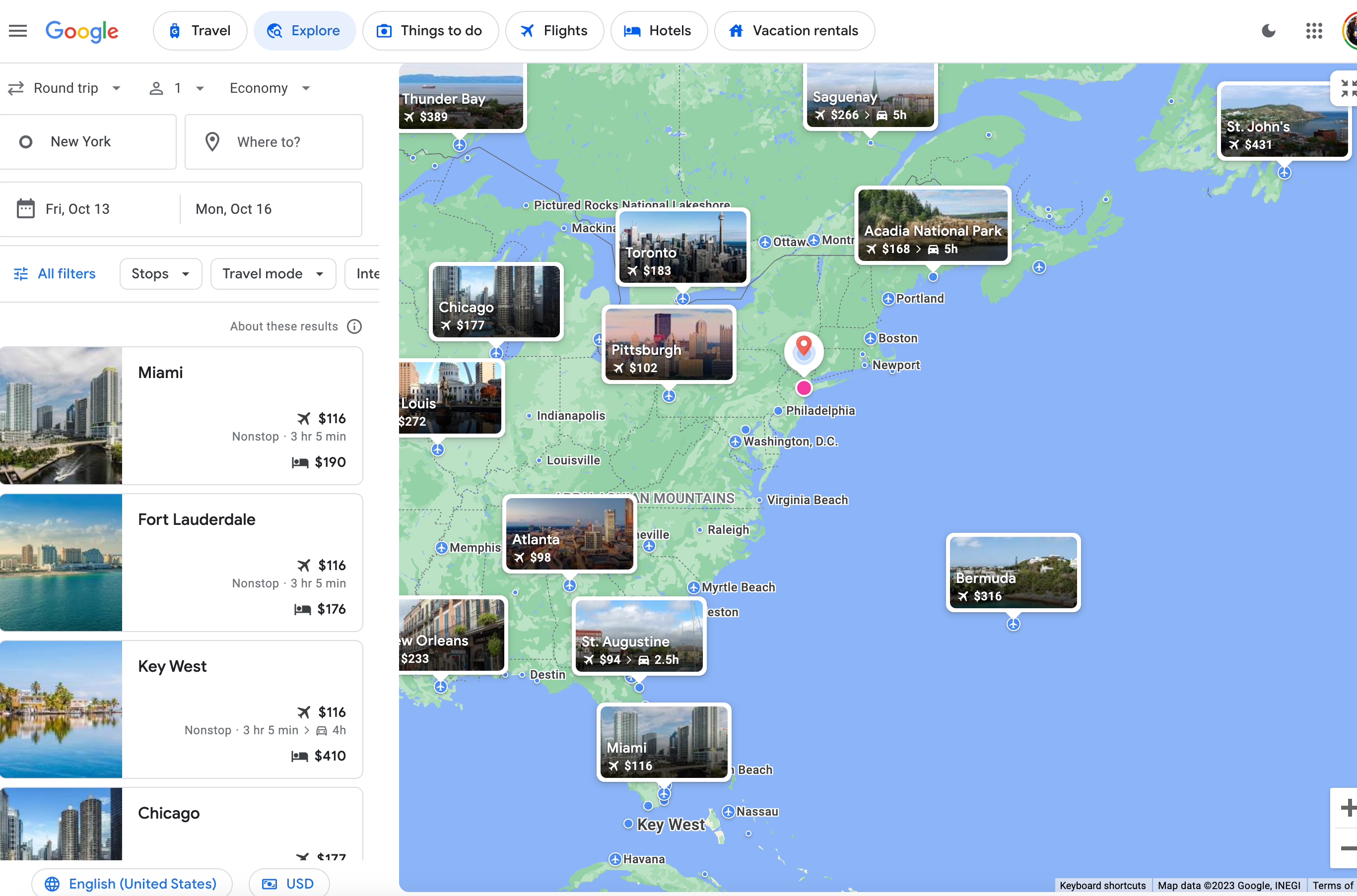
If I zoom in closer on the map, the system recalibrates and shows me more destinations and price points within the updated map view.
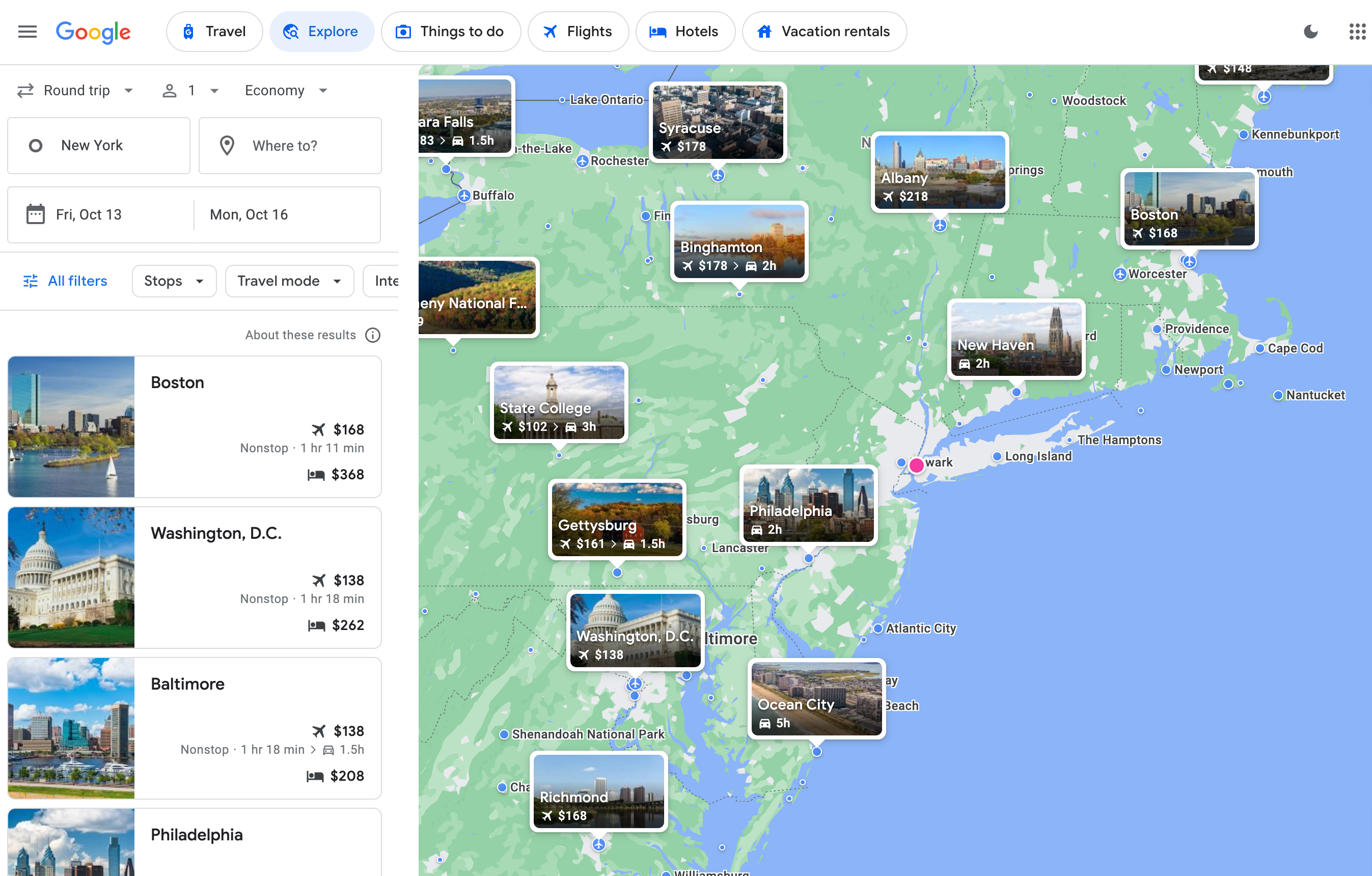
If I zoom way out for a world view, I'll see the best-priced destinations of note across the globe.
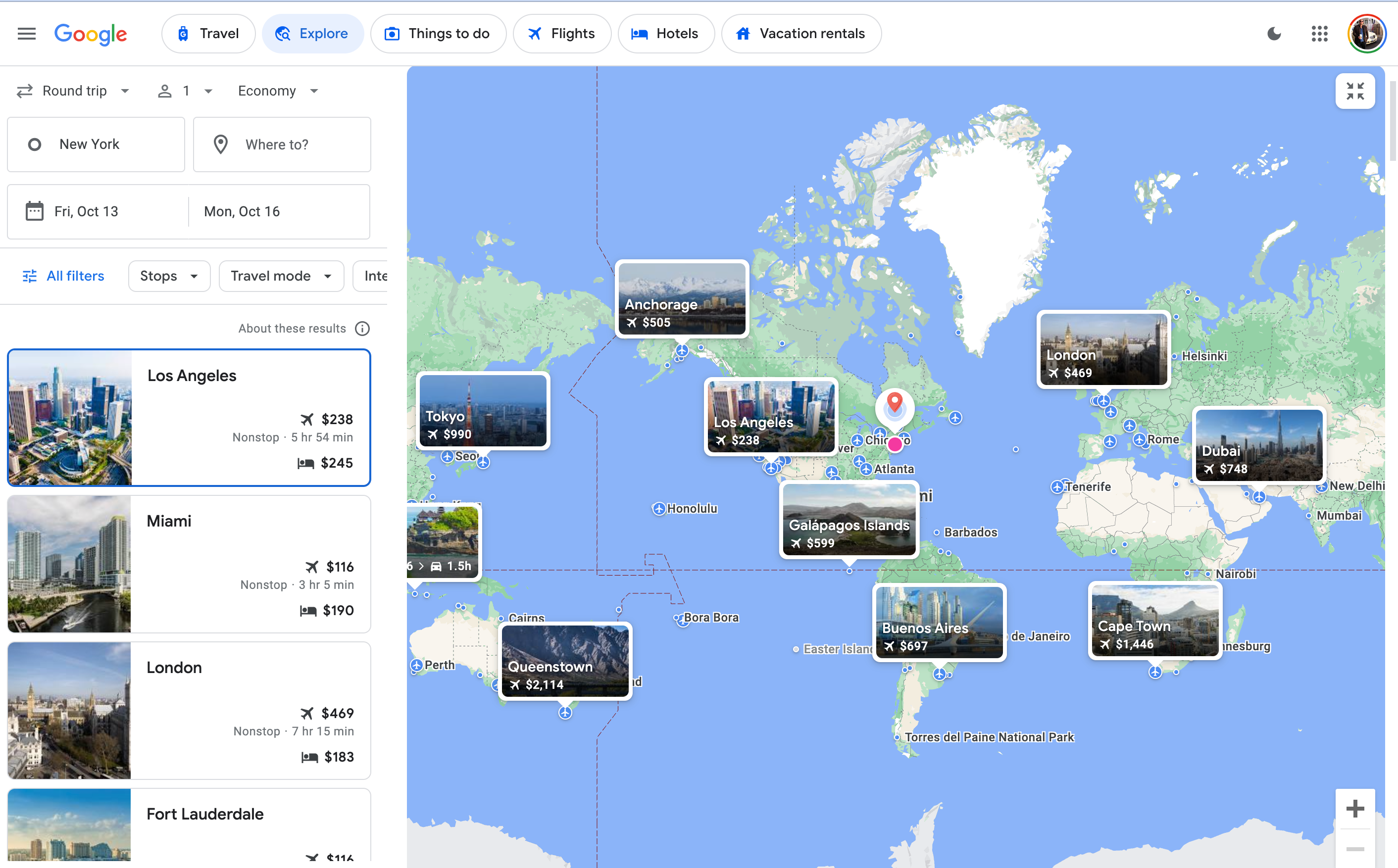
I can also force the algorithm to show me price points for a specific region.
For example, the world map above doesn't show me many deals for Australia, South America or Africa. However, if I zoom in on Africa, I see more than half a dozen options on the continent and more than a dozen in "surrounding" areas.
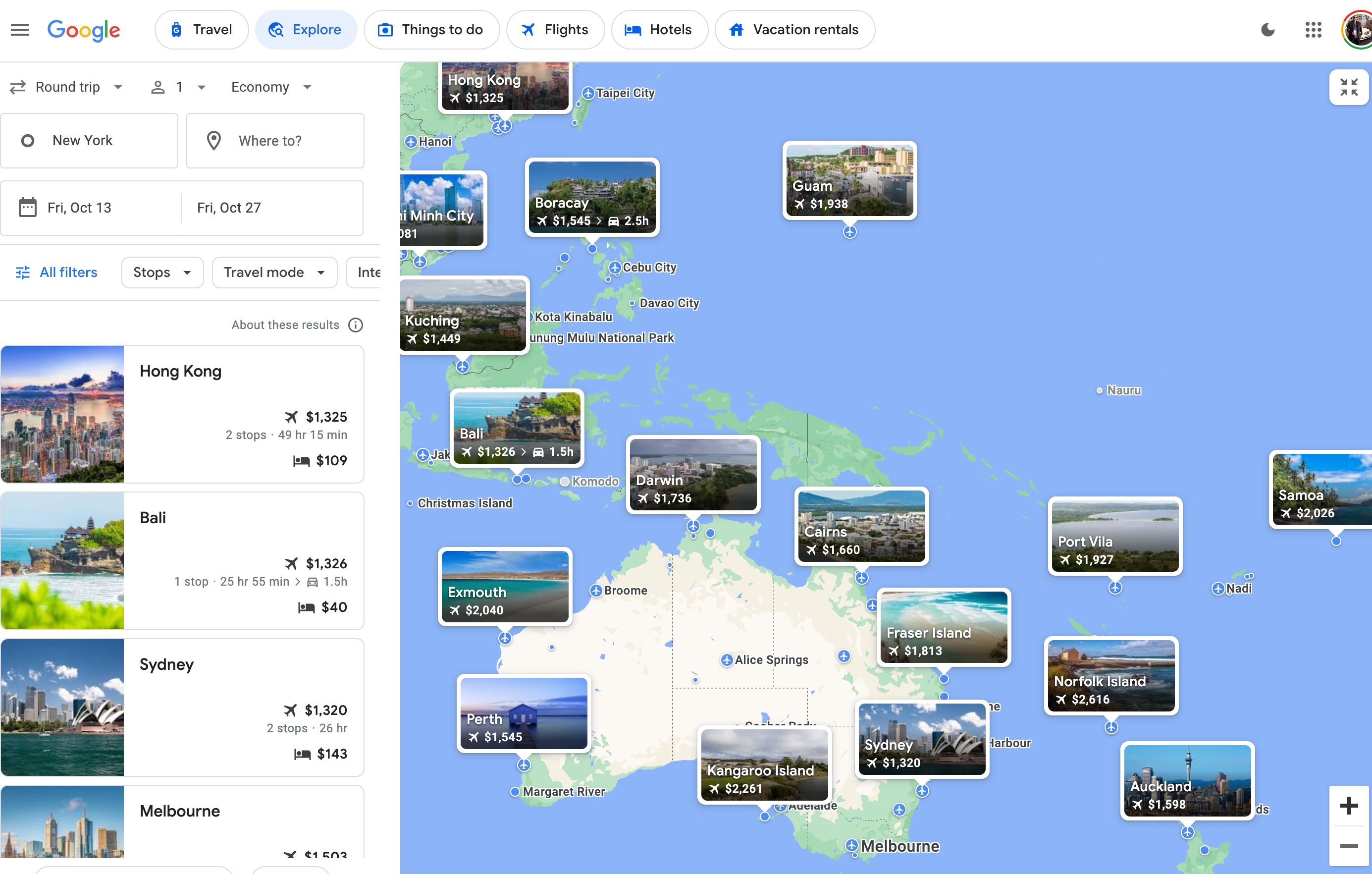
Related: Safaris, cities and lots of elephants: How I returned to South Africa using points, miles and cash
Bottom line
Google Flights is an incredibly powerful tool the TPG team uses daily to price airfare . It can help you quickly find the best flights for your travel, but it can also track prices and let you know if you are getting a good deal. It can also help you plan trips and find hotels and activities.
It's one of my favorite tools to find deals and new places to visit. Add it to your travel toolbox. I promise it will become one of your favorites, too.
Related reading:
- Key travel tips you need to know — whether you're a beginner or expert traveler
- The best travel credit cards
- The 18 best places to travel in 2023
- 6 real-life strategies you can use when your flight is canceled or delayed
- 8 of the best credit cards for general travel purchases
- 13 must-have items the TPG team can't travel without
Google is reportedly cracking down on employee travel, telling managers to nix happy hours and other team meetups
- Google plans to limit employee travel only to "business critical" trips, according to The Information.
- The company, usually known for its perks, reportedly said that social functions and team offsites shouldn't be approved.
- The move comes as Google and other tech companies cut spending to prepare for a potential economic slowdown.

Google is reportedly tightening its belt when it comes to certain employee perks.
The tech giant sent an email to some senior managers, telling them to limit employee travel only to "business critical" trips, according to a leaked internal email seen by The Information.
Related stories
Google's top brass reportedly told executives that moving forward, there would be a "high bar" for what is considered critical travel. Social functions, team offsites, and travel to in-person events that offer a virtual option should no longer be approved, The Information reports.
In a statement provided to Insider, a Google spokesperson confirmed they "recently shared guidance about taking a responsible approach on expense management, including travel and events. Different Product Areas and functions are implementing this in a way that works best for their teams, given their business needs."
Google, which gained a reputation over the years for offering its employees enviable perks like free meals, alcohol, and on-site gyms, has joined many tech companies in cutting back on spending as it prepares for a potential economic slowdown.
Insider has reported that during a recent company all-hands meeting, CEO Sundar Pichai expressed a desire to "simplify the company" and improve employee productivity.
On Tuesday, Pichai told attendees at this year's Code Conference that he wants to make the company 20% more efficient, and that may involve headcount cuts, CNBC reported .
On February 28, Axel Springer, Business Insider's parent company, joined 31 other media groups and filed a $2.3 billion suit against Google in Dutch court, alleging losses suffered due to the company's advertising practices.
- Main content
Google Restricts Employee Travel to ‘Business Critical’ Trips
Google is clamping down on employee travel, telling some senior managers late last week to limit travel to “business critical” trips, according to an email to managers that was viewed by The Information. The move is a sign of how tech’s once free-spending ways are being discarded as even the most profitable and cash-rich companies take steps to operate more efficiently amid a more difficult economy.
The company told managers it will hold a “high bar” for what should be considered business critical travel. Social functions, full-team offsites and employee travel to in-person events that have a virtual option shouldn’t be approved by Google managers, the email said.
Google Is Cutting Back on Corporate Travel for Workers – Report
Matthew Parsons , Skift
September 8th, 2022 at 6:46 AM EDT
We last heard expressions like essential and business-critical travel only during the lows of the pandemic, when companies ceased travel to protect their employees. It's not the sort of language the travel industry wants to hear right now.
Matthew Parsons
Google is cutting back on employee travel and wants to limit any trips to “business critical” only, according to a report .
A leaked memo has reportedly warned that any social functions, full-team offsites and employee travel to in-person events that have a virtual option shouldn’t be approved by Google managers.
Google did not respond to Skift’s request for comment.
The company also told some of its senior managers that it will hold a “high bar” for what should be considered business critical travel.
In a statement provided to The Information, Google said: “We recently shared guidance about taking a responsible approach on expense management, including travel and events. Different product areas and functions are implementing this in a way that works best for their teams, given their business needs.”
Should alarm bells be ringing? After all, terms like “essential” and “critical” travel were last used during the peak episodes of the pandemic.
Many technology companies have been slowing down their recruitment, amid lower growth forecasts and lingering concerns of a recession. In August, Microsoft also planned to reduce spending on business travel and employee gatherings, according to a Wall Street Journal report .
But at the same time, company offsites, retreats and social gatherings are being regarded as a key driver of travel.
“So many companies now have more distributed teams, across cities, across regions and across countries,” said Paul Abbott, CEO of the American Express Global Business Travel — which counts Google as a client — at Citi’s 2022 Global Technology Conference on Sept. 7.
“If you want to succeed as a company, you want to strengthen your culture, you want to motivate people, you want to recognize and reward people, you want to drive innovation and creativity, you’ve got bring people together,” he added. “That will create more travel, and we are seeing that today.”
Abbot also revealed that the agency’s meetings and events division was seeing the organization of meetings of under 50 people was now the fastest recovering part of its business.
“There’s a new generation of business travel coming from distributed teams, and I think that will continue,” he said.
Conservative Approach
Google’s retreat is typical of the wider sector, according to Steve Reynolds, founder and CEO of corporate travel rebooking and auditing platform Tripbam. He has long argued that technology companies have been more cautious than most. In June its data, which covers 2,500 clients, was showing technology companies had not yet fully resumed travel with volumes at 50 percent of pre-pandemic levels, compared to most other sectors that had reached 80 percent.
“While we can’t speak to Google’s policies specifically, we have seen that technology compared to other industries has been more conservative with their travel than they were pre-pandemic,” he said.
As companies plan for the remainder of the year, Reynolds argued that many may have overstretched themselves earlier this year when traveling became easier, but airfares and room rates rocketed.
“The need for companies to restrict travel closing out the third quarter is something we’ve anticipated since the start of 2022 — you have higher-than-expected volumes combined with higher pricing on airfares and hotels, and most travel managers set their 2022 budgets at 50 percent of 2019 levels. It’s no surprise that budgets are being stressed,” he added.
Alaska Airlines has also previously pinpointed a sector that’s been slow to pick up . That sentiment doesn’t appear to have altered, according to one senior exec.
“I think the least recovered for us are the large corporates,” said Shane Tackett, chief financial officer and executive vice president of finance, speaking at Cowen’s Global Transportation & Sustainable Mobility Conference this week. “And certainly, tech is probably the least amongst them. But not doing quarterly, it’s just they are the ones that are sort of lagging the rest.”
Meanwhile, one expert has questioned the raft of industry surveys and reports that relay a pent-up demand to travel.
“While many talk of a desire to return to travel in great numbers, on reflection they are often reminiscing about travel as it used to be pre-pandemic,” said Chris Pouney, owner of Severnside Consulting, citing ongoing airline strikes and delays.
“The way the storm clouds of inflation and poor travel experience are gathering, and companies having to stare down the barrel of a recession, it doesn’t surprise me that companies are starting to pull back on travel,” he added.
This article was updated to include comments from Alaska Airlines, Tripbam and Severnside Consulting.
The Daily Newsletter
Our daily coverage of the global travel industry. Written by editors and analysts from across Skift’s brands.
Have a confidential tip for Skift? Get in touch
Tags: business travel , corporate travel , google , microsoft , travel management
Photo credit: A leaked memo has reportedly said that social functions, full-team offsites and employee travel to in-person events that have a virtual option shouldn’t be approved by Google managers. Zeyi Fan / Flickr
- English (CA)
- Deutsch (DE)
- Deutsch (CH)
The complete guide to corporate travel policies
A guide to corporate travel policies, how to improve travel policy compliance with travelperk, what is a travel policy.
- Booking procedure and approved corporate travel company
- Allowable cost of booking (hotels, airfare, ground transportation)
- Special exceptions or rules for more expensive cities or routes
- Preferred company vendors
- Approval process for trips that exceed typical limitations
- Reimbursement process
- Permitted and not permitted expenses
- Travel debriefing process
- Travel insurance carrier
- Duty of care vendor or procedures
Why create a business travel policy?
Benefits for travelers.
- Flexibility and autonomy to book their own travel within guidelines
- Safety first! (Travelers’ whereabouts are tracked)
- Reduce confusion and hassle with travel booking
Benefits for the company
- Reduce spikes in travel spend and gain control
- Reduce friction and frustration over expenses and reimbursements
- Reduce total costs on business travel and optimize your company's budget
- Increase fairness and foster a positive company culture
What should be included in a corporate travel policy?
?)
Start writing your own corporate travel policy with our comprehensive template
Lodging policy guidelines, travel and entertainment policy guidelines.
- Spending limits for meal expenses (either on a per meal or per day basis)
- Rules on what is allowed when employees are entertaining clients (meals, alcoholic beverages, etc)
- Clear instructions regarding situations where alcohol can and cannot be expensed , and a maximum amount that can be spent on alcohol per head
- List of unallowable personal expenses, such as laundry services, mini-bar charges, and personal phone call charges
- Instructions on information, original receipts, and other documentation required in order to process reimbursements
Air travel policy for employees guidelines
Guidelines for business class bookings, guidelines on using business frequent flyer miles for personal use, common challenges with travel policies.
- Travel policies are difficult to understand
- No one reads them or remembers them
- Travel policies are not enforced using technology
- Travel policies come across as overly bureaucratic
How to market your corporate travel policy
Make sure that your corporate travel policy is visible and accessible, create a comprehensive faq, encourage employee feedback, travel policy problems by the numbers.
- 64% of millennials understand their company’s travel policy but still book outside of it.
- 72% of businesses haven’t met their desired level of travel policy compliance.
- 50% or more of hotel bookings are outside of corporate policy.
How to bake your policy into the booking process
- How to write a travel policy
- Best practices for travel policies
- A travel policy template
- How to improve policy compliance
- How you can automate a travel policy
Achieving 100% travel policy compliance has never been so easy
What to consider when creating a business travel policy for startups, “bleisure” travel, younger employees may prefer to self-book travel, alternative lodging options.
?)
Make business travel simpler. Forever.
- See our platform in action . Trusted by thousands of companies worldwide, TravelPerk makes business travel simpler to manage with more flexibility, full control of spending with easy reporting, and options to offset your carbon footprint.
- Find hundreds of resources on all things business travel, from tips on traveling more sustainably, to advice on setting up a business travel policy, and managing your expenses. Our latest e-books and blog posts have you covered.
- Never miss another update. Stay in touch with us on social for the latest product releases, upcoming events, and articles fresh off the press.
- Business Travel Management
- Offset Carbon Footprint
- Flexible travel
- Travelperk Sustainability Policy
- Corporate Travel Resources
- Corporate Travel Glossary
- For Travel Managers
- For Finance Teams
- For Travelers
- Thoughts from TravelPerk
- Careers Hiring
- User Reviews
- Integrations
- Privacy Center
- Help Center
- Privacy Policy
- Cookies Policy
- Modern Slavery Act | Statement
- Supplier Code of Conduct
- Help Center
- Google Business Profile
- Privacy Policy
- Terms of Service
- Submit feedback
All Business Profile policies & guidelines
Our policies and guidelines help maintain a positive experience for everyone who uses Google products. Links to all of our Google Business Profile policies & guidelines are below.
Important: When violations occur, we’ll take necessary steps to restrict the content from displaying, or restrict access to the profile or merchant account.
- Overview of Google Business Profile policies
- Business eligibility & ownership
- Guidelines for representing your business on Google
- Prohibited and restricted content
- Supported countries/regions
- Photos & videos policies
- Posts content policies
- Messaging guidelines
- Business links policies & guidelines
- Understand product approval
- API policies
- Third-party policies
- Website-builder policies
Need more help?
Try these next steps:.
- Travel Advisory
- Travel Podcasts for Covid Times

Corporate Travel Management Blogs
7 corporate travel policy templates to help you define.

Sajit Chacko Co-Founder

A corporate travel policy template can be a valuable tool to help companies define their policies and ensure that all employees are compliant with the company’s expectations. With a template, companies can quickly create a customized document that will ensure their travel policy meets all legal requirements as well as any other specific needs of the business.
For a business to implement a trip, it must first select and purchase the most economically viable choices for flights and accommodations. Apart from flight tickets and stay, incidental expenses commonly include trip aspects such as food, gifts to customers, newspapers, laundry services, value-added hotel services, dining charges, events tickets, local commutes, room service, and long-distance calls.
By 2022, global corporate travel spending was expected to amount to over US $930 billion, emphasizing how expensive it can be to secure these expenses and successfully conduct a feasible business trip.
Additionally, it is worth noting that planning and implementing these trips through traditional expense management systems makes it more expensive, tedious, and time-consuming than it needs to be. Due to the lack of transparency and restrictions of these systems, it is often a challenge for companies to track these non-budgeted expenses until post-trip reconciliation.
By this time, it’s too late, and the employee already charges the costs to the enterprise. For a company to maintain a trip’s economic feasibility, it is crucial to establish the appropriate cost-cutting measures well before the trip’s planning phase takes place.
A well-written company travel policy can be instrumental in achieving this by providing businesses and travel stakeholders the means to reduce, streamline and curb associated corporate travel costs.
Studying the approaches leading organizations have taken to address their corporate travel and employee needs is an excellent way for aspiring businesses to devise their corporate travel strategies.
Make sure to emphasize the perks of following your policy for travelers, like keeping them safe and providing support, so they understand why it’s important.
This article aims to provide businesses with seven market-tested robust templates that they may leverage as inspiration to create a winning corporate travel policy.
Before you begin, it is essential to understand what a business travel policy is and what it can help your business achieve.
What is a corporate travel policy?
A business’s travel policy is a set of regulations and parameters set by business leaders to effectively manage travel bookings and expenditures when employees travel to visit partners, sites, prospects, clients, colleagues, and conferences.
This crucial document contains information on the extent of expense coverage and considerations that travelers must follow when making flights, accommodation bookings, and incidental expenses during all travel phases.
For an employee to secure timely T&E reimbursements, it is an absolute must to abide by the rules and guidelines this policy sets.
Best Corporate Travel Policy Templates
To help you understand these policies better, let us take a look at seven well-established organizations and their take on corporate travel:
Netflix, the world-renowned streaming platform’s travel policy, is a reflection of its organizational work culture and merely states, ‘Act in Netflix’s best interest .’ These five worded simplistic travel policies provide employees an elevated level of freedom, control, and responsibility over planning and implementing their corporate travel than most other companies.
Instead of restricting employees with a stringent corporate travel policy, Netflix enables its employees to make their own travel decisions how they see fit as long as they conduct themselves in the company’s best interest and continue to drive value to the organization. Employees are free to take vacations without restrictions on the number of days a year.
The goal here is to give employees the freedom to use their best judgment and make wise decisions by understanding the context of what management considers appropriate and inappropriate without imposing strict guidelines.
This policy is enforced by a lead-by-example approach where Netflix’s leadership takes vacations that are also productive for the company.
Although this famous policy may not be suitable for all organizational types, it is still worth studying to gauge if any aspects of it may benefit you.
While Basecamp’s policy follows a similar approach to Netflix’s, it is not nearly as simple. Basecamp instead takes it one step further by providing all employees with an American Express card that they can use without restrictions or approvals.
The only criterion this highly trust-based approach expects from its employees is to be reasonable regarding the expenses they charge to the company account. It is a tricky system for businesses to implement as it requires high transparency of documented transactions for finance departments to ensure that expenses are justifiable.
Basecamp additionally offers its employees perks such as monthly capital allowances for recreational and fitness activities such as massages, yoga, and gyms.
The British Broadcasting Corporation (BBC) follows a traditional travel policy that provides its employees with informative and simplistic documentation of its policy coverage. This travel policy provides guidelines on all travel categories and transparent information on what expenses qualify for reimbursements.
Being a sustainable corporate travel policy, it encourages employees to prioritize public transport, preferably rail, to reduce the company’s environmental impact. The expense policy also dictates using communication tools such as Telepresence, Skype, and other video conferencing options as an alternative means to conduct business to travel whenever possible.
When air travel is unavoidable, the expense policy asks employees to make all flight bookings through BBC Travel & Delivery. The policy also requires travelers to obtain formal pre-approvals from the Divisional Finance Director for all bookings.
If group bookings exceed ten travelers, the tickets must be procured well in advance with the BBC’s preferred suppliers and vendors. The company allows personal travel to be combined with business travel only if it reduces the cost of travel to the company.
Employees must book the lowest-priced economy-class tickets regardless of the airline. Travelers may book premium economy tickets if their flight duration exceeds six hours and are expected to work immediately upon arrival.
Business-class tickets are reserved only for employees that have to travel over eight hours and are required to work immediately upon arrival. First-class tickets are entirely out of the question for employees and not covered under the company’s travel policy without any exceptions.
The company vigorously enforces these rules and carefully monitors upgraded tickets. Employees are encouraged to stay in private accommodations, for which they can claim £20 per day, including food. Employees can claim reimbursement of incidental expenses such as personal calls and basic laundry when their official stay duration exceeds seven nights.
The expense policy for meals states that employees may claim up to a contribution of £6 per meal inclusive of taxes within working hours and £16 for any meals for work conducted after 8 pm. Employees must produce receipts for every meal and detail them individually in the Concur claim form.
The BBC also allows employees to visit theatres and other cultural locations, provided they can assess talent and generate potentially lucrative ideas for the company.
In such instances, the employee may purchase a single ticket reserved for themselves. They must also provide appropriate reasoning for their visit in the claims form to get reimbursed.
For local commutes, the BBC’s corporate travel dictates that the usage of cabs is permissible only for business purposes if it is the cheapest available mode of transport. When such a requirement arises, the ride cost should not exceed £100, including all waiting time, booking fees, trip costs, and miscellaneous costs, unless it is the cheapest transportation option available.
Employees traveling by cab must prove that they are commuting for work by filling out a passenger declaration form. When a cab ride for official work exceeds a distance of forty miles, the company will deduct it from the employee’s salary.
If it is the cheapest option, employees may engage in personal commuting for official business purposes. Their travel policy allows employees to acquire reimbursements for any fuel consumed during the commute, provided the traveler submits the appropriate receipts to the company detailing the business purpose of the journey.
The BBC also allows employees to submit claims for car parking and toll costs as long as they are reasonable and if they occurred while conducting official business.
Federal Express, a global air freight network, provides reliable, prompt, time-definite delivery to over 200 countries and territories around the globe. As an international company that conducts its operations in numerous geographical locations, it formulated an iron-clad corporate travel and expense policy template that leaves no room for doubt for its employees on its coverage.
All business travel ticketing, including airline tickets, rail tickets, hotels, and rental cars, must be booked through FedEx’s authorized travel agency or tools. Traveling employees are permitted to use only economy class, although travelers are allowed to use Business-class if the total travel time exceeds six hours.
Flying First-class is reserved only for the company’s President and Vice Presidents.
FedEx Corporation has a preapproved list of hotels offering discounted corporate rates for their traveling employees across the globe. Employees may book a stay at a non-preferred hotel only when preferred hotels are busy or unavailable.
The corporate policy dictates that all employees must use the least expensive transportation option available such as public transportation, free shuttles, or personal vehicles, with the use of rental cars reserved only when it is cheaper than public transport and economically viable.
Upon using a rental car, travelers must utilize it optimally with other team members to reduce the overall transportation cost to the company. Upon trip completion, the original receipts and rental agreements must be submitted to the finance team at FedEx for approval.
Its corporate policy requires employees to carefully retain all receipts and submit expense reports trip-wise or weekly basis. FedEx remains clear that non-adherence to its corporate policy can lead to employee termination, depending on the circumstance.
Dartmouth College
Dartmouth College’s corporate policy template is a comprehensive document that clearly defines all allowed and disallowed expenses to keep employees clear on their expense limitations.
It details the penalties one might face when one fails to abide by the policy. It may not be a simple playbook, but it was designed specifically for the educational institution and its employees.
Dartmouth College recommends that all traveling employees who travel at least once a year obtain a corporate card for their travel expenses. Its policy dictates that employees book airway tickets through the Dartmouth travel portal.
Employees not possessing a corporate card may acquire advances to cover incidental costs for a maximum daily limit of US$50 as long as they provide a valid justification for it accompanied by proper receipts. These advances must be requested at least ten business days from the travel date and under no circumstances should be used to cover personal expenses or activities.
Non-compliance or abusing the Dartmouth travel policy will result in the Dartmouth Controller’s Office revoking the traveler’s advance privileges.
The educational institution’s policy requires employees to choose the least expensive flight tickets, factoring in reasonable comfort and convenience requirements. It also encourages employees to leverage Dartmouth College’s contract with Travel Leaders to ensure they book the lowest fares.
A significant employee benefit of the T&E policy is that travelers can personally retain the frequent flier points they accumulate through the corporate travels they can redeem for personal benefit. These benefits do not include any membership fees the employee may pay to join the frequent flier club.
Employees are allowed to book business class tickets when the travel time exceeds five consecutive hours in duration or during exceptional circumstances subject to the approval of the Dean, President, Vice President, Board of Trustees, or Provost.
Value-add-ons such as preferred seat selection and baggage fees are deemed acceptable per the policy, provided they are reasonable.
This company has a simple, transparent, and easily adaptable policy template that businesses can use as a starting point for writing their corporate travel policy. Businesses must download the customizable policy template from Workable’s company website and alter it based on their unique organizational travel requirements.
The policy requires employees to contact the office manager, HR generalist, or finance manager for travel-related bookings. The robust approach requires employees to utilize their best judgment while on their trips and submit all travel-related invoices post-trip completion.
In their policy, a ‘business trip’ is any trip whereby an employee travels to a city different from where they typically work to conduct official business. The policy recognizes employee travel for client meetings, lectures, presentations, events, conferences, off-site company locations, and research trips as reimbursable.
In such instances, all car, bus, or train commutes employees take that exceed an hour in travel time are also considered reimbursable business trip expenses. The policy does not consider daily work commutes of employees as a business trip regardless of how far they have to travel to get to the office.
It dictates that traveling employees are eligible to book a premium economy ticket, while Executives can book business class. Employees who utilize alternative means of air transport, such as boats, coaches, and trains, are eligible to reserve premium seats to and from their destination.
Although, Workable’s travel policy does not cover any value-added services or extra baggage. The policy mandates that employees seek written approvals from their respective managers and book travel tickets and accommodation at least two weeks before the travel date.
However, the policy facilitates flexibility for unforeseeable circumstances where the need for travel is unexpected.
Traveling employees are allowed to travel by their personal vehicles or taxis for their business trips. In the case of the former, fuel and toll bills, and for the latter, the cab fares, are reimbursable provided the employee provides the appropriate receipts. A rental car is a third option per the policy for trips permissible when employees travel to multiple destinations to conduct official business.
In such instances, the employee must book a basic two-four-door, compact, automatic transmission and petrol-powered automobile.
Employees are entitled to stay in three-star hotels or the best available accommodation available in the area, which will be paid for by the company. They are further encouraged to leverage business partnerships with hotels for discounted rates.
Pending approval from the manager, employees can upgrade rooms or stay at higher prices if they pay the price difference. The policy stipulates that the company will not pay for upgrades or value-added services.
Employees are also permitted to travel with a friend, partner, or family member if the extra member does not increase the travel cost to the company. In such cases, the policy requires the employee to pay in full for all additional expenses incurred that may arise due to the non-employee.
Workable’s policy allows employees to claim up to US$20 for meals, including lunch and dinner, during business trips. Client dinners also come under the policy’s coverage for up to US$150.
The traveling employee must acquire approval from Workable’s Chief Finance Officer (CFO) if the bill exceeds that amount.
Corporate Traveler
Although it’s not a readily usable travel policy template, it serves as a guide for businesses to deploy their T&E policy . It dictates the steps and important considerations when devising a robust policy for unique business travel demands. It focuses on streamlining the corporate travel process to reduce costs and keep travelers safe.
Employees are encouraged to use preferred suppliers and always opt for travel insurance. It motivates employees to avoid using business class or premium economy unless the flight time exceeds 10 hours.
Additionally, the policy encourages businesses to outline clearly and precisely to employees on all reimbursable and non-reimbursable expenses, including meals, per diems, and ground transport, amongst others.
Create and enforce your travel policy with Tripeur
Tripeur is a state-of-the-art travel management platform that simplifies the burden and responsibility of creating, updating, and enforcing your corporate travel policy.
Once you write your policy, our system eliminates compliance issues by logging all business travel expenditures in real-time. These logs actively give employees T&E visibility to inform them precisely on what travel expenses they are entitled to and their limitations.
Tripeur’s platform aims to help businesses overcome compliance issues by providing managers with the functionality of delivering WhatsApp and email approvals accompanied by automated expense reports. Through our system, management can instantly identify and mitigate any non-compliance in real time and enforce preventive measures to prevent future occurrences.
Our innovative and user-friendly product could be the solution to create a robust travel policy that can effectively handle the re-emergence of international corporate travel. Every tool you need to maintain compliance is readily available within Tripeur’s powerful platform.
Trying to figure out how to get better compliance with corporate travel policies? When you get Tripeur to book your business trips, it’ll link in with your travel policy. This makes it easier to spot when something isn’t following the rules and enables employees to make smarter decisions quickly.
For CFOs Consistent YoY savings by changing user behavior
For Travelers Superior experience for travelers with a virtual travel assistant
About Us Passionate about bringing the much needed change in Business Travel
It’s three-in-a-box corporate travel experience solution . Check it out
for Shared Services
Thresholds for business class travel, peeriosity insights: recent research findings summarized insights. to view detailed research results, contact us to inquire about membership..

With the move to control discretionary spending in recent years, many companies have significantly reduced their travel budgets. One opportunity to secure large gains in this space is by restricting business class travel, where the price difference for a single trip can be $4,000 or more. Given that the most powerful executives are often frequent travelers, setting the policy can be difficult, and there often is a threshold when an employee can book their trip in business class. And, since the majority of companies have a mix of local and global travel policies , creating policies that are consistently applied globally can be difficult.
Recently, a Peeriosity member from a large global company that didn’t permit business class travel wanted to understand the approach followed by peer companies, and also understand the mix of global and local policies for the travel process. To find out, the member created an iPolling TM question and within 48 hours they had their answer.
The poll results indicated that 78% of member companies allow travelers to book in business class with certain restrictions. For 22% it is simply a matter of job level, and for 56% an approval threshold is set based on either the trip duration or the distance traveled. Here are the details:
Results to the question about the scope of the travel policy were surprising, with 57% reporting that they have a mix of global and local policies, and just 35% reporting that travel policy is set and managed only on a global basis. Creating a consistent travel policy not only improves the efficiency of the travel process, but it can also reduce complexity for the traveler, as well as ensure a proper balance between business need for travel perks and the cost of the premium services.
Here are examples of some of the additional comments from Peeriosity members that were added when they responded to these questions:
- Previously, business class was open to all employees, regardless of status for flights longer than 9 hours. This policy has recently changed to be based on the employee job level , plus the flight needs to be longer than 9 hours.
- Business class travel is allowed when the total flight time of all segments of a one-way trip is at least 6 hours.
- Approval for business class travel is based on the employee’s job level and the frequency of international trips.
- Employees may use business class when the combined intercontinental flight connection exceeds 5,500 miles, or if the circumstances of the itinerary (e.g. multiple business stops) result in a fare equal to or lower than a coach.
- Officers may fly first class where offered and, if not, business class. All other employees must fly economy unless the flight exceeds a certain amount of time.
- Business Class is permitted for flights exceeding 5 hours, except when traveling within North America (the U.S., Canada, and Alaska), Mexico and Central America, or between the U.S. and the Caribbean.
- Business travel is permitted for VP-level employees traveling on international nonstop flights lasting 10 hours or more.
- We allow business class for travel over 8 hours. For trips over 12 hours in length, we allow travelers to downgrade to economy class for a one-time cash payment to the employee of $1,500 (before taxes).
Under what circumstances does your company allow employees to book airline tickets in business class? How consistent and how global is your company’s travel policy?
Who are your peers and how are you collaborating with them?
_____________________________________________________________________
“iPolling TM ” is available exclusively to Peeriosity member company employees, with consultants or vendors prohibited from participating or accessing content. Members have full visibility of all respondents and their comments. Using Peeriosity’s integrated e-mail system, Peer Mail TM , members can easily communicate at any time with others who participate in iPolling.
Peeriosity members are invited to log into www.peeriosity.com to join the discussion and connect with Peers. Membership is for practitioners only, with no consultants or vendors permitted. To learn more about Peeriosity, click here .
- My Favourites
- Travel Advice
Business class has changed, and these are the new rules you should be aware of
Burn your activewear, throw your AirPods in the trash and launch your loafers out of the nearest window: here are the new rules of business class in 2023.

This article may contain links from our affiliate and advertising partners. When you click on them, or share this content, we may earn a commission. Learn more

Should I use a credit card or travel money card in the US?

Never make this mistake in an Uber in Seoul
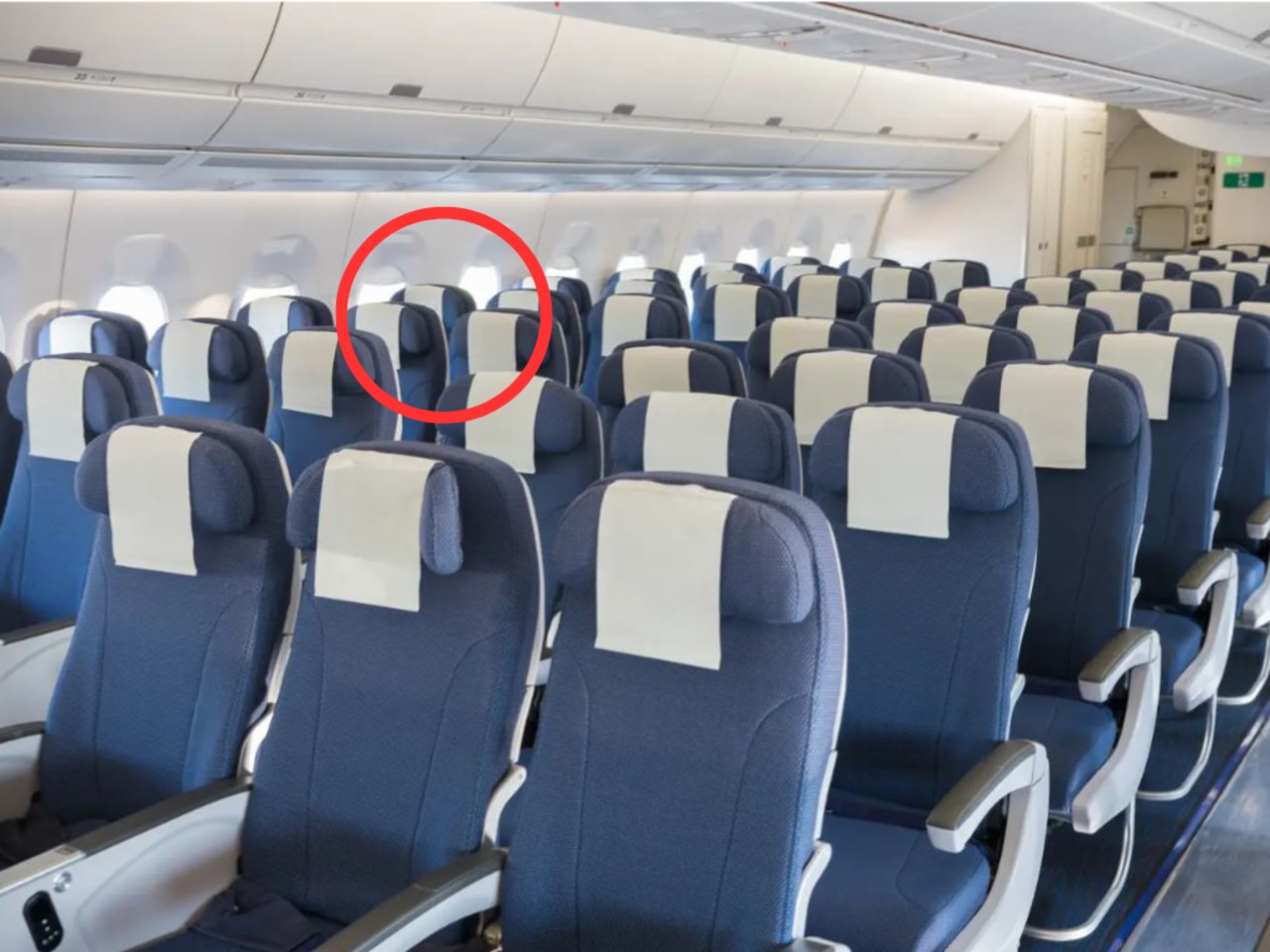
Seat you should always choose on a plane
All elements of travel have been streamlined in the wake of the pandemic. Business class is no different.
Business class has seen seismic shifts since the days of cigarettes and cigars. But it didn't stop evolving in 2019. Since the pandemic, the rules of the game have changed yet again. So shed your suit, burn your activewear, throw your AirPods in the trash and launch your your loafers out of the nearest window: here are the new scriptures for business class in 2023.
Don't dress up

Didn't you hear? Sneakers are the new dress shoes, yoga pants are the new jeans and suits are the new cargo pants. Not only does wearing a suit in business class mark you out you as someone who was fashionable 20 years ago, but it's uncomfortable and impractical. Worse: it won't get you upgraded. Take it from me - the world's leading authority on having a business class whinge - I haven't seen anyone wear a suit in business class in a very long time (let alone seen anyone wearing a suit get upgraded 'just because').
On top of that, expert upgrade artist Immanuel Debeer (the founder of Flight Hacks) has told me numerous times that it's a complete myth, this whole idea that dressing up gets you upgraded. He has even gone so far as to say that being overly prescriptive about what people wear in business class is a sure sign you have never flown business class (“How to tell if someone never flies business/first: they will tell you what to wear or how to dress”).
Don’t drink billions of bellinis
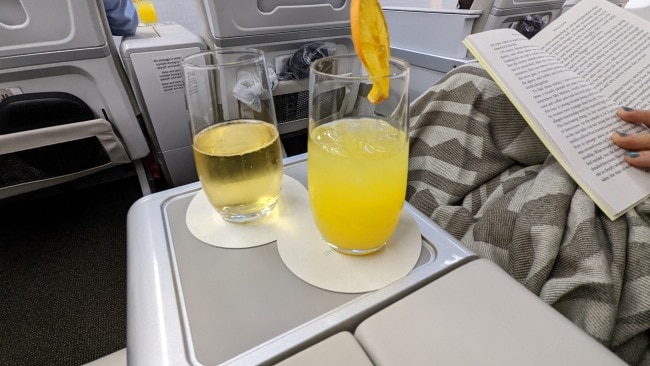
As tempting as it might be to treat your 6am flight like an 11am brunch with your favourite English and Irish mates (waxed legs and penchant for getting absolutely hammered included), it's not the best idea for your health, your flight attendants or your fellow passengers. So sorry señores, it's now 2023. Getting drunk in business class is officially uncool. You heard it here first.
Don't clean your bare feet with the hot towel
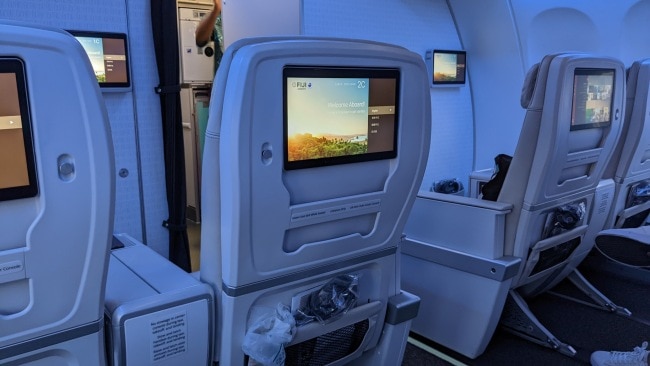
Especially not while the economy passengers are filing through, looks of horror, disgust and - is that a teensy bit of admiration for your sheer gall? - on their faces...
Don’t get angry if your nuts are served in a packet

It wasn't a good look for the (former) Korean Air Vice President Heather Cho when she lost the plot (and ordered the plane back to the gate) after being served nuts in first class in a packet rather than on a plate, and it's not a good look for you, either. Though you have a right to high quality service if you have paid a premium for business class, given how badly airlines were devastated during the pandemic, by now we should have all learned to cut them a little slack - or at the very least not vent out frustration on the hapless frontline staff. Shouting makes you look like a tool, even if you're in the right.
Don’t post a photo of your boarding pass on Instagram
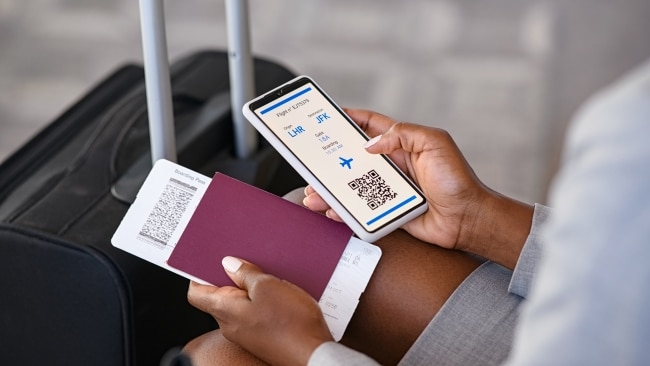
Security concerns and identity theft aside, this is super cringe. Please stop.
Don’t wear activewear in the lounge

This isn't because there is anything wrong with sweats or tights. As we've previously explained, in this day and age, dress codes and air travel don't mix. There's no excuse for telling anyone their body is "offensive to the assembled flying public" in 2023. However... some airlines will kick you out of their business class lounges if you rock up looking a certain way (as one ex WWE wrestler/fitness model found out in 2020 ). To avoid this, save the activewear for the gym.
Don't wear wireless in-ear headphones while you sleep

Don't be that guy. Seriously. They will fall out of your ears and you will lose them. You will then annoy other passengers in your search for them and have to ask the flight attendants for assistance. And the cold innards of your seat are unforgiving.
Don't ask other passengers to move

If you can't stand to be apart from your significant other, child or friend for the duration of a flight, then get organised and book seats next to each other.
Don't humble-brag about your Qantas pajamas

We get it: you flew business class once. And if you're going to brag about it, at least be straight up. Don't drop it into conversation trying to act all casual. I know what you're doing.
Don't expect a bar and a shower

Unless you're flying on an Emirates A380 (the large kind of superjumbo most airlines are replacing with more efficient narrowbody jets), don't expect a walk up bar at 40,000ft. The same goes for showers (which are a first class privilege, even on Emirates' A380).
Don't bother working
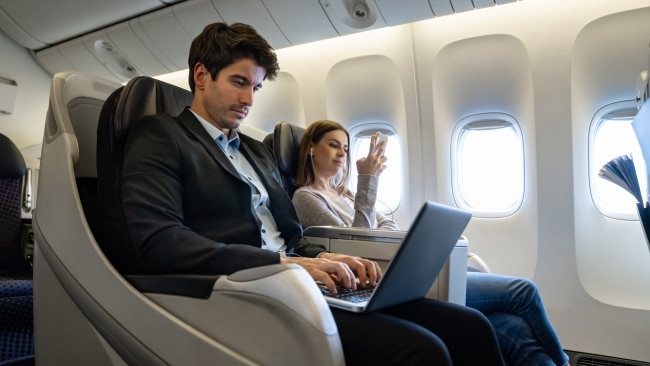
The 'suite-ification' of business class over the last decade means it's now all about getting in those sweet dreams (not logging into Teams). So just rest up, don't bother the rest of us with your keyboard clacking, and perform even better at your destination.
Don’t look too comfortable until the economy passengers have filed through
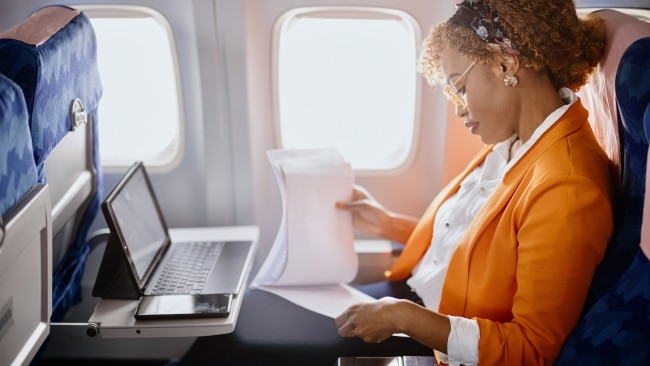
It's just rude. Pretend to be busy on your phone or laptop, or read a book. Leave the moaning and groaning about how good your seat is until you're alone with just your fellow pointy end passengers.
Don't post a 'slammertime' Instagram story

It might be tempting to follow online trends, but most of the time you'll look back at them and shudder. As is the case with the 'slammertime' business class trend that emerged in 2019/2020. This trend involved business class passengers skolling their champagne, filming themselves doing it, then tagging their mates to do the same. While I have no problem with you guzzling your glass, filming it is in poor taste, I reckon.
Don't overindulge

Luxury in 2023 is no longer about flamboyant excess. It's about wellness. Peace of mind. Wholesome feels. Classy - but understated - thrills. To match this (and to look like you fly business class all the time) don't feel the need to partake in every item of food or drink you are offered.
Don't break the circle of trust
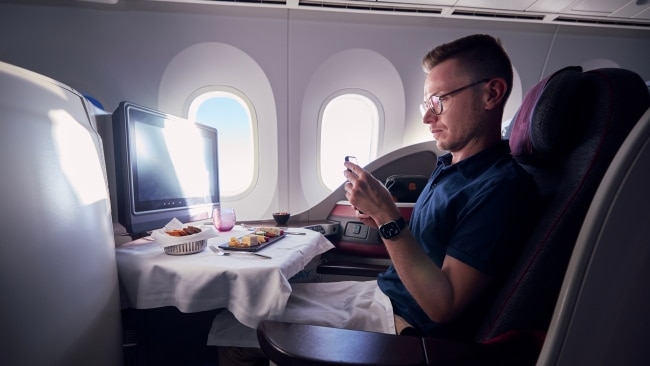
Many people enjoy flying business class for the privacy. So if you see a celebrity snoring with their mouth open, or a high flying CEO wobbling about after one too many glasses of Shiraz, don't film them and post it on Twitter.
Don't try and network

This is a sacred place. Please don't make me take off my noise cancelling headphones unless it's an emergency. Plus: there's no easy escape if things get awkward.
Don't assume airlines are begging for your business

More Coverage

They are well and truly back to squeezing you (and your frequent flyer points or flight credit ) for all you've got. Don't expect any favours, special treatment or random upgrades to first class any more.
Seat belt rules are not a suggestion
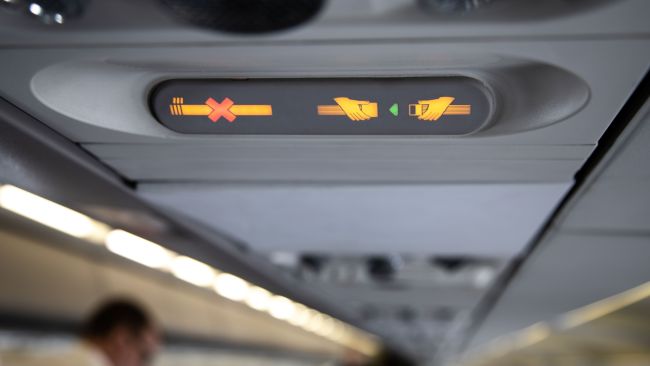
Gravity still applies in business class. So strap in, and don't make the flight attendants ask you twice. Oh, and vaping is still a crime in business class, too, just before you try and get away with that...
James has loved travelling ever since he went to Tasmania as a toddler and lost his favourite crayon (RIP, dadoo). He now spends his time posing with a hiking pack, surfing remote reef passes and complaining about losing his headphones in business class. His worst travel experience was being kicked off a train in Morocco, and his best travel experience was making friends with an Alpine Parrot in New Zealand (little did he know, it just wanted his food). His favourite thing in the world is to kidnap his close friends and take them on a weekend escape they never actually agreed to.
The US is a great travel destination, but what is the best way to avoid the pitfalls of a lousy exchange rate?
And here’s what else you need to know about travelling around the Korean capital.
If there’s one seat you should select when flying, whether it be long or short haul — experts say make sure it’s this one.
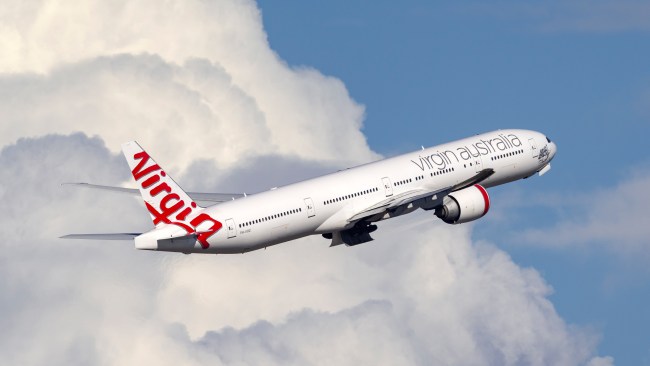
Best way to use 20,000 Velocity points
Escape’s points expert, Sabine Leroy, answers your questions about frequent flyer programs.
General Topics
What’s Meta’s travel policy?
I love Google’s policy to let us fly whatever whenever within a cap. How does Meta do business travel?
Is this for business reasons to other offices?
Are you moving to Facebook?
>4500 miles for business class
Yeah. Business reasons. Let’s say I gotta go to TEXAS to meet a vendor. Google says okay. Typical flights are $400 RT. Book whatever class or airline as long as it’s under $400. If you want biz class and it’s $425 you pay out of pocket $25 or use credits (which are earned when you fly UNDER cap)
2024 Presidential Election
WW3 might breakout..
Are there any Indian married couples living in the USA who are happy?
Personal Finance
How do you keep track of the statement deadlines of different credit cards?
Tech Industry
Am I being lowballed for staff level roles?
Straight men married to women: how many times….
- Share full article

Planning to Combine Business and Leisure Travel? You’re Not Alone.
As employees increasingly add leisure time to their business trips, companies are trying to figure out where their duty of care obligations begin and end.
Credit... Aart-Jan Venema
Supported by
By Amy Zipkin
- April 7, 2024
On a Sunday in late January, Melinda Buchmann, who lives in Florida and supervises client relations for RevShoppe, a 30-person remote company advising organizations on sales techniques and strategies, arrived in Banff, Alberta, to help set up a four-day company meeting.
The last day of the event, her husband, Josh, a director of strategic partnerships for the delivery company DoorDash , who also works remotely, joined her. They spent two leisurely days hiking in Banff National Park and visiting Lake Louise.
“I take advantage, because I don’t know when I’m going to return,” Ms. Buchmann said of the decision to combine downtime with a business trip.
As postpandemic work life has changed, and arrangements now include full-time office attendance as well as hybrid and remote work, so, too, has business travel. The phenomenon known as bleisure, or blended business and leisure travel, was initially embraced largely by digital nomads . But such combined travel is now also popular with people outside that group . Allied Market Research, a subsidiary of Allied Analytics, based in Portland, Ore., estimated that the bleisure travel market was $315.3 billion in 2022 and would reach $731.4 billion by 2032.
As employees increasingly add leisure time to their business trips, companies are struggling to determine where their legal obligation to protect employees from harm — their so-called duty of care — begins and ends. And workers may think that because their trip started with business, they will get all the help they need if something goes wrong on the leisure end. Instead, they should generally consider the leisure part of a trip as a regular vacation where they cover all expenses and contingencies.
Companies are responsible for knowing where their employees are during a business trip, covering expenses if an accident or emergency occurs, securing new lodging if a hotel is damaged, even swapping out a broken down rental car. Still, it’s not entirely clear if that coverage ends completely after the conference or the last client meeting.
Companies recognize that threats are increasing, said Robert Cole, senior research analyst focusing on lodging and leisure travel at Phocuswright, a market research company. They are trying to figure out how to take care of a valuable company resource, the employee, without leaving themselves open to financial risk or potential litigation.
“Crafting a comprehensive policy that balances business objectives, employee well-being and legal considerations can be challenging,” Nikolaos Gkolfinopoulos, head of tourism at ICF, a consulting and technology services company in Reston, Va., wrote in an email.
Employees may be on their own without realizing it and may be surprised by out-of-pocket expenses if they require hospital care abroad or evacuation, said Suzanne Morrow, chief executive of InsureMyTrip , an online insurance travel comparison site in Warwick, R.I.
Ms. Morrow said medical coverage provided by a company “is generally only for the dates of the actual business trip abroad.” If travelers are extending the trip for personal travel, she added, “they would want to secure emergency medical coverage for that additional time abroad.”
Employers and employees are left to figure out when the business portion of the trip ends and the leisure segment begins, a significant detail if an employee has a medical emergency. “Where does the corporation liability end?” said Kathy Bedell, senior vice president at BCD Travel, a travel management company.
Companies have varying policies to deal with the new travel amalgam. The chief executive of RevShoppe, Patricia McLaren, based in Austin, Texas, said the company provided flexible travel options and allowed employees to work anywhere they choose.
Even so, there are constraints. The company requires all employees, including executives, to sign liability and insurance waivers when they are on a voluntary company-sponsored trip, such as an off-site meeting. Such waivers typically place responsibility on employees for their own well-being. And if they bring someone, they are responsible for that person’s expenses.
Employees are responsible for requesting the paid time off and notifying their managers of their whereabouts, although that part is not a requirement. Managers have to ensure adequate staffing, Ms. McLaren said.
Elsewhere, employees may not bother to mention the leisure portion of their trip. Eliot Lees, a vice president and managing director at ICF, said he had been on trips as a child with his parents when they combined business and leisure. His parents were academics, who would piggyback vacations onto conferences.
Now he does the same. “I don’t think I ever asked for approval,” he said. (ICF has no formal business-leisure travel policy. It’s allowed as part of personal time off.) After a conference in the Netherlands last year, he spent four days hiking in the northern part of the country.
“I go anywhere, and take more risks than I should,” he said. He said he didn’t carry personal travel or accident insurance.
Any nonchalance may quickly evaporate if a threat emerges. Security experts say even low-risk locations can become high-risk for a few days or weeks of the year.
“Companies are concerned about losing visibility into a traveler’s whereabouts if they booked flights and hotels outside their corporate travel management company,” Benjamin Thorne, senior intelligence manager in London for Crisis24, a subsidiary of GardaWorld, wrote in an email. “The company may think the traveler is in one city when, in reality, they could have booked a holiday package to another nearby city. This lack of visibility by the company makes it difficult to support travelers when a disaster occurs.”
He also raised the possibility that “a traveler with bleisure travel reservations and expectations may find their work trip canceled due to changes in the risk environment or company policy, disrupting their leisure plans.”
Will a company step in off hours if there’s a problem? “That depends on how you are booked,” Mr. Cole, the senior research analyst at Phocuswright, said. A rule of thumb is the further you get from corporate control, the greater the gray area gets.
Half of GoldSpring Consulting’s clients take the responsibility for the entire trip, said Will Tate, a partner at the consultancy based in Cross Roads, Texas, and a certified public accountant. They don’t want the reputational risk. The other half say: “The business trip ended Friday. That’s when we end our duty of care.”
Some companies are trying to define and narrow the gray area. “If you are clearly on personal time, there is no legal requirement for your employer to provide for you,” said Nicole Page, a lawyer whose practice includes employment law at Reavis Page Jump in New York.
Uber provides employees with advisories before a trip, travel assessments, safety tips while traveling and emergency travel assistance, including medical aid, airport travel support, urgent and emergency assistance, and lost or stolen personal property insurance whether they are on business or pleasure travel or a combination.
And at DoorDash, Chris Cherry, head of global safety and security, wrote in an email that “while personal travel is not something we track, we have received requests to extend our travel support capabilities to personal travel.” Mr. Cherry said in those cases, the company has manually added employee leisure itineraries to its travel risk management system and “provided the same level of overwatch that we do for regular business travel.”
The Buchmanns plan to travel this month to Barcelona, Spain, for the McDonald’s Worldwide Convention. DoorDash will have a booth, and Mr. Buchmann will work on the exhibit floor and also entertain clients.
Ms. Buchmann will accompany him. She plans to go sightseeing in the morning, and work in the afternoons and evenings Barcelona time. She will also take three days of paid time off and has shared her plans with Ms. McLaren, the RevShoppe chief executive.
They will stay a day after the conference and plan to visit the Dalí Theater and Museum in Figueres. “I’m sure there will be no shortage of tapas and window shopping along way,” Mr. Buchmann said. He expects to be back at work the next Monday.
Explore Our Business Coverage
Dive deeper into the people, issues and trends shaping the world of business..
Stopping a Huge Cyberattack: A Microsoft engineer noticed something was off on a piece of software he worked on. He soon discovered someone was probably trying to gain access to computers all over the world .
Hoping for an A.I. Productivity Boost: Economists doubt that A.I. is already visible in productivity data . Big companies, however, talk often about adopting it to improve efficiency.
Cashing In on Graffiti: Brands, developers and even officials are embracing the global appeal of street art , but the boom comes with questions about preserving a neighborhood’s cultural cachet.
‘Twitter Menace’ or True Believer?: The deep-pocketed tech investor Garry Tan says he wants to save San Francisco. But his pugnacious online habits are making him enemies .
A C.E.O.’s Bold Claims: Amira Yahyaoui, a human rights activist, promoted the success of her student aid start-up, Mos. Some of her statements do not add up .
Advertisement

5 Easy Ways to Score Cheap Business-Class Flights in 2024
T he business-class experience can be incredible, especially when you compare it to economy. Goodbye cramped, uncomfortable seating where you need to battle for the armrest. In business class, the seats are spacious -- they may even turn into beds -- and the in-flight meal service is a giant step up.
A premium experience also normally comes with a premium price tag. If you want to book a business-class ticket on an international flight, it could cost $3,000 or more each way.
Some people see those hefty ticket prices and decide to stick to economy. But there are several easy hacks that savvy travelers use to book business class at a fraction of its typical cost.
1. Start earning credit card travel rewards
The best way to save on business class is with travel credit cards . You can use these cards to earn points or miles, and then use those rewards to pay for business-class airfare.
If you always fly with the same airline, you could open one of its airline credit cards . When you use an airline card, you earn miles that you can redeem with that airline. But if you're not loyal to one airline, a better option is a travel card with transferable rewards. These are travel cards that let you transfer your rewards to airline partners.
Featured offer: save money while you pay off debt with one of these top-rated balance transfer credit cards
Instead of having miles that you can only use with one airline, you'll be able to transfer your rewards to any of your card issuer's partner airlines. This gives you far more options for booking business class.
2. Fly to an affordable destination
Airfare tends to be much cheaper when you fly to places with a lower cost of living. That's true with economy and business-class seats. So if you're hoping to have a better travel experience, without shelling out thousands of dollars for a flight, try looking for more affordable destinations.
Latin America is a popular choice because it has a low cost of living and it's not far from the United States. I've often found business-class tickets for $500 to $700 traveling to and around Latin America. If you're interested in going to Europe, Portugal and Spain are two of the less expensive options.
3. Go where the deals are
If you're the adventurous type, another way to save is an open-ended flight search. Many flight booking tools, including Google Flights and Skyscanner, let you explore destinations this way. Here's how:
- Choose your departure airport.
- Select the option to search for business-class flights.
- Enter your desired travel dates.
- In the destination field, choose the "anywhere" option.
You'll get a list of places you can visit, with prices for business-class airfare. Open-ended flight searches have become popular -- Skyscanner reports that 1 in 2 travelers start their searches without a destination in mind.
4. Compare prices on different travel dates
When you're trying to get cheap flights, being flexible makes it much easier. Flights sometimes cost half as much, or less, depending on the travel dates you choose. This is true when you're paying in cash or credit card miles.
The cheapest days to fly are Tuesdays and Wednesdays, according to research by CheapAir.com, so you may want to start your search there. With most airlines and online travel portals, you can quickly jump from day to day and see which have the lowest prices. Many airlines also have low-fare calendars where you can quickly check prices for an entire month at a time.
5. Upgrade your way into business class
Can't find a deal on the flight you want? You could book an economy ticket, and then see if it's possible to upgrade it later, space permitting. This is more of a gamble, so only do it if you wouldn't mind flying economy.
The upgrade process will depend on the flight and the airline. Some airlines give you the option to pay a flat fee for an immediate upgrade. Others use bidding systems, where you bid the amount you're willing to pay, and the airline later lets you know if your bid was accepted.
You don't need to stretch your travel budget to the limit for a business-class flight. If you shop around for deals, are flexible about when you travel, and use credit cards that earn travel rewards, you can fly this way at a reasonable cost.
Alert: highest cash back card we've seen now has 0% intro APR until 2025
This credit card is not just good - it's so exceptional that our experts use it personally. This card features a 0% intro APR for 15 months, a cash back rate of up to 5%, and all somehow for no annual fee!
Click here to read our full review for free and apply in just 2 minutes.
Read our free review
We're firm believers in the Golden Rule, which is why editorial opinions are ours alone and have not been previously reviewed, approved, or endorsed by included advertisers. The Ascent does not cover all offers on the market. Editorial content from The Ascent is separate from The Motley Fool editorial content and is created by a different analyst team.Suzanne Frey, an executive at Alphabet, is a member of The Motley Fool’s board of directors. Lyle Daly has no position in any of the stocks mentioned. The Motley Fool has positions in and recommends Alphabet. The Motley Fool has a disclosure policy .


IMAGES
VIDEO
COMMENTS
G oogle has told its senior managers to limit employee travel only to "business critical" trips, according to a leaked internal email seen by The Information. No more team off-sites or social ...
Business Class Experts have access to airfare that's anywhere from 30 to 50% off, even last minute. Call us today to see how affordable business class can be for your next trip! Explore flights to Rome: Everything You Need To Know About Google Flights To Rome. Discount First Class Flights To Rome From the USA.
Having a travel policy helps you: Control travel costs. Determine how reimbursement works. Compile a list of trusted and approved travel vendors. Manage an employee's travel experience and safety. Cut rogue bookings - and simplify approvals. Budget, report on travel expenses and activity and reconcile bookings.
The Pros of Using Google Flights. Google uses a powerful ITA matrix to power its flight search engine, and that power leads to some beneficial features. These features make Google Flights a no-brainer over online travel agencies (OTAs) like Skyscanner.
There's a "Travel" button on the toolbar of Google Flights. It will display the travel you have already booked. When you click on the trip, it neatly shows travel booked through your Google account, such as those reservation emails sent to a Gmail account. GOOGLE FLIGHTS.
Google is reportedly cracking down on employee travel, telling managers to nix happy hours and other team meetups. Samantha Delouya. Sep 7, 2022, 2:06 PM PDT. Brandon Wade/Reuters. Google plans to ...
The latter includes business travel, which Google reported was 211,000 metric tons of CO2e, representing about 2 percent of the company's total. Google reported 2022 revenue of $182.5 billion, down from the $257.6 billion reported in 2021. The company also grew to more than 190,000 employees as of Dec. 31, 2022, from the 174,000 reported the ...
Google is clamping down on employee travel, telling some senior managers late last week to limit travel to "business critical" trips, according to an email to managers that was viewed by The Information. The move is a sign of how tech's once free-spending ways are being discarded as even the most profitable and cash-rich companies take steps to operate more efficiently amid a more ...
Matthew Parsons. Google is cutting back on employee travel and wants to limit any trips to "business critical" only, according to a report. A leaked memo has reportedly warned that any social ...
The company anticipates its U.S.-booked air volume will grow by $30 million in 2016. The company operates with a single global travel policy. Last year, it altered its policy to increase fare caps on routes longer than 14 hours, enabling employees to fly business class on such flights. The travel program services 45,000 employees.
The strategy behind Google's best-practice-bucking travel program, which earned Tangney honors as BTN's European Travel Manager of the Year in 2010, maintains the same core as when Tangney introduced it in 2008, and will continue to do so in the foreseeable future. Travelers can book however they want and with whatever supplier they want, as ...
In addition to our overall guidelines on pr ohibited and restricted content, make sure that your business description does not: Display low-quality, irrelevant, or distracting content. For example, misspellings, gimmicky character use, gibberish, etc. Focus on special promotions, prices, and offer sales.
Corporate travel policies are usually created by the. Finance Manager. and the. Travel Manager. and typically outline things like, if an employee can fly business class, how many weeks or business days in advance should they book their trips, or if there are certain precautions employees must take when traveling alone.
Business travel payment and reimbursement. This part of the business travel policy should explain how travel costs should be paid for — whether through a centralized corporate account, the employee's own personal credit card, or a mix of both. Also detail how travelers should submit their expenses for reimbursement, including what kind of ...
All Business Profile policies & guidelines. Last updated: July 31st, 2023. Our policies and guidelines help maintain a positive experience for everyone who uses Google products. Links to all of our Google Business Profile policies & guidelines are below. Important: When violations occur, we'll take necessary steps to restrict the content from ...
The first results using Google Flights turned up fares approaching $5,000. I knew I could do better. And I did. I cut the initial fare by more than $1,500 by pushing my return dates forward by two days, easy to do using Google Flights. I had the fare down to $3,300 and change, from $5,000 and change.
A business's travel policy is a set of regulations and parameters set by business leaders to effectively manage travel bookings and expenditures when employees travel to visit partners, sites, prospects, clients, colleagues, and conferences. ... although travelers are allowed to use Business-class if the total travel time exceeds six hours. ...
21. Google. Internet giant Google used the 2021 business travel hiatus to re-imagine its program and offer an entirely new service in the company's return-to-travel strategy. After signing with Amex GBT in 2020, the company deployed with its new travel management partner in 2021. It introduced services that included a 24/7 global reservations ...
This policy has recently changed to be based on the employee job level, plus the flight needs to be longer than 9 hours. Business class travel is allowed when the total flight time of all segments of a one-way trip is at least 6 hours. Approval for business class travel is based on the employee's job level and the frequency of international ...
Business class has changed, and these are the new rules you should be aware of. Burn your activewear, throw your AirPods in the trash and launch your loafers out of the nearest window: here are the new rules of business class in 2023. James Booth. 5 min read. March 6, 2023 - 3:02PM. This article may contain links from our affiliate and ...
We would like to show you a description here but the site won't allow us.
Let's say I gotta go to TEXAS to meet a vendor. Google says okay. Typical flights are $400 RT. Book whatever class or airline as long as it's under $400. If you want biz class and it's $425 you pay out of pocket $25 or use credits (which are earned when you fly UNDER cap) I love Google's policy to let us fly whatever whenever within a cap.
Allied Market Research, a subsidiary of Allied Analytics, based in Portland, Ore., estimated that the bleisure travel market was $315.3 billion in 2022 and would reach $731.4 billion by 2032. As ...
The much bigger benefit of flying business class, however, is simple supply-and-demand economics. Business class fares are much more expensive than economy fares. The higher the fare, the fewer number of trips that can be taken from the travel budget. So long as business class fares are more than three times the price of an economy fare, our ...
But there are several easy hacks that savvy travelers use to book business class at a fraction of its typical cost. 1. Start earning credit card travel rewards. The best way to save on business ...